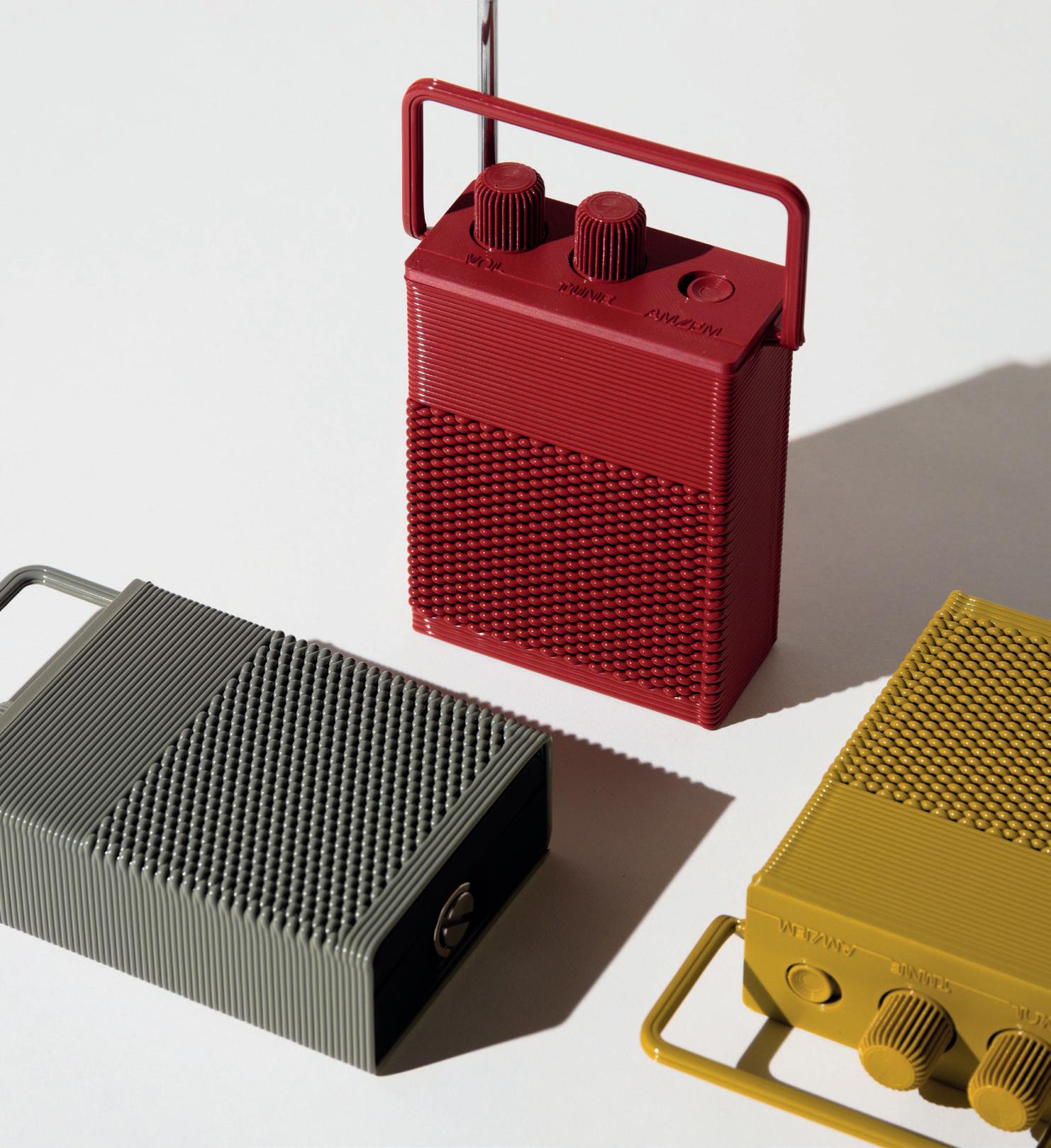
DESIGN ISSUE April 2024 - Year XVIII - www.ifdm.design Photo © courtesy of Shinkogeisha The urban canvas FUORISALONE 12 stories of sustainability FORWARD THINKING Ideas & Inspirations MOODBOARD



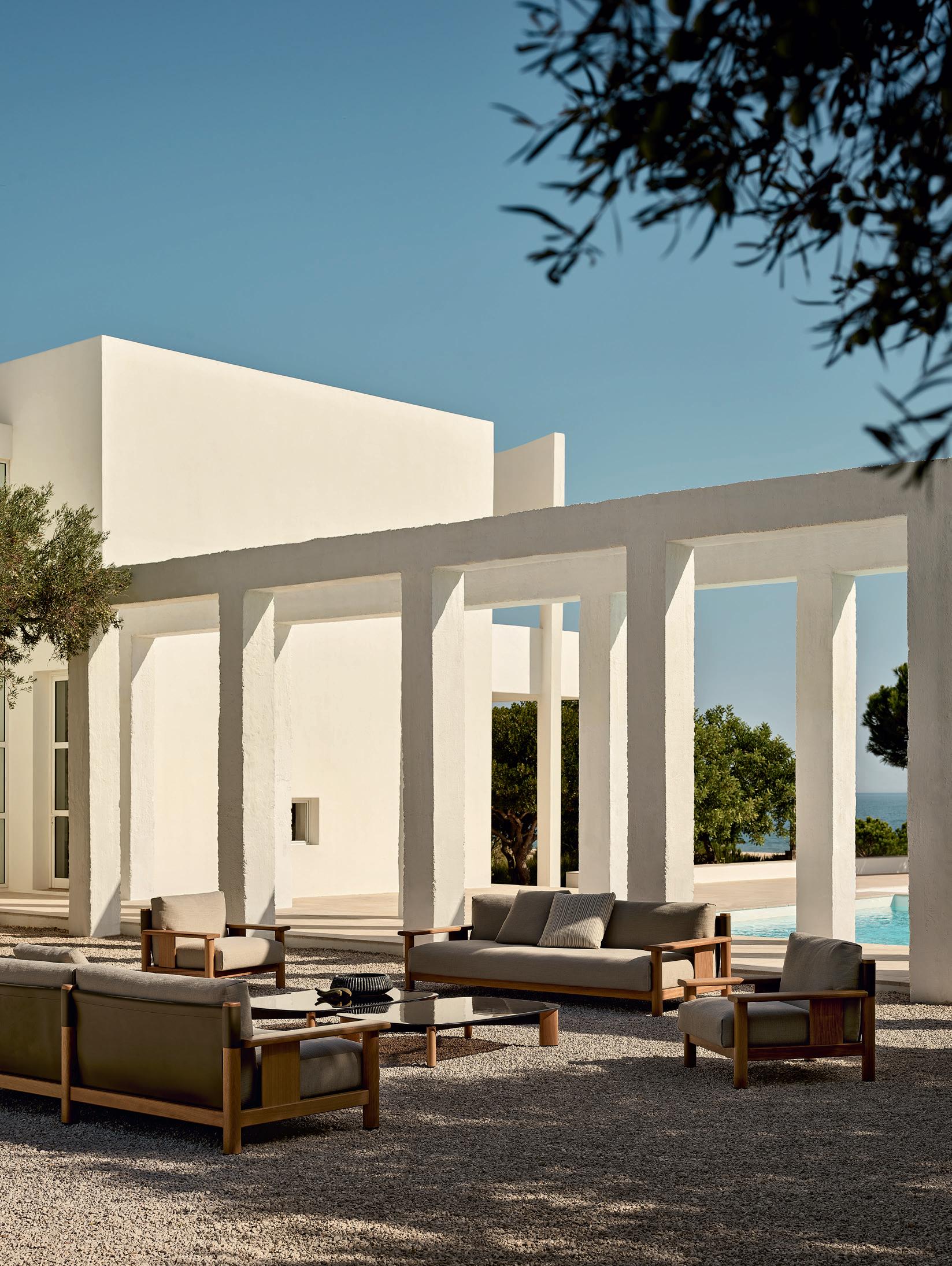
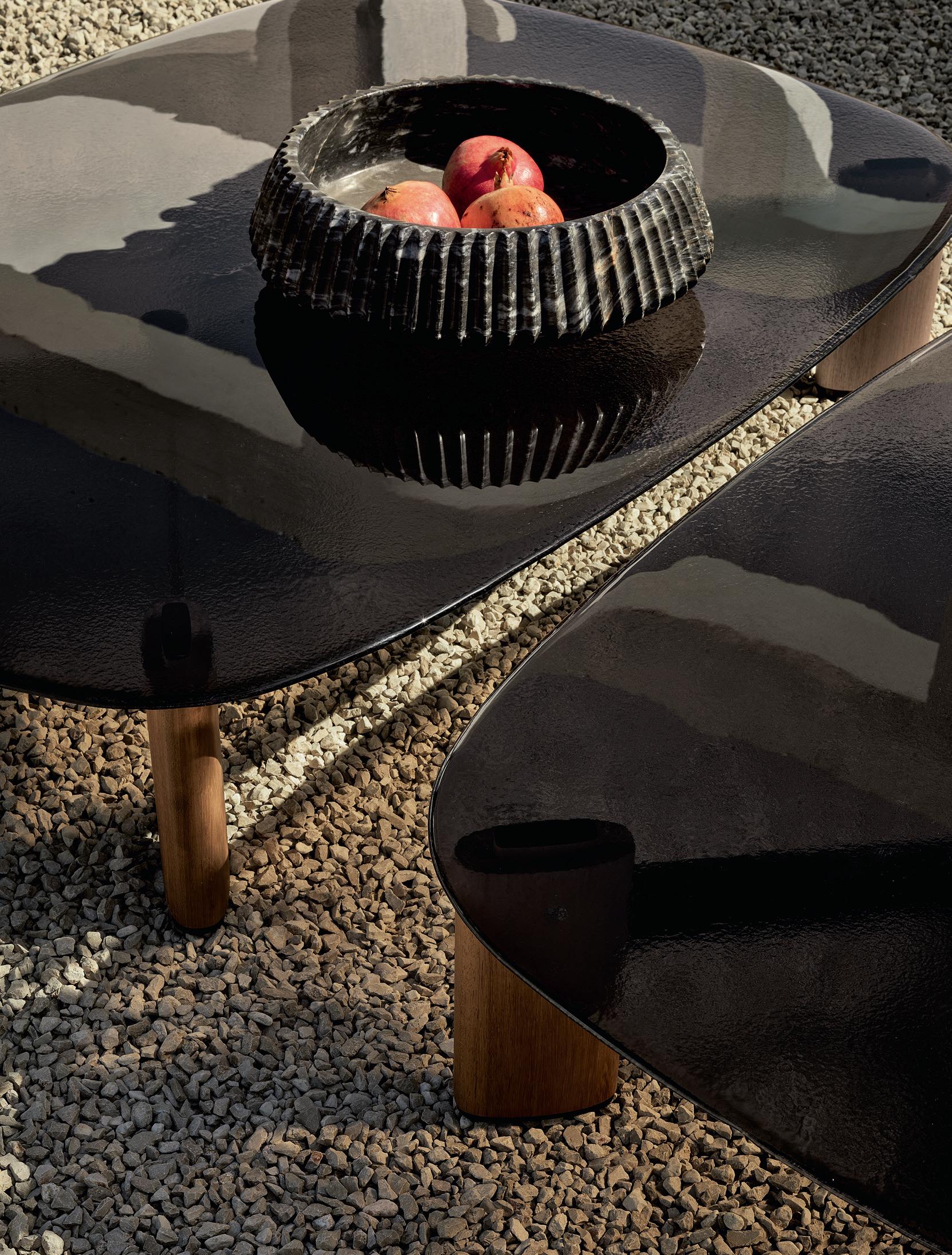
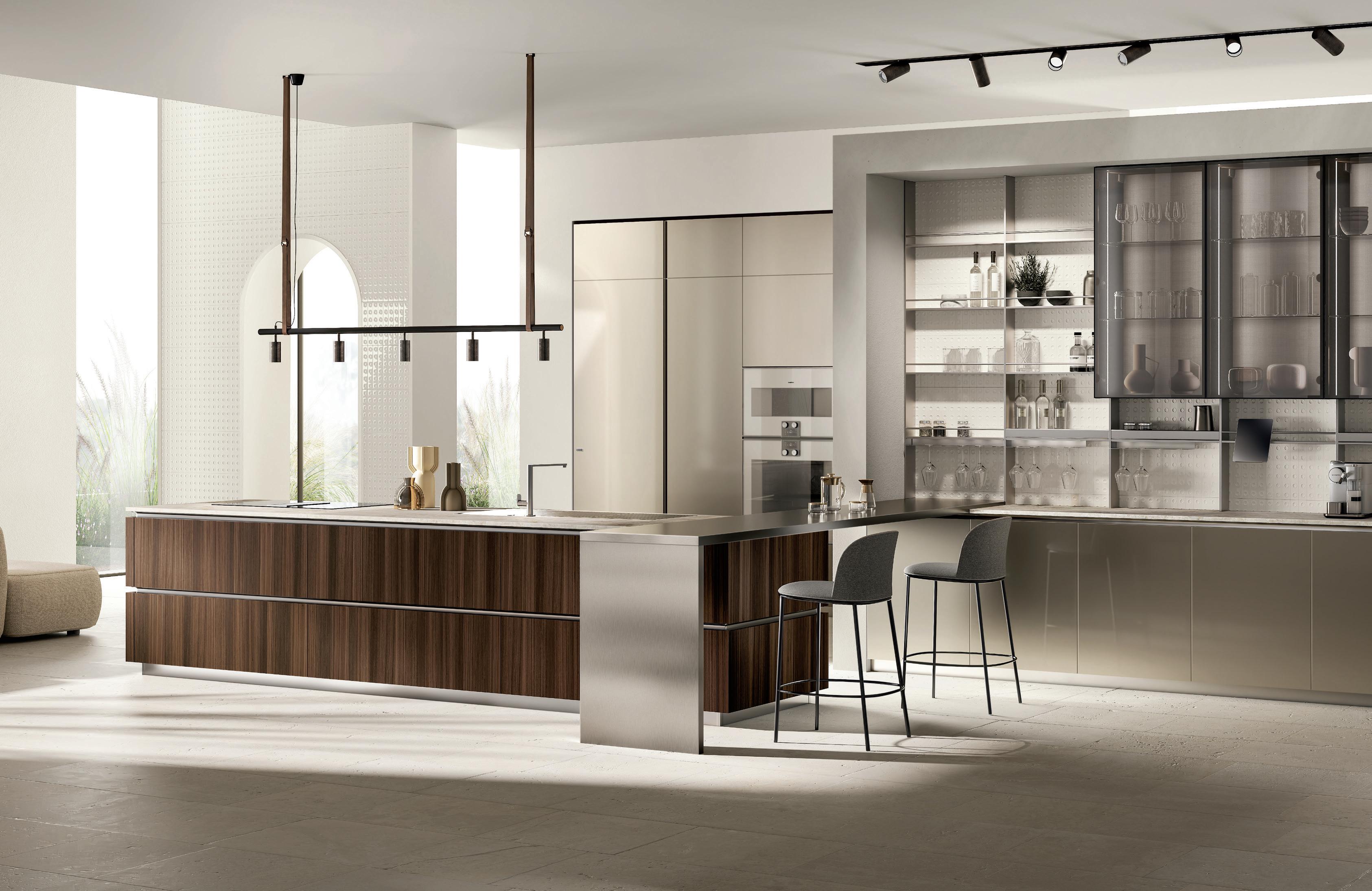

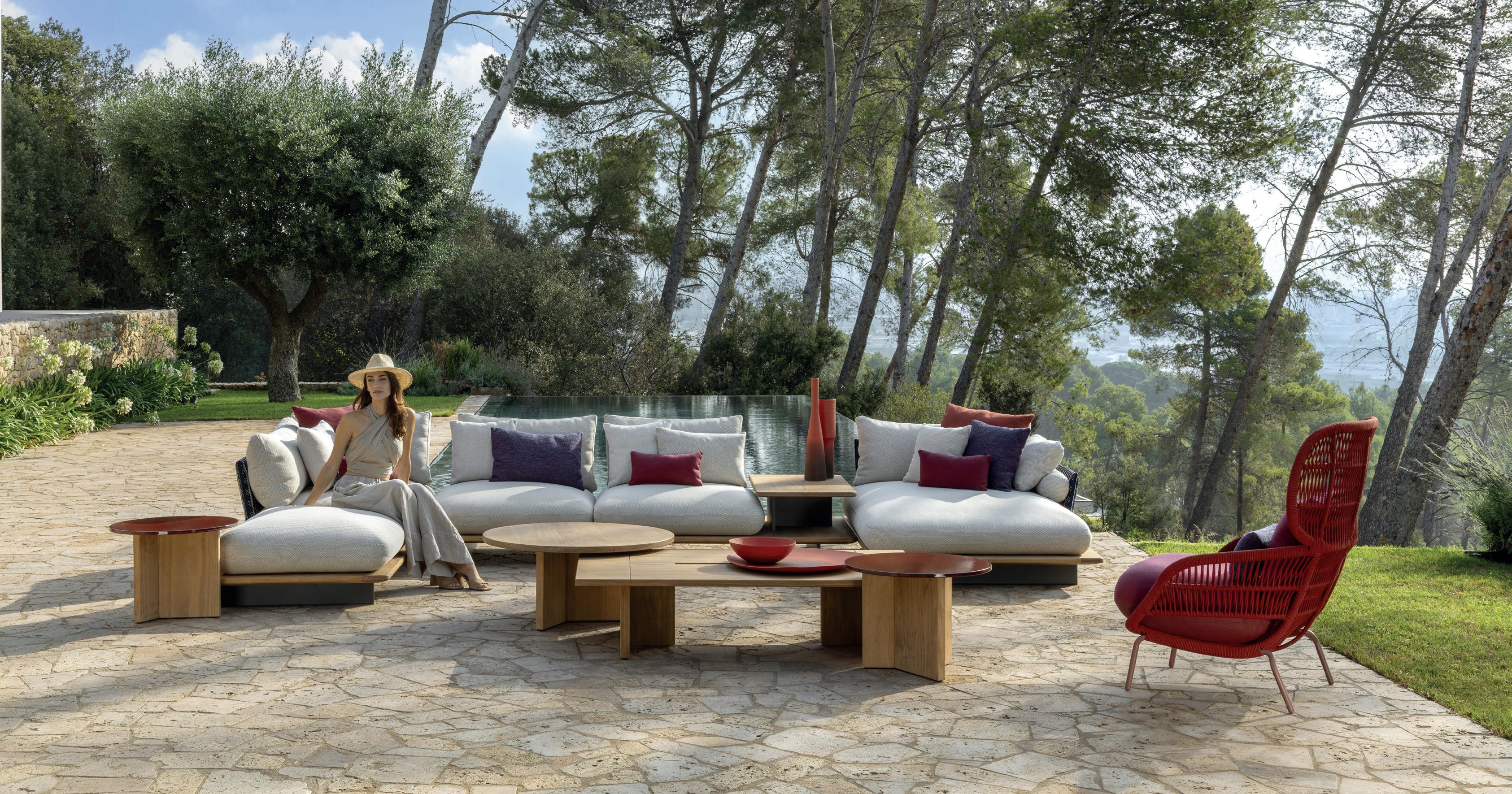
COLLECTION DESIGN BY LUDOVICA
follow us www.talentispa.com customerservice@talentispa.com
VENICE
SERAFINI + ROBERTO PALOMBA



BEYOND THE EYE CAPSULE COLLECTION 2024Design: MIRACLE GARDENDUBAI, finely handknotted in natural silk and New Zealand wool and natural silk relief400x400 cm


SAHRAI.COM
STAND
DISCOVER OUR LATEST INDOOR AND OUTDOOR COLLECTIONS
FUORISALONE 2024 BLUE ICON: VIA A. MANZONI, 38 GEO/LOGIC: VIA A.
MANZONI, 45
HALL 15 -
C19
 Essenzia sideboard | Omega mirror | Ramy lamp | Techwall bookcase | Meghan armchairs | Ring coffee tables
Essenzia sideboard | Omega mirror | Ramy lamp | Techwall bookcase | Meghan armchairs | Ring coffee tables


|
|
RIFLESSI STORE MILANO | BERGAMO | BRESCIA | ROMA
PESCARA
TORINO | NAPOLI | BARI | REGGIO CALABRIA | PALERMO
MILAN DESIGN WEEK | APRIL 15-21 2024 Riflessi Store Milano, P.zza Velasca 6

13 EDITORIAL
See entry for “Design”

18 DELFINO SISTO LEGNANI
Despite not yet having turned 40, Delfino Sisto Legnani is a prominent name in the field of architectural photography
20 BEPPE FINESSI
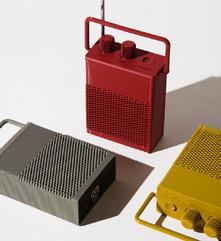
on cover: new design frequencies
Photo © courtesy of Shinkogeisha 3d-printed resin portable radios
Last year he curated the exhibitions inside Euroluce, in a dialogue between art and design. A researcher, curator, architect, professor: meeting with a versatile –and tireless – personality
22 BRIGITTE SILVERA
Director of the Silvera boutiques at Rue du Bac in Paris, part of a design empire that extends to Lyon, Marseille, Bordeaux and London with 16 points of sale. We met her to talk about Milano Design Week: “the most important event of the year for us.”
24 ENRICO MORTEO
A conversation with the architect and co-author – together with Simona Pierini – of Nelle case. Milan Interiors 1928-1978, a maxi-volume (over 700 pages) that narrates the evolution of the domestic landscape in Italy
PUBLISHER
Paolo Bleve bleve@ifdm.it
EDITOR-IN-CHIEF Ruben Modigliani ruben@ifdm.it
IFDM | Il Foglio Del Mobile
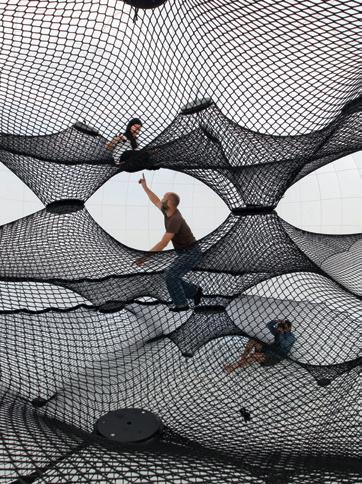
29 MOOD BOARD Ideas & Inspirations
52 CLOSE UP
NEUTRA and Mario Bellini: a revolutionary reissue
55 FOCUS ON Design directions
88 PORTFOLIO
B/W Vision
90 TALENT HUNTER
Marva Griffin: close encounter with the woman who invented the Salone Satellite
92 RISING STARS
New kids on the block
96 DESIGN /LIFE
What is the everyday useful object you appreciate the most, and why?
101 24HOURS IN MILAN
Going beyond
106 FUORI SALONE
The urban canvas
112 DOSSIER
On sustainability
116 TOOLS
Tangible strength

121 SPACES
Orchestration for interiors
130 PLACES
Global luxury retail experiences
132 AGENDA
Save the date. Follow IFDM at the world’s leading international trade fairs
SENIOR EDITOR Giulia Guzzini redazione@ifdm.it
EDITOR-AT-LARGE Veronica Orsi orsi@ifdm.it
CONTRIBUTORS
Laura Barsottini
Alessandra Bergamini
Alessia Delisi
Manuela Di Mari
Umberta Genta
Marina Jonna
Salvatore Peluso
Patrizia Piccinini
Raffaella Serini
EDITORIAL OFFICE redazione@ifdm.it
NEW YORK CONTRIBUTOR
Anna Casotti nyc@ifdm.it
DIGITAL DEPARTMENT web@ifdm.it
SALES & MARKETING DIRECTOR
Dario Rossi marketing@ifdm.it
BRAND RELATIONS
Matteo De Bartolomeis matteo@ifdm.it Camilla Guffanti camilla@ifdm.it
Annalisa Invernizzi annalisa@ifdm.it
GRAPHIC DEPARTMENT
Marco Parisi grafica@ifdm.it
TRANSLATIONS
Miriam Hurley Annabel Little Steven Piccolo
ADVERTISING Ph. +39 02 40701449 info@ifdm.it www.ifdm.design
CLOSED BY THE EDITORIAL STAFF 28th March 2024
PRINTED BY Feanza Group Spa Faenza, Italy
10 | April 2024 FEATURES 102
YEAR XVIII DESIGN ISSUE
All rights reserved. No part of this publication may be reproduced, stored in a retrieval system or transmitted in any form or by any means, electronic, mechanical, photocopying, recording or otherwise, without the prior written permission of the copyright owner. A record and picture file is available at Marble’s. OWNER & PUBLISHER Marble srl HEAD OFFICE & ADMINISTRATION Corso
8 20121 Milano, Italy Ph. +39 02 40701449 www.ifdm.design
Venezia
Laboratory of the future 12 stories of sustainability Ideas & Inspirations
52 70 114
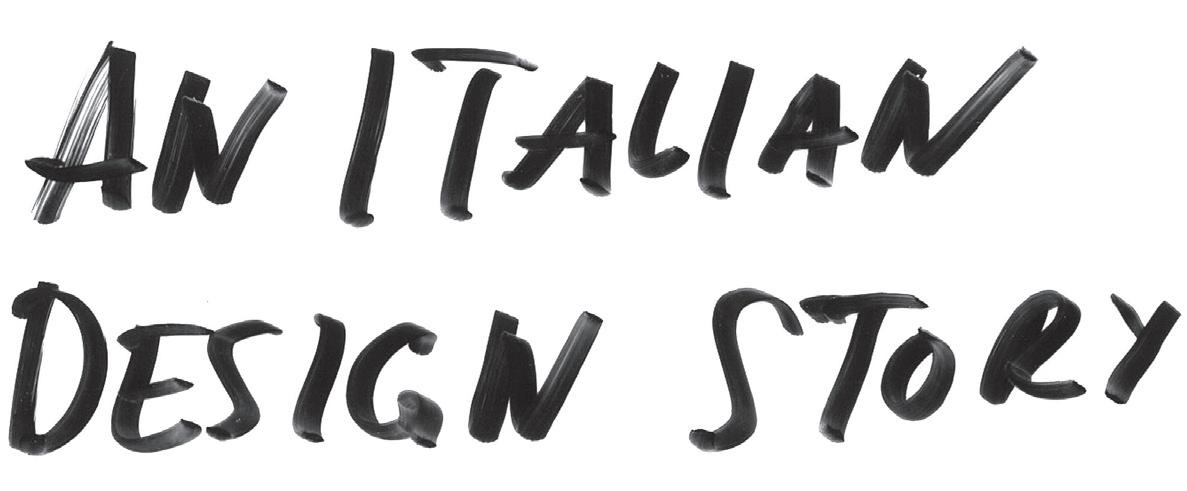
 D.154.2 ARMCHAIR GIO PONTI
D.154.2 ARMCHAIR GIO PONTI


See entry for “Design”
1. the way something has been made: the way the parts of something (such as a building, machine, book, etc.) are formed and arranged for a particular use, effect, etc.
2. the process of planning how something will look, happen, be made, etc.: the process of designing something.
These are the first two definitions that The Britannica Dictionary gives for the word “design”. The two aspects are closely linked, and both - aside from what may be the aesthetic trends of the moment - are two of the key protagonists of Milan Design Week, a major global event both in terms of business generated and as a laboratory of ideas.
We could say that what emerges from the thousands of previews - by companies, schools, individual designers, from the famous to the up-and-coming - that we have examined is that we will see a lot of green in relaxing shades, many rounded forms and a return to some of the great classics that have come onto the market. But it is worth going deeper.
What we are witnessing is a continuous evolution of processes that are both upstream and downstream in the production of furniture: such as managing inventories or logistics, how to reduce the carbon footprint of an object, how to get as close as possible to mass customisation. New forms of collaboration, of communication, of use of materials are established. New professions are born. This is what made us to put an “antique” object on the cover, a radio but one made from recycled plastic using 3D printing. Because in the end design (2nd definition) is also about giving form to ideas. And these from Milan are spread around the world.
RUBEN MODIGLIANI | Editor-in-Chief

For us, an online/print platform dedicated to the world of design and products, the Salone is a formidable window onto the market and what it has to offer. So it is also to describe this movement that we have decided to add to our programme a new edition of the .Wonder Book, a collectible print publication, dedicated precisely to the existing relationship between architecture and furniture, conceived as an extensive collection of pieces able to inspire the reader. Including a depiction through images of Milan Design Week. An event that lasts seven days but this is an arbitrary limit - because in reality it is the expression of a world that never stops.
EDITORIAL
Valentina Sommariva June 2022 | 13
Design week starts here.
Don’t miss Material Bank brand partners. Discover their new collections and start sampling for free on Material Bank.
46 47 48 49 46 47 48
Brand partners exhibiting at Salone del Mobile
Atlas Concorde
Bencore
Cimento
Cosentino
Decor Walther
Devon&Devon
Dickson Woven Flooring
Durat
Ethnicraft
Expormim
Fantoni
Florim - Cedit
Infinity Surfaces
Instabilelab
Isimar Kriskadecor
Laminam
Philips MyCreation Porcelanosa
Radici Carpet
RS Barcelona Tabu
Theia Tiles
Vismaravetro
Wall&decò
Warli
Brand partners at Material Home Elle Decor Exhibition
Almeco Group
Antolini
Emboss Panels
Oberflex
Omnidecor Glass Design Piatraonline
Polygood Luce di Carrara
Materica Santa Margherita Tabu Wood-Skin
Brand partners with a presence in the city
Agglotech Via S. Marco 2
Antolini Piazza Fontana &, Via S. Clemente
Arpa / Fenix Via Quintino Sella 1
Atlas Concorde Via San Marco 12
CAP Arreghini Via Gastone Pisoni 6
Ceramica Rondine Corso Buenos Aires 25
Ceramica Sant’Agostino Corso Garibaldi 95
Cimento Via Borgogna 7
Cosentino Piazza Fontana 6
Devon&Devon Via San Marco 38
Durat Via Vittorio Emanuele II 48
Emboss Panels
Piazza Gae Aulenti 1
Fantoni Via Solferino 28
Fioranese / Coem Via Goito 7
Fischbacher 1819 Via del Carmine 9
Florim - Cedit Foro Buonaparte 14
Forma & Cemento Via Enrico Toti 2
HTW Design Carpet, MyDiTex Corso Magenta 24
Iris Ceramica Via Santa Margherita 4
Karpeta / Texturae Via Cappuccio 18
LaCividina Via Alessandro Manzoni 41
Laminam Via Giuseppe Verdi 5
Lapitec Sintered Stone Piazza Cordusio
Lechler Tech Via Tortona 14
LondonArt
Piazza S. Marco 4
Marazzi Via Borgogna 2
Mirage Via Marsala 7
Modulyss Via Tortona 31
Moroso Via Pontaccio 8
Murals Via Tortona 27
Noël & Marquet Via Tortona 37
Novacolor Corso Garibaldi 91
OmniDecor Glass Design Via Cerva 23
Philips MyCreation
Piazza dei Mercanti 2
Unilin Panels
Piazza dei Mercanti 2
Porcelanosa Piazza Castello 19
Ralph Lauren Home Via Alessandro Manzoni 30
Poltrona Frau Via Alessandro Manzoni 30
San Marco Piazza S. Marco 1
Slalom Acoustics Via Gioacchino Rossini 3
Spaghetti Wall Via Cino del Duca 2
Stepevi Via dell'Orso 9
Tabu Via Melone 2
Theia Tiles Via Tortona 31
A reschi & A reschi Via Tortona 31
Villeroy & Boch Foro Buonaparte 7
Vismaravetro Via Crocefisso 27
Wall&decò Via Laura Solera Mantegazza 7
Warli Via Morimondo 26
Wood-Skin Via Marcantonio dal Re 24
Zambaiti Parati Corso Garibaldi 46
Loloey LondonArt Marazzi
Nanimarquina Orac
01 02 03 04 05 06 07 08 09 10 11 12 13 14 15 16 17 18 19 20 21 22 23 24 25 26 27 28 29 30 31 32 33 34 35 36 37 38 39 40 41 42 43 44 45 46 47 48

VOICES
18 DELFINO SISTO LEGNANI
Despite not yet having turned 40, Delfino Sisto Legnani is a prominent name in the field of architectural photography
20 BEPPE FINESSI
Last year he curated the exhibitions inside Euroluce, in a dialogue between art and design. A researcher, curator, architect, professor: meeting with a versatile –and tireless – personality
22 BRIGITTE SILVERA
Director of the Silvera boutiques at Rue du Bac in Paris, part of a design empire that extends to Lyon, Marseille, Bordeaux and London with 16 points of sale. We met her to talk about Milano Design Week: “the most important event of the year for us.”
24 ENRICO MORTEO
A conversation with the architect and co-author – together with Simona Pierini – of Nelle case. Milan Interiors 1928-1978, a maxi-volume (over 700 pages) that narrates the evolution of the domestic landscape in Italy
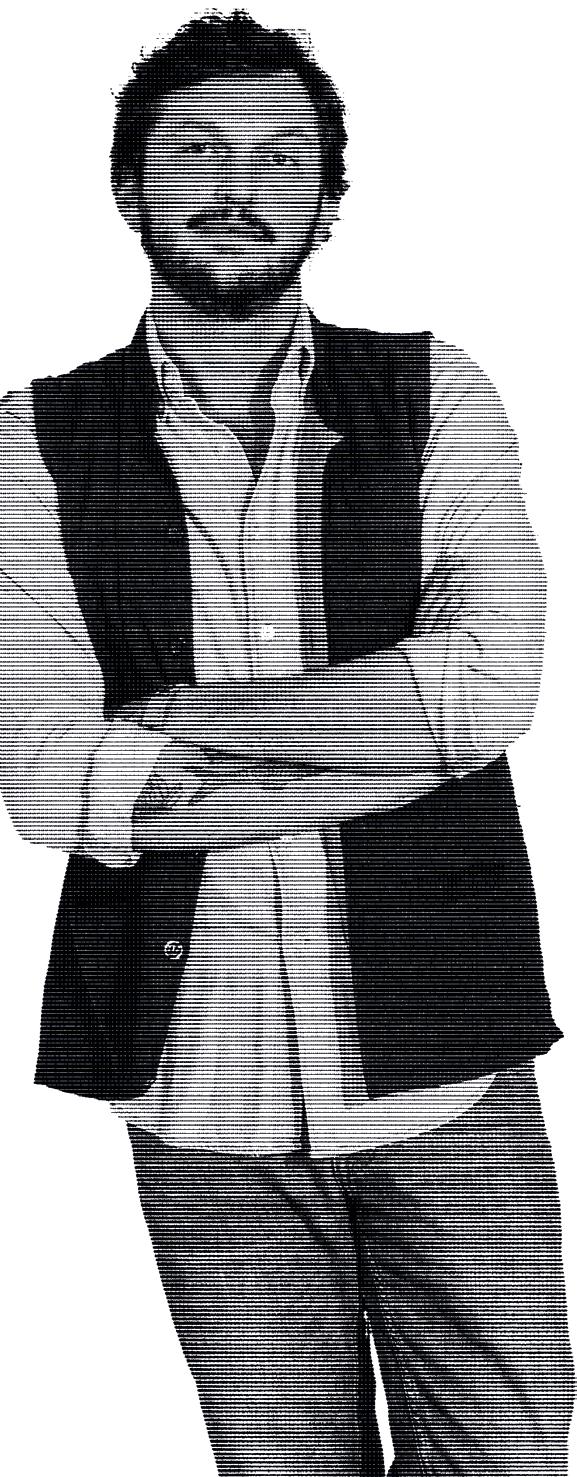

Delfino Sisto Legnani
Despite not yet having turned 40, Delfino Sisto Legnani is a prominent name in the field of architectural photography. Described as a “tireless inventor of projects”, Legnani has not limited his creativity to photography and in our conversation, he shares the engine that drives him to constantly search for new ideas and take on new projects
by Giulia Guzzini
What has photography been for you?
While I was at university, it was a tool for representing projects that I was studying. Then, through Ramak Fazel, I discovered that it could be a profession. I was working in an architecture studio then I met Ramak and from next day onwards I never went back. I realised that photography could be a medium for exploring reality that interested me. I owe him a lot. Most of all he taught me an attitude to gentleness that was perhaps innate in me. I discovered that there also exists a way of working that is soft and sensitive, in which one guides the client towards certain choices.
As well as your photography studio, you have founded an art space, MEGA, a publishing house, a herbal infusion company and NM3, a furniture company and design studio with Nicolò Ornaghi and Francesco Zorzi. What drives you to seek out new ideas? Curiosity, coupled with a certain restlessness, has always accompanied me. The former underpins my approach to life, the latter is an inescapable condition. I am a great absorber of non-fiction literature. I am curious to see how my point of view of the world encounters that of the others. During the time when I was getting into photography, my father died and I threw myself into my work. It was a way of surviving. Throwing myself into work was a way of making up for the lack of a proper family. Over the years, then, I have found more than just work, and I tried to dismantle this system based on filling oneself with things to do.
This idea of an extended family is a constant: in your work groups we can glimpse this ability to connect and create community.
It’s true, my creative process passes a lot through others. I think that one of my qualities is being able to bring out the best in others. DSL is a horizontal studio were we practice our work collaboratively, a tried-and-tested machine that
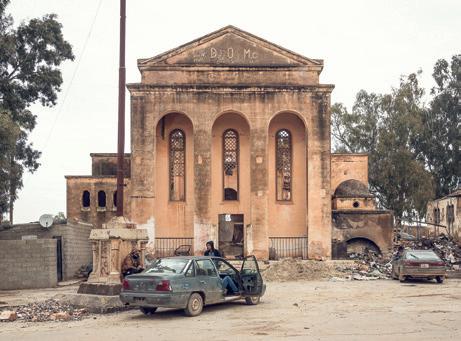
can take on huge projects. We are able to manage ‘impossible’ jobs in terms of timing and quantity of work thanks to collaboration with seven professionals, all pulling in the same direction. By doing things like this we manage to do a lot of research on individual projects, raising the quality of what we do. The exchange of opinions internally allows us to always ask the questions necessary for producing quality work. On the one hand there is a a lot of intuition but there is also a large amount of participated shared design.
You touched on an important point, describing the process that is found in you being a photographer, publisher, gallery owner, designer. Do you think that being an architect is the hallmark of your approach to design?
Experiences in university, then in an architecture practice, then in the editorial team at Domus trained me to have great respect for delivery deadlines and the needs of the client. My process starts with a great curiosity that begins with synthesis, passes through rigour and arrives in the end to functionality. My approach is based on synthesis: it is an attempt to abstract from the complexity of the real in order to produce simple but articulated images based on my unique point of view. This is found in the design shared with my partners at NM3, where, both in communication and in design, indeed, a great rigor and an even more radical way of working emerge.
What do you ask of the objects you design?
Our objects have no ideological charge and we like them to speak for themselves. Our products say nothing other than themselves. Everything we design responds to principles of functionality, rigour and sustainability.
1 NM3, 2022. 2. Libia, 2012. 3. Citroën 100th anniversary, 2019.

18 | April 2024 VOICES
Delfino Sisto Legnani
Read the full interview online 3 1 2
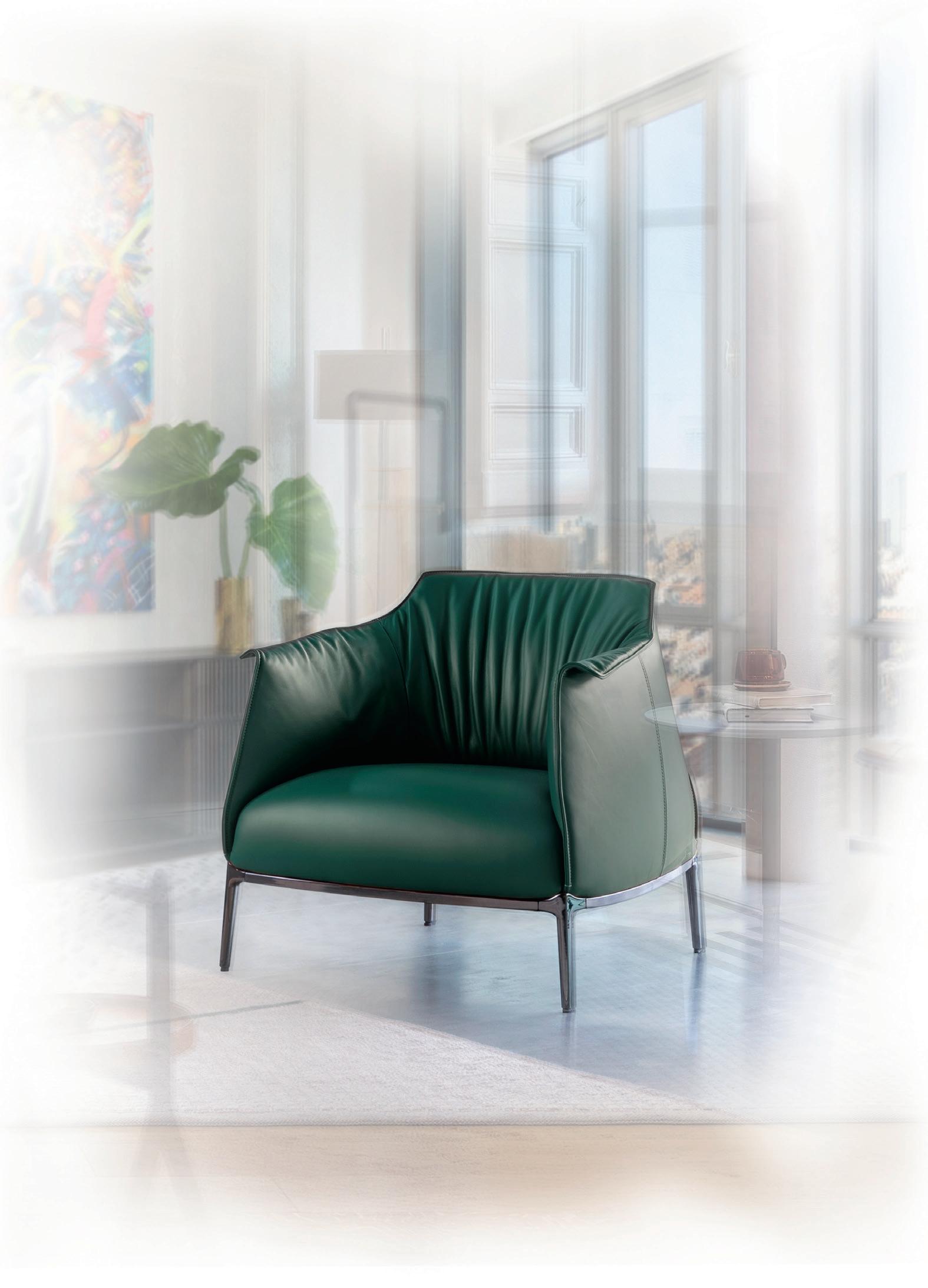


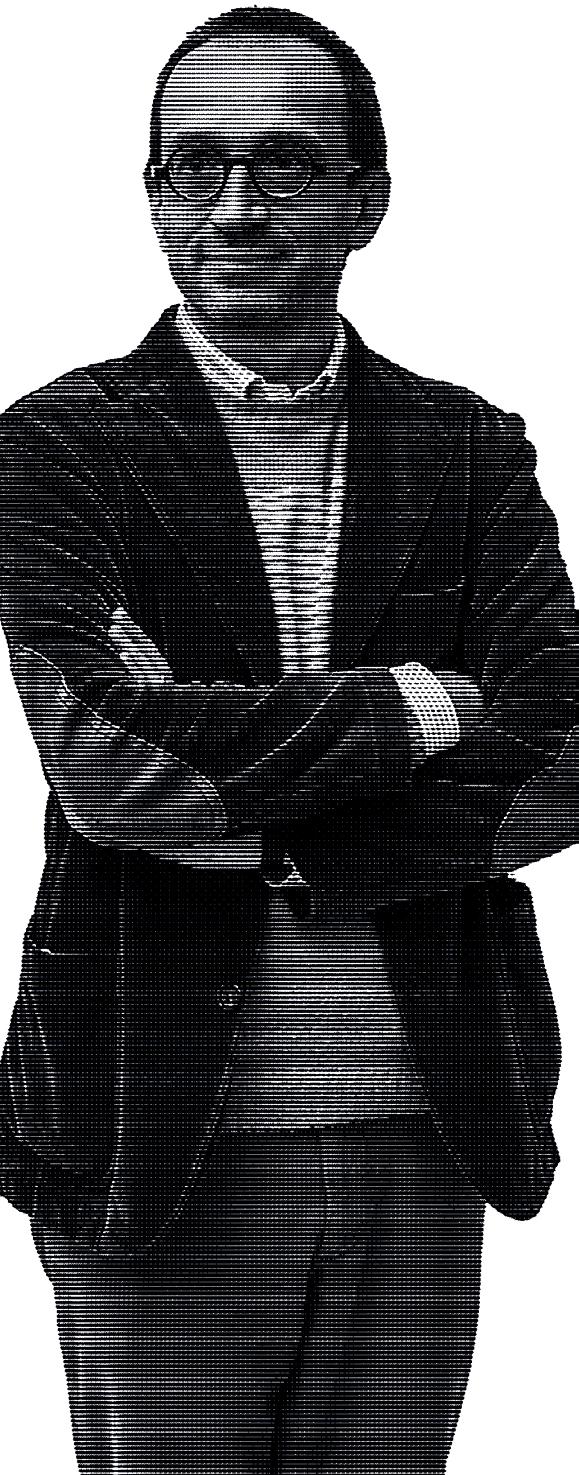
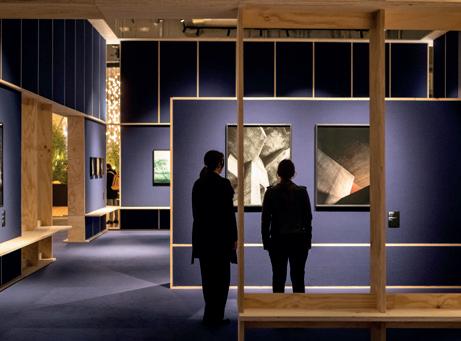
Beppe Finessi
Last year he curated the exhibitions inside Euroluce, in a dialogue between art and design. A researcher, curator, architect, professor: meeting with a versatile –and tireless – personality
by Ruben Modigliani
Your Wikipedia entry says you are “an architect and scholar who conducts activities of teaching, criticism and research.” Which term represents you best? Am I really in Wikipedia? I didn’t know. I am first of all a university professor. All the rest of these activities are done to offer my students original, contemporary contents for research. This does not mean that I work on publications, books or other things because I have portions of free time to consume. But the heart of my work is teaching. Everything else is a way to continue to be informed, to continue to bring my students original materials.
Last year you brought exhibitions into Euroluce, also with some important art pieces. What is the borderline, in your view, that separates art from design?
In the past everything was relatively simple in theoretical terms: art had to make us think, to provoke us and amaze us. Design, on the other hand, had to perform a function. Two different disciplines, though certainly interrelated. But from Meret Oppenheim onward (the artist who in 1939 designed the Traccia table, an oval top on two bird legs, now in the Cassina catalogue, ed.) many short circuits began to happen. Italian history has been made by creators who by nature were crossovers, personalities that cannot be limited to architecture, writing, photography: Munari, Balla, Depero, Mendini... Then things got even more mixed up: just consider the beautiful lamps by Michael Anastassiades, the greatest innovator of recent years: had it not been for the acceptance that brought an artist like Cerith Wyn Evans into the world of lighting, he might not have been able to make them. For Euroluce we started with the new layout created by Lombardini22, a project of urbanism, in a certain sense. I thought about historical cities, full of art, where something happens at every turn, and I proposed doing the same thing, bringing into these renewed pavilions happenings that would be capable of capturing attention, making them more multidisciplinary, multicentric.
How did you first get interested in design?
It was immediate. My father had a small business, he made furniture, architects often came to our house and there was talk about décor culture. The first important encounter was with Munari. Then came other mentors: Corrado Levi, who supervised my thesis. Then Italo Lupi: one day, after graduating, I called the editorial offices of Abitare and asked for him, though I didn’t know him. They put him on the line and he invited me to go and see him. I obtained the possibility of writing an article, and that was the start of a

long collaboration, which came to an end when he stepped down as editor of the magazine.
How did this collaboration take shape?
I focused on something I have always done, since my youth: gathering material on everything that interested me and sorting it into folders. There was no Internet back then, they were real folders into which I put photocopies, magazine clippings, images. Each one became a sort of atlas for one idea, one concept. And I always looked for categories that were not necessarily established, unusual viewpoints. For Lupi, I proposed doing articles on these themes, these small inventories. When I left Abitare I began to think about a new object, and in the meantime I organized exhibitions and other things. Then I met Foscarini and the project Inventario, an atlas of atlases, was born (a bookzine on a variable schedule, ranging from half yearly to bi-yearly, founded in 2010, published by Corraini and sponsored by Foscarini). It is also made of many things I assign to my students: some of the articles, already in the first issue, were their degree theses. Articles about swings, the wind, the rain. Those first articles done with Italo made me think that these things could have their own value.
When Inventario won the Compasso d’Oro award – and few magazines have done so – what did that mean to you? I received an email, I read it, and I couldn’t connect the two things, the magazine and the prize. Then we made some phone calls, with Foscarini and Corraini, and of course we were very happy indeed. We were in good company: Domus, Ottagono, L’Arca with the graphic design by Gianfranco Iliprandi. The part I liked best was the fact that we did it without following dictates of marketing, following our own preferences.
Are there any other projects in which you are particularly interested at the moment?
Of course, there are many. I would like to move forward with all the things I’m doing: something about my teacher, Corrado Levi, on which I’ve been working for some time now, and lots of other things.
Some of the exhibitions curated by Finessi for Euroluce 2023. 1. The retrospective dedicated to the architectural photographer Hélène Binet. 2. Fiat Bulb. La sindrome di Edison, auteur variations on the theme of the light bulb. 3. The setting of Interno notte. Artifici luminosi
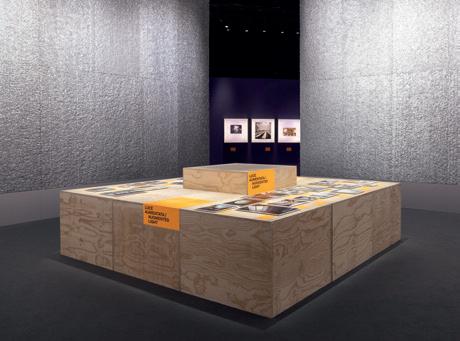
20 | April 2024 VOICES Read the full interview online
Andrea Mariani, Diego Ravier
2 3 1
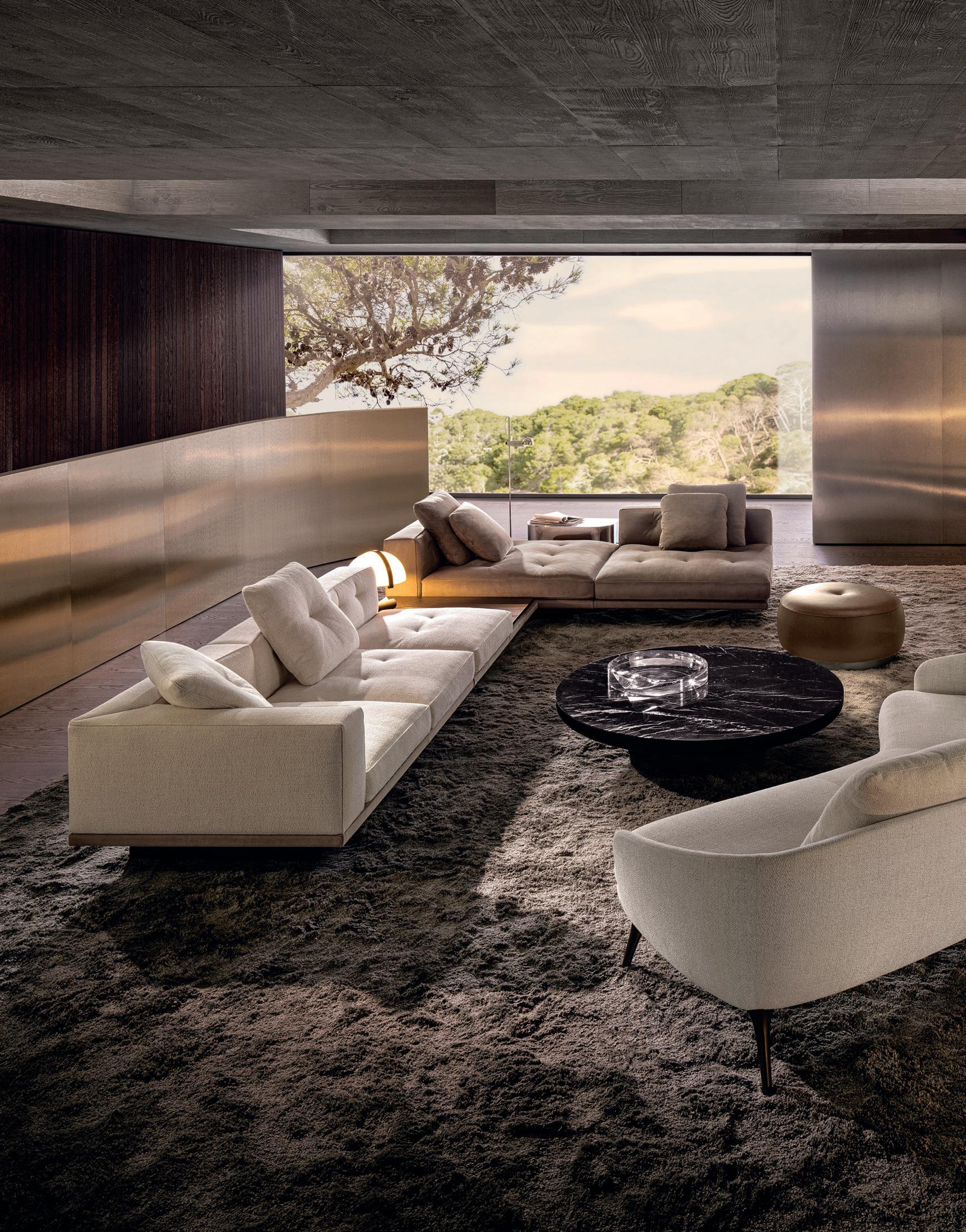

SISTEMA DI SEDUTE DYLAN | DESIGN RODOLFO DORDONI DIVANO RAPHAEL | DESIGN GAMFRATESI DISCOVER MORE AT MINOTTI.COM/DYLAN
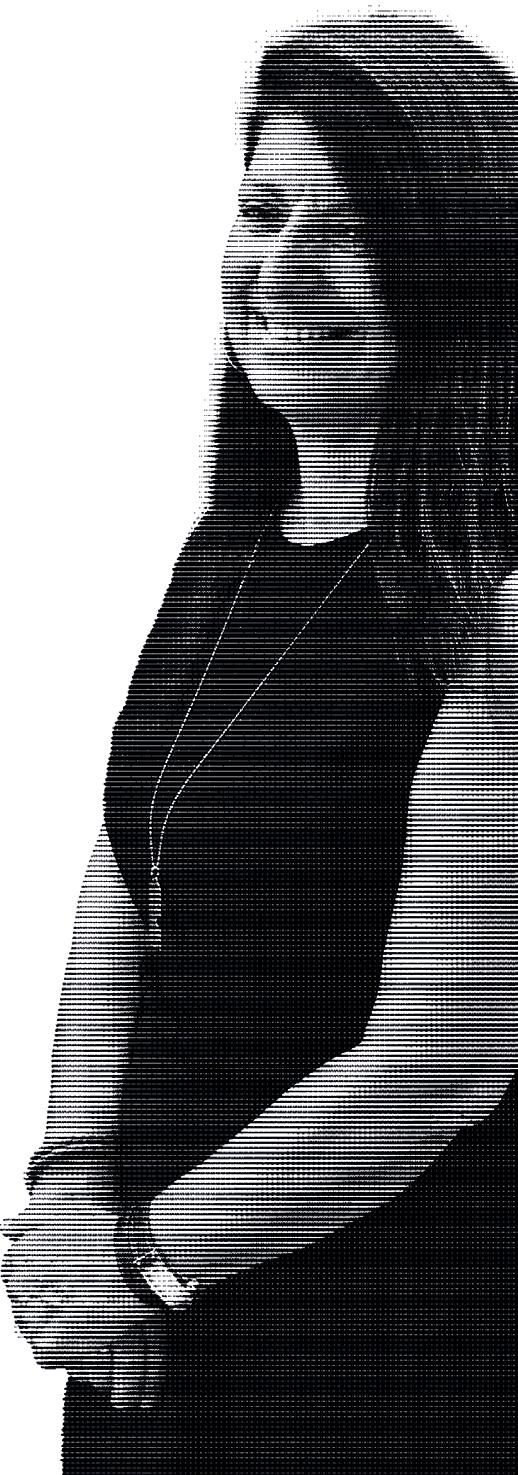

Brigitte Silvera
Brigitte Silvera is the director of the Silvera boutiques at Rue du Bac in Paris, part of a design empire that extends to Lyon, Marseille, Bordeaux and London with 16 points of sale. We met her to talk about Milano Design Week: “the most important event of the year for us.”
by Umberta Genta
Milano Design Week is just around the corner. What is the role of Milan in the worldwide design system? Coming to Milan and visiting the Salone del Mobile is essential for us. The entire range of premium design brands we offer in our stores is concentrated here: from Poliform to Minotti, Flexform to Baxter and Living Divani. About 80% of the brands belong to Made in Italy; then there are our Scandinavian brands like Gubi, &Tradition, Carl Hansen. With respect to other events, such as Maison&Objet, for example, which range towards other worlds, Milan is truly about furniture. The Salone is the main opportunity to meet our brands, and we are happy to observe the full impact of their creativity.
Besides the fair, will you also visit the city?
Since we have just a few days, the fair remains essential for a complete overview of all the collections. But we will undoubtedly also follow the activities of our brands in the city, where extraordinary things happen. In this way, we can discover not only the products but also amazing buildings or places that could not be seen otherwise.
Do you have a particular memory of previous editions? Last year there was the exhibition by Gubi in the splendid context of the Bagni Misteriosi, and then the presentation of the first outdoor collection by Poliform, displayed on the black gravel of the 15th-century cloisters of San Simpliciano.
In your view, what are the less successful aspects of Milano Design Week?
For me it is all quite positive; perhaps there should be a greater focus on places not to be missed and the best events outside the fair, for people who don’t have much time.
Today Silvera has 12 points of sale in Paris, two in Marseille, two in Lyon, one in Bordeaux and one in London. What is the main ingredient behind all this success? And how did the idea of the opening in London come about?
I think it is fundamental to devote time to clients, offering advice and a diversified selection. The French, like the Italians, like to live in spaces that express character, personalization, not like a cut and paste version of a magazine ad.

Our typical clients are also fans of flea markets, and they love to discover new talents. We open a door for them so they can explore a mixture of different brands, by famous creators or less well-known designers. Through our e-shop we offer the more affordable brands that are not always on view in the store, but still offer interesting design. This enables our customers to set a budget for the main feature, and then indulge themselves with more affordable pieces. The choice of opening in London was not guided by rational motives: a member of our team wanted to explore the city, and convinced us to do it.
Silvera is also a maker of design editions, as in the case of the pieces designed for you by Sam Baron: where does this idea come from, and will it lead to new creations? In Sam’s case, we realized that among our offerings we were lacking consoles: we like his work very much, so we decided to ask him. We have also collaborated with Coedition, a French producer of editions. But we represent so many brands that it is difficult to launch our own editions: that is a different profession.
How has your public changed since the founding of Silvera? We still have a strong presence of clients in the 7th and 16th arrondissements, and we still work often with developers and architects. Nevertheless, and I notice this especially with Poliform, the clientele that once was made up of design lovers who wanted to invest in high-quality furniture is now a minority with respect to customers who with the evolution of the economy, and especially in the wake of the pandemic, have high buying power and are willing to spend, but do not necessarily have much knowledge or interest in the field of design. These people often look for external advice, to help them make their decisions. Personally I think this trend is rather a shame.
Some of the Silvera stores in France and the United Kingdom. 1 The Bordeaux showroom is located in a 19th century mansion with a garden in the heart of the city. 2 The London store, Silvera’s first expansion outside France. 3 The three-storey Silvera showroom on rue du Bac in the Saint-Germain district, Paris.
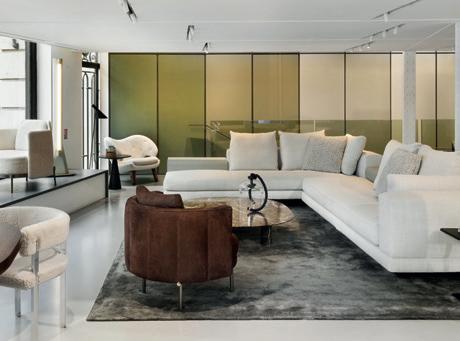
22 | April 2024 VOICES
2 3
Read the full interview online 1 C M Y CM MY CY CMY K Cecile Perrinet Lhermitte



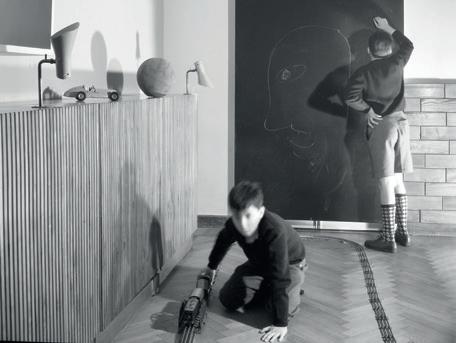
Enrico Morteo
A conversation with the architect and co-author – together with Simona Pierini – of Nelle case. Milan Interiors 1928-1978, a maxi-volume (over 700 pages) that narrates the evolution of the domestic landscape in Italy
by Salvatore Peluso
What is Nelle case. Milan interiors 1928-1978 and why was it needed?
Nelle Case offers a wide overview of the evolution of housing, and – between the lines – of Italians and Italy. The time span covers 50 years that were very important, from the late 1920s to the assassination of Aldo Moro, i.e. 1978. The book was triggered by a request on the part of the publisher, a rather rare case on the Italian scene. Hoepli has a tradition of books about Milan, its culture and also its architecture. This volume is the sequel to another publication edited by Simona Pierini [co-author of the book, ed.] titled Case Milanesi. At the time of a presentation I had organized for that book, the idea arose to do another one on interiors, as a natural way of completing the overview.
How did you represent the projects?
What makes the coverage of the interiors difficult is their heterogeneity. Houses are complicated by their inhabitants, with their fantasies, fears, collections, desires. Simona Pierini was correct in identifying the plan as the constant that would permit comparison among all the residences analyzed. Through archival images, on the other hand, we have tried to metaphorically walk inside the houses, noticing their essential characteristics. The system of profiles, the systematic use of the plan and the chronological ordering of the projects have allowed us to be clear and orderly. In the texts, instead, we have attempted to identify the particular aspects, the recurring themes, the questions shared by certain projects, ways of living. We attempt to define the urgent issues to which the projects had to respond.
Can you indicate a particular character (or, more precisely, a shared approach or position) that brings the various projects together?
The unique quality of Italian houses comes from the partial character of Italian culture’s adherence – in terms of design, but also in other areas – to the dogmas that had pushed the rest of the European countries towards a more rationalist, harder, more functional modernity. Gio Ponti states this
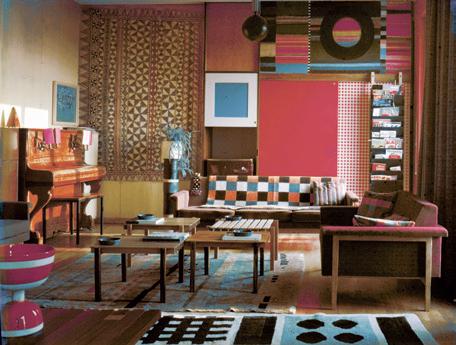
clearly in the editorial of the first issue of Domus, in 1928: “The Italian House is not the padded and equipped refuge of the inhabitants against the harsh climate (…) Its design does not come only from the material needs of living. It is not just a ‘machine á habiter.’ Its ‘comfort’ lies in something higher: with its architecture, it is giving us a measure for our own thoughts … which consists in the full sense of the beautiful Italian word, CONFORTO (consolation).”
Why does the book come to an end just before the 1980s?
The modern era was a time of permanent new developments in which we see a constant demand for new ways of producing, living, being in the world, making the house, the city. Italian design in those years made a great effort to tame this entire production of newness, shifting it into a new cultural dimension. At a certain point this acceleration decreased somewhat. We found ourselves with a very wide-ranging heritage of new experimental models. Therefore we began to pick them up, to put them away, to polish them, to make them more polite, less strange, but also less experimental and innovative.
So we will not be seeing a Part 2 in a few years (perhaps over the time span 1978-2028).
The period we have analyzed came before the start of my professional activity. In 1978 I was still in college. For a book on the next 50 years, I would like it to be made by someone who is in school now, who will be able to look back over the decades with a critical gaze. Not the gaze of someone who has had the experience, but the gaze of the next generation, people who have absorbed that history without truly being a part of it. History needs to have a minimum of distance.
1 Vittoriano Viganò, Casa Sarfatti, 1953 IUAV – Archivio Casali. 2 Ettore Sottsass, Casa Sottsass Pivano, 1957 IUAV – Archivio Casali. 3 Ignazio Gardella, Casa Gardella ai Giardini d’Ercole, 1954 IUAV – Archivio Casali
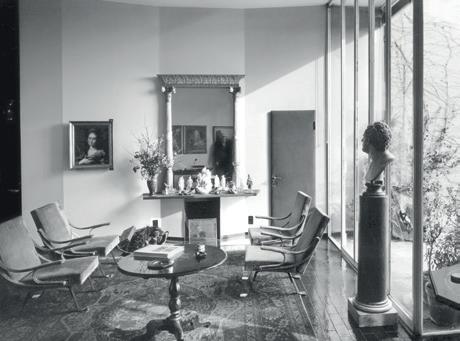
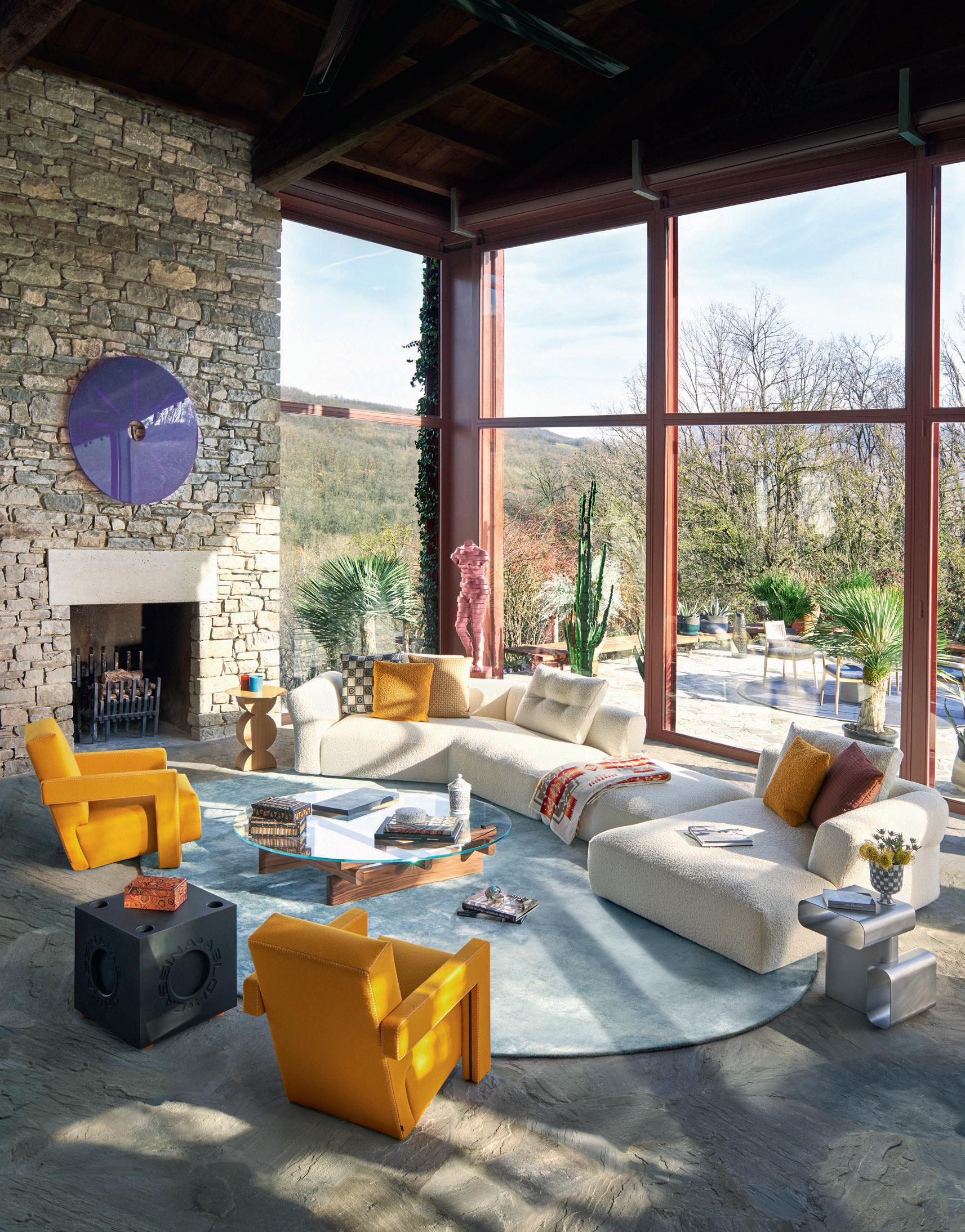
24 | April 2024 VOICES
Read the full interview online 2 3 1


DESIGN
29 MOOD BOARD Ideas & Inspirations
52 CLOSE UP NEUTRA and Mario Bellini: a revolutionary reissue
55 FOCUS ON Design directions
88 PORTFOLIO B/W Vision
90 TALENT HUNTER Marva Griffin: close encounter with the woman who invented the Salone Satellite
92 RISING STARS New kids on the block
96 DESIGN /LIFE
What is the everyday useful object you appreciate the most, and why?
101 24HOURS IN MILAN Going beyond
106 FUORI SALONE The urban canvas
112 DOSSIER On sustainability
116 TOOLS Tangible strength
Milan | April 15-21, 2024
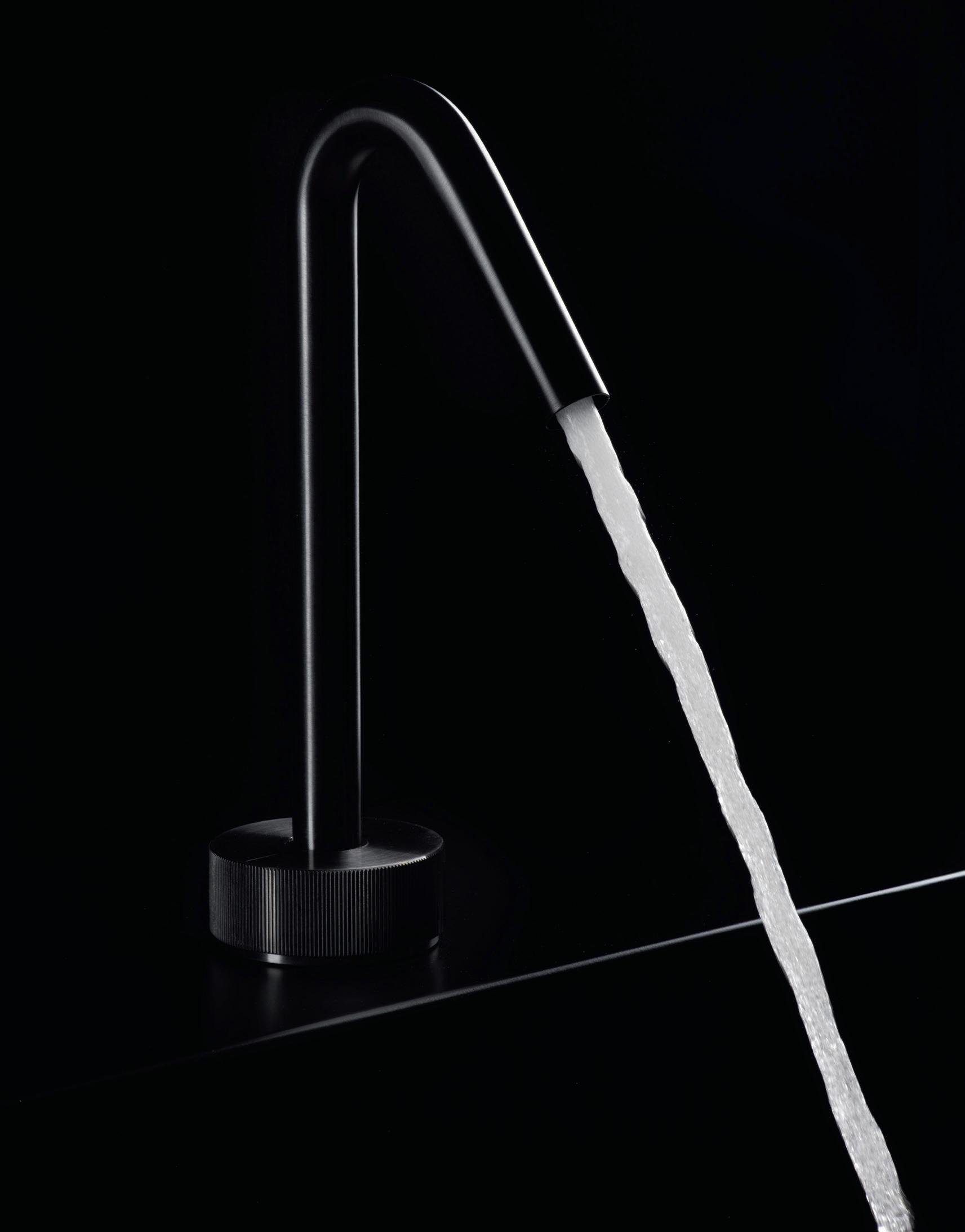

FuoriSalone2024
Via San Marco 38 Brera Design District amphoradesign.it
image centro fotograficovisiva graphic design
DESIGN STUDIOADOLINI

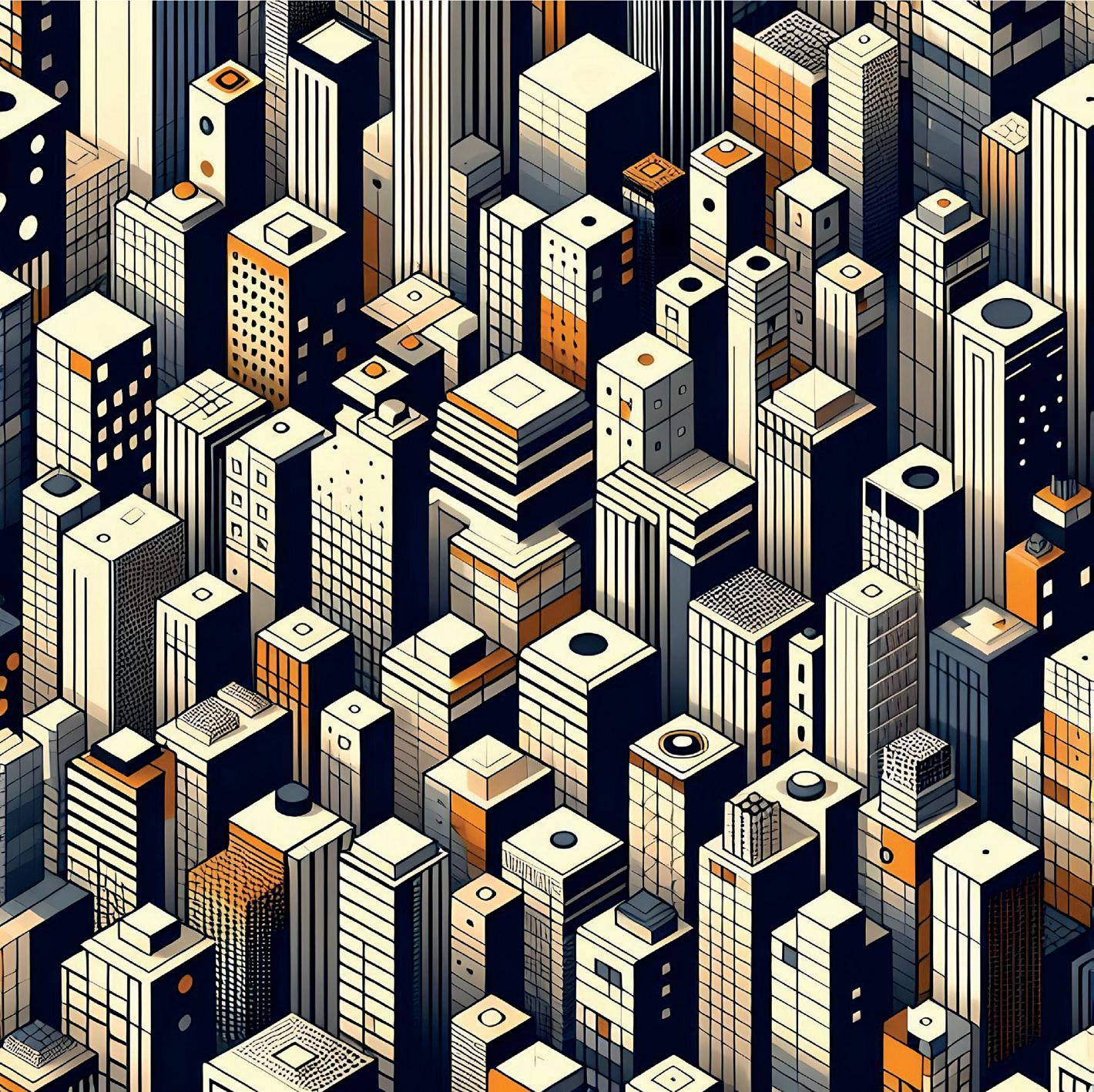
IDEAS & INSPIRATIONS
A journey that begins in a geometric, hypnotic metropolis. And continues towards forests, deserts, pop or rarefied atmospheres, between tribal allusions and retro echoes (romantic but with a modern twist). A multitude of eclectic, brilliant hints. A spirit that looks far and wide while remaining close to home. Pack your bags and put on your slippers, it’s time to go. Even if only with your mind
by Patrizia Piccinini
April 2024 | 29 MOOD BOARD
Spaghetti Wall’s Disto-pop wallpaper is a graphic experiment inspired by the world of Maurits Cornelis Escher (but it could also be a video game for the most sophisticated gamers), created with the help of AI
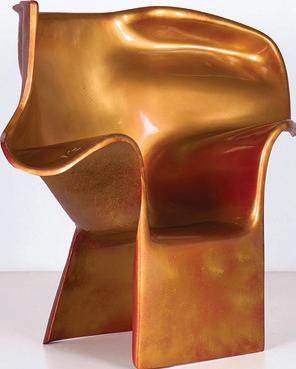
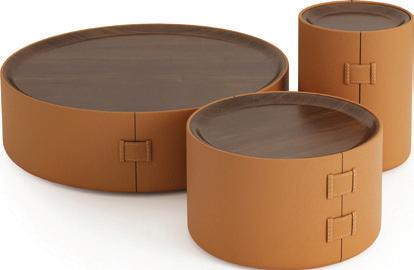
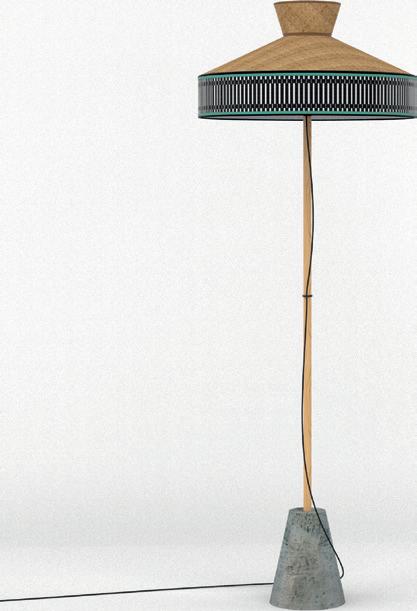
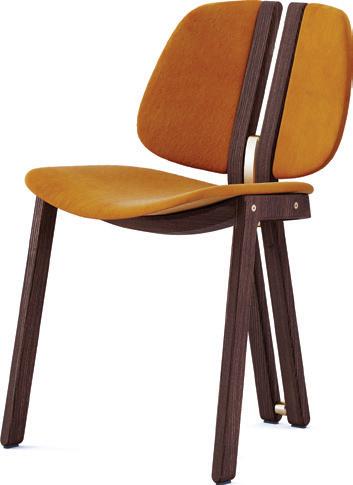

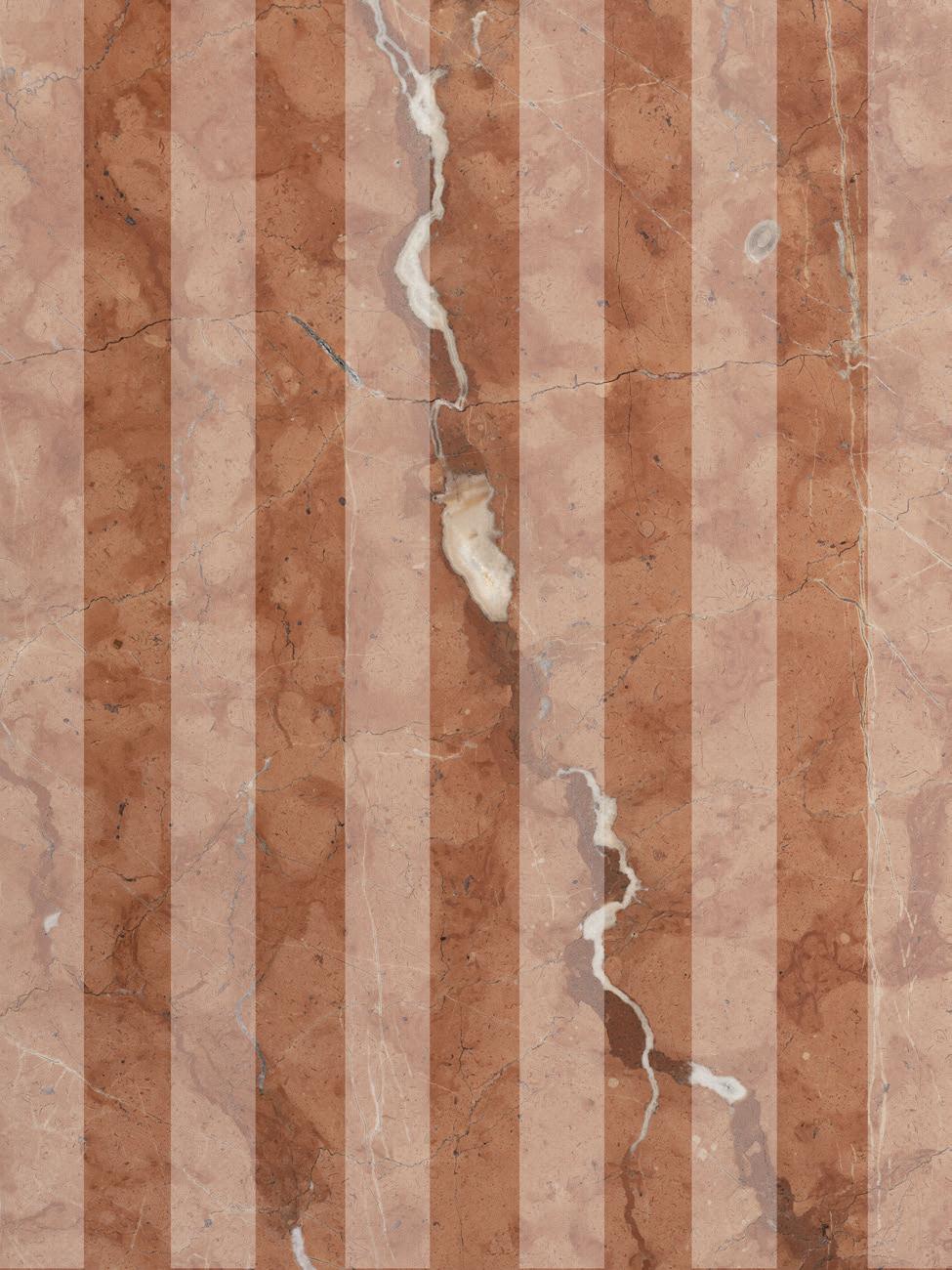
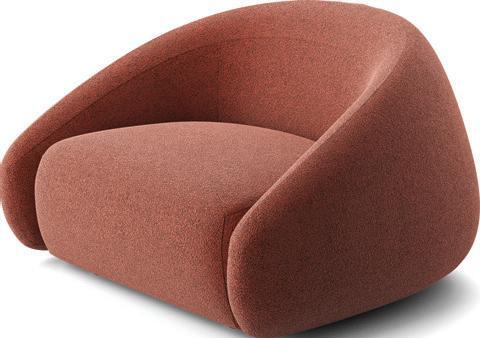



Earth Tone
1 | The parallel lines of two-tone marble of the Lucinato XL cladding by Attila Veress for LUCE DI CARRARA, create a unique visual texture, flat to the touch but versatile for any space (piazza Tomasi di Lampedusa). 2 | The new Giardino floor lamp by SERVOMUTO extends the family of the same name with a new floor-standing version to celebrate the eclectic style of the 1950s with references to the exoticism of the far east (via Olona 25). 3 | Amatta is a chair in resin with curved, flowing, soft and rounded forms, created in 1974 by Roberto Matta issued for the first time by PARADISOTERRESTRE in a limited edition of 1.000 with engraved identification number and artist’s signature. 4 | The back and armrest become one element in the Apper chair, the result of a collaboration between Antonio Rodriguez and LACIVIDINA (via Alessandro Manzoni 41). 5 | Atelier tables by Matteo Nunziati for TURRI in leather are decorated with buckles that conjure up Italian leather goods. The refined details and top in walnut bring a contemporary and sophisticated style (Hall 3, A09-B10). 6 | The Giano chair from the Acquerello collection by PAOLO CASTELLI, takes inspiration from the myth of Janus, the god with two faces. Available in two versions with structures in walnut or black-stained ash, enhanced with metal details in Brass or Black (via S. Carpoforo 12). 7 | The architectural legs are the focus of the design of the Loom table, designed by Hannes Peer for his debut in the BAXTER collection (Hall 9, H10-G09). 8 | The Stipo Bar Poliedro Vasi by FORNASETTI is an elegant artisanal piece in handprinted wood with screen printed decorations on a black or white background on the outside and white on the inside (corso Venezia 21A). 9 | Pietre pouf made by GUFRAM in collaboration with London designers Soft Baroque. 10 | FRATELLI BOFFI present for the first time the Archi table by storagemilano: monumental and refined, completely clad in inlaid burled oak. A perfect combination of classic architectural forms and the finest cabintmaking (Hall 13, C10).
30 | April 2024 MOOD BOARD
5 4 2 3 1 6 8 9 10 7


DESIGN IS INNOVATION WITH A TWIST.
WEEK
2024
MILAN DESIGN
16–21 APRIL
9 | BOOTH E05 – F02 /
– F08 FLEXFORM MILANO VIA DELLA MOSCOVA 33
SALONE DEL
MOBILE.
MILANO RHO FIERA HALL
E11
CAMELOT SOFA. DESIGN ANTONIO CITTERIO
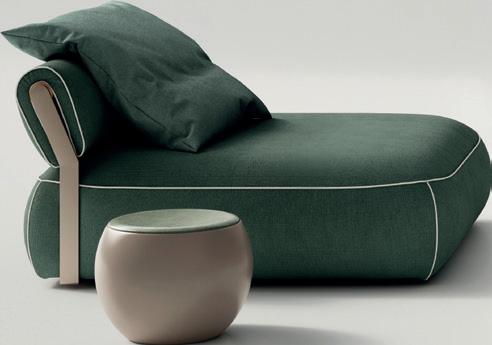
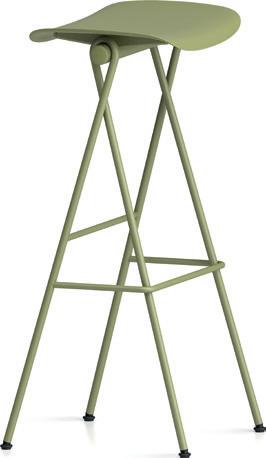
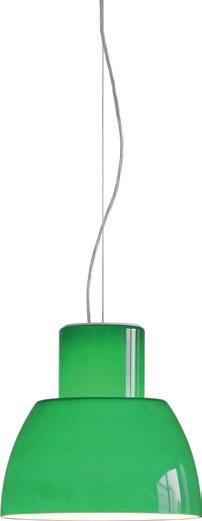




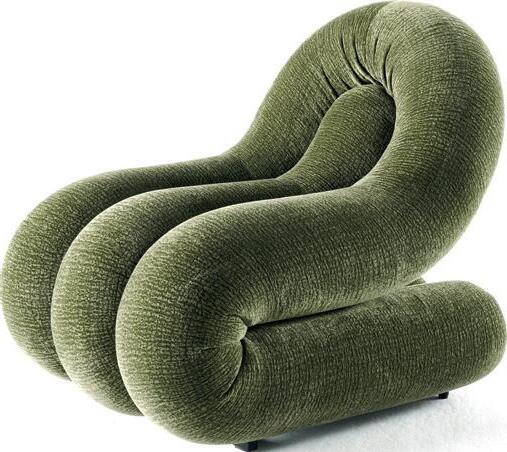
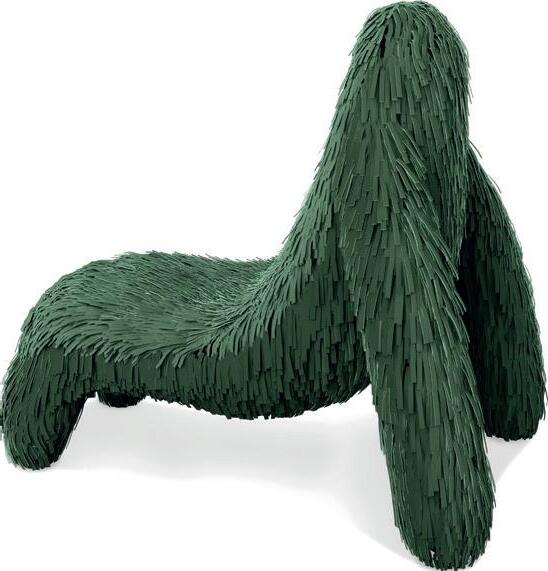

Olive(r) Twist


1 | Concept 2, is one of the new rugs by Storagemilano for BATTILOSSI (via dell’Orso 16). 2 | Flip stool in steel tubing designed by the studio Brogliato Traverso for INFINITI (Hall 03, D15-E18). 3 | NEMO LIGHTING presents the Lorosae lamp designed by Álvaro Siza for an exhibition in Vicenza in 1999 (via Borgonuovo 19). 4 | Round Stille Tufted Rug by FERM LIVING 5 | Curvaceous forms for the Brygge armchair by GIANFRANCO FERRÉ HOME , with high-density polyurethane foam padding (Hall15, B14). 6 | A seating with generous proportions: Vincent, the new Open Air sofa designed by Andrea Parisio for MERIDIANI , is designed for free composition, thanks also to the pouf and the trapezoidal element (Hall 11, G11-H18). 7 | The 118 FV chair by Sebastian Herkner, for THONET , is available in assorted colours and versions, with padded seat, in woven rattan or a stained monochromatic model with profiled seat (via Palermo 1). 8 | Gorilla Chair by Marcantonio for SCARLET SPLENDOUR is a soft and comfortable chair, covered in a rich decorative layer in green leather. 9 | Based on a creative idea by Thomas Lehman and the ANALOGLAB team, Luna Cartoon comes in two versions – one round and one oval – of wireless lamps for indoor and outdoor use (Design Variations, viale Gorizia 14). 10 | The AX stool by Alessandro Stabile for ZILIO A&C evokes the moment when a trunk of wood, hit by the woodcutter’s axe, splits in two (Hall 18, E05). 11 | Armchair from the Jade collection, designed by Hanne Willmann for POTOCCO (Hall 11, L15-M12). 12 | Madia Bay created by Busetti Garuti Redaelli for NOVAMOBILI is available with hinged or flush door with a smooth or slatted front (via Melchiorre Gioia 6/8).
32 | April 2024 MOOD BOARD
2 4 3 5 7 8 9 1 10 11 12 6
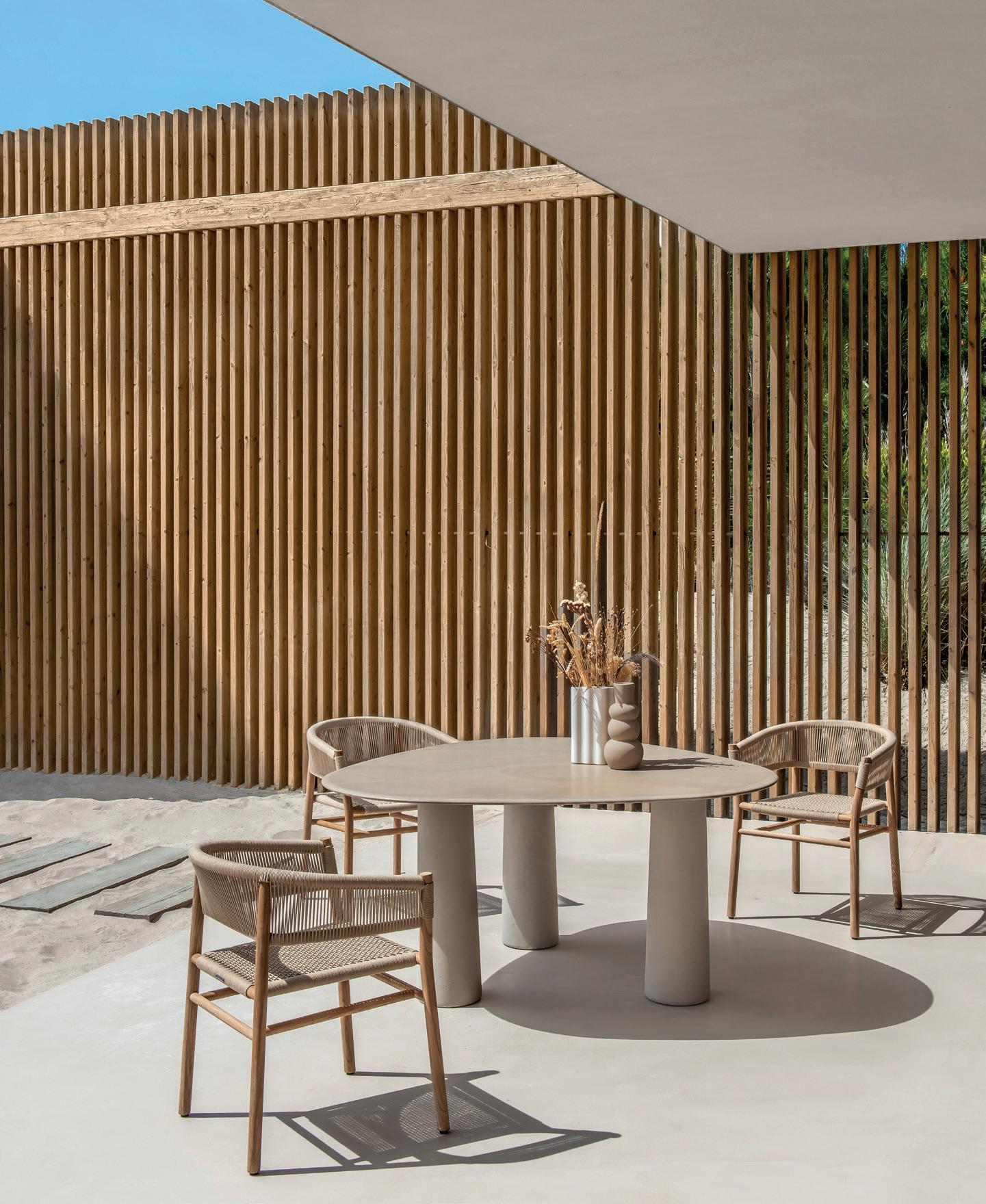
SHOWROOM MILAN / PARIS / ROME / LONDON / CANNES SALONE DEL MOBILE.MILAN 16-21 APRIL / HALL 22 STAND L22L24 MILAN FLAGSHIP STORES VIA F. CAVALLOTTI 8 / CORSO MAGENTA ETHIMO.COM BOLD TABLE BY ETHIMO DESIGN STIUDIO KILT CHAIR BY MARCELLO ZILIANI PH BERNARD TOUILLON
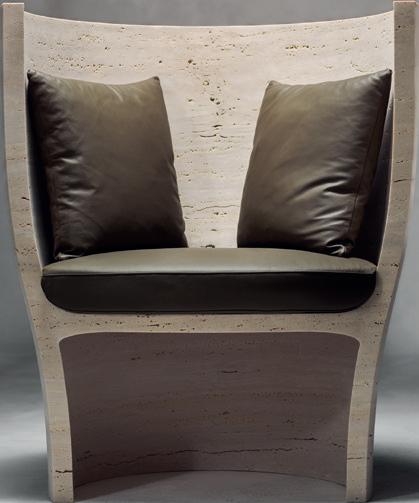
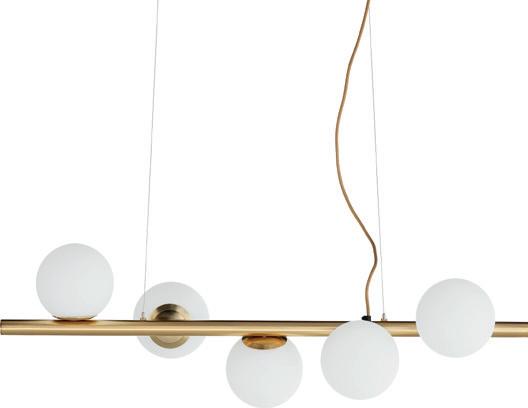





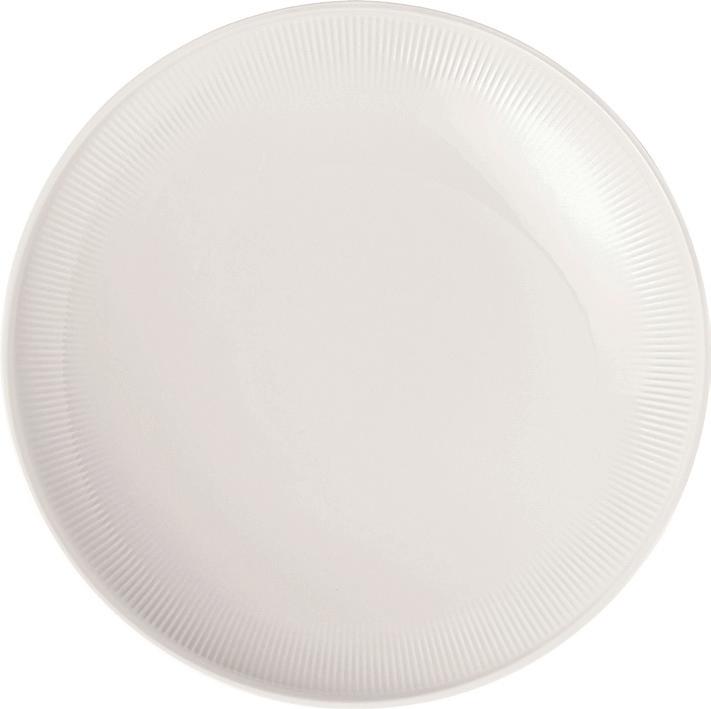
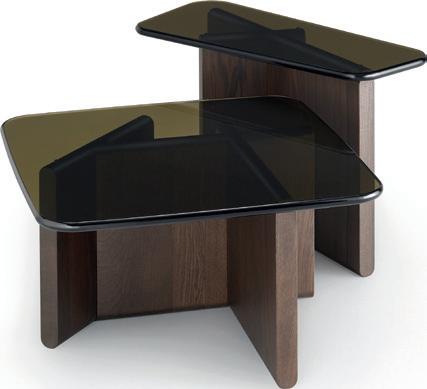
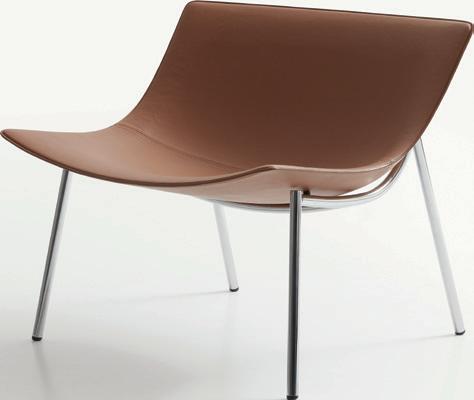
Wave Glam
1 | The Groviglio rug from the Inganni Spaziali collection designed by Armando Milani for TAPIS ROUGE is inspired by a collage of locks of hair cut out of magazines that are then assembled together (via dell’Annunciata 26). 2 | The Twist hanging light by RIFLESSI in galvanic satin metal with different-sized rings creates an atmosphere of harmonious movement (Piazza Velasca 6). 3 | Travertino Navona is used to sculpt the shape of the Holly chair, with its enveloping shell and seat in cow hide. Designed by Christophe Pillet for KREOO e GRUPPO MASTROTTO (Hall 13, E03). 4 | The Bloom Icon bar cabinet created by Maša Vukmanović, Jelena Lukač Kirš, Jakov Šrajer for MILLA&MILLI resembles a glass of wine. At the heart of the design is a rotating mechanism: the doors open with a slight movement, revolving around a central axis. 5 | With its simple and intuitive opening, the Verto sofa bed designed by Simone Cagnazzo for LIU JO LIVING is characterised by its pared-down simplicity. 6 | The Flocks collection of tables in brass or copper, devised by Matteo Zorzenoni for DE CASTELLI, are inspired by the elegant movement of flocks of birds in the autumn sky (Hall 24, B01-B02). 7 | Afina, the new collection by VILLEROY & BOCH and Christian Haas has a delicate relief on Premium white porcelain. 8 | The folding Lauren chair, designed by Antonio Citterio for FLEXFORM, combines the traditional with the contemporary. Finely crafted, it features a structure in solid wood and metal armrests covered in leather (Hall 9, E05-E11). 9 | Type tables designed by Patrick Norguet for FIAM ITALIA in glass and solid wood that can by overlaid to create new shapes (Hall 9, C09). 10 | Federica Biasi designs Omega for LEMA, a lounge chair with an elegant and contemporary design inspired by the stylings of the Fifties (Hall 11, B15-C20).
34 | April 2024 MOOD BOARD
1 2 4 5 6 7 8 9 3 10





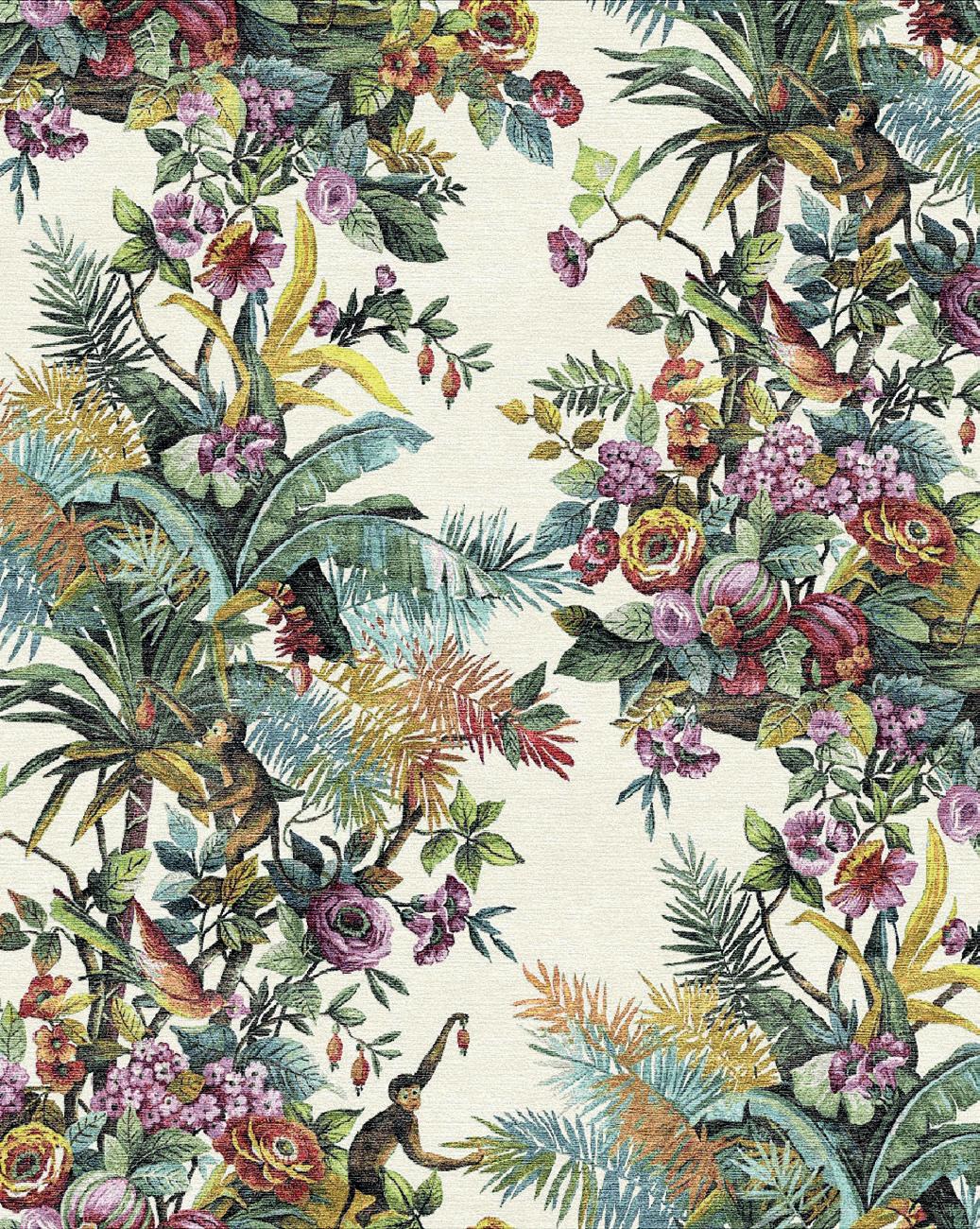
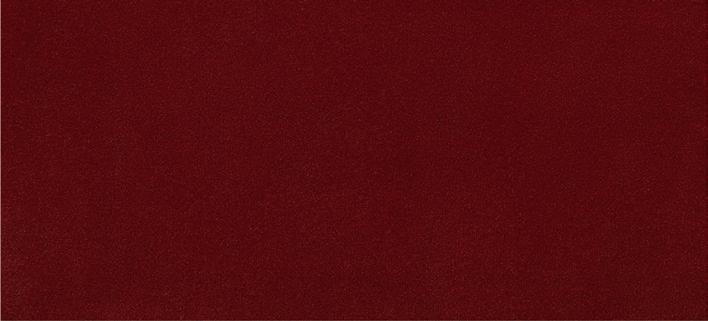
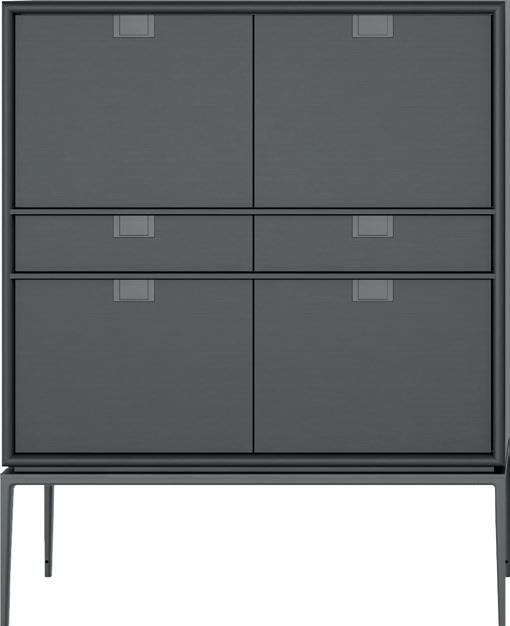


Gentle Haven
1 | Nature explodes in a riot of plants, flowers, leaves and animals on the Exotic White Jungle rug, an original design by Simone Guidarelli® for ILLULIAN (via Alessandro Manzoni 41).
2 | Random Cloud by Chia-Ying Lee for LODES is an evolution of the Random Solo hanging light that now combines multiple elements in glass with a central rose (via della Moscova 33). 3 | The Mara chair by Busetti Garuti Redaelli for CALLIGARIS , upholstered and covered in fabrics/leathers from the catalogue, with decorative inserts in black stained ash wood and Canaletto walnut, also fitted with swivel mechanism (Hall 3, A15-B16). 4 | The Artemone storage unit by Antonio Citterio for MAXALTO/B&B ITALIA offers numerous combinations of doors and drawers with a lightweight aluminium base and assorted finishes for the upper part, including black shellac and grey oak (via Durini 14). 5 | La Suite, the collection designed by SOMMA1867 embodies the concept of “quiet luxury”, combining elegance, exclusivity and innovation (corso Garibaldi 65). 6 | The sumptuous, long-piled, cotton velvet Monsieur Baudelaire by DEDAR 7 | The Galimede range of side tables by Giuseppe Casarosa for CECCOTTI COLLEZIONI has been extended with three new versions and finishes: coffee table with single top, side table with handle and side table with drawer (via Durini 23). 8 | MIDJ present the Mys collection created in collaboration with Beatriz Sempere, a Spanish designer who combines the tradition of her homeland with a refined and harmonious touch (via Tortona 31). 9 | Designer Joe Garzone has designed the Victor bed for CONTE characterised by the particular enveloping headboard and elegant quilted detail inside the ends (via Manzoni 45, via Senato 45).
36 | April 2024 MOOD BOARD
2 3 4 5 6 7 8 9 1
Introducing Lobster by Carlo Colombo for ELIE SAAB Maison: a captivating art design piece, crafted with precision and artistry. Lobster captures the imagination and invites exploration, while embracing innovative design techniques.

NIGHTS OF WONDER
Milano Design Week 2024. 16th - 26th April
Via Sant`Andrea 23, Milan I +39 342 571 8517

Discover More
HOME INTERIORS







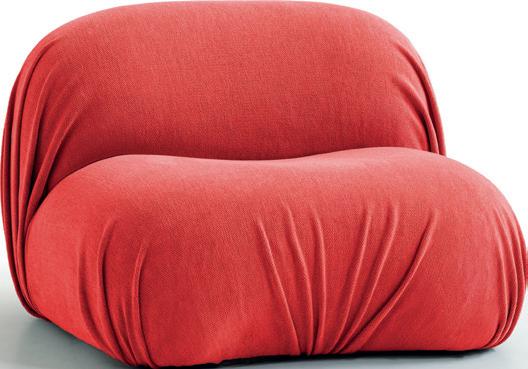
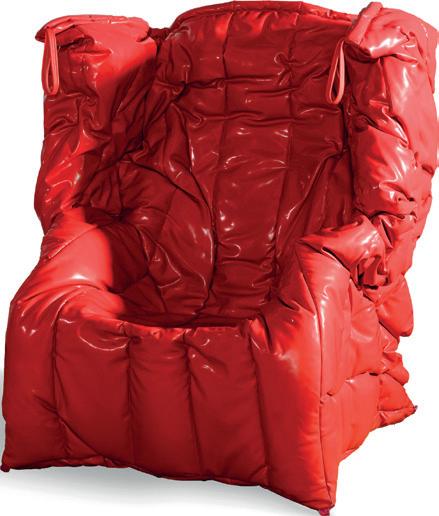

Floral Harmony
1 | CARPET EDITION and Ken Scott, have come together to create a unique collection of rugs and hangings inspired by the iconic work of the celebrated designer, such as the LadY’S Flower rug (Hall 18, D09). 2 | The Omar bowl, the result of a collaboration between RAAWII and Omar Sosa, in ceramic made and glazed by hand in Portugal. 3 | Mangiafuoco by Zanellato/ Bortotto for MOROSO transforms simple copper objects into side tables and round trays with unexpected and imperfect colours (via Pontaccio 8). 4 | The Tugendhat chairs designed by architect Mies Van Der Rohe in 1929 for the house of the same name at Brno, in the Czech Republic, now in the KNOLL INTERNATIONAL range (Hall 24, D11-E12). 5 | Uni by Piero Lissoni for CAPPELLINI is a series of modular containers characterised by slender doors in poplar ply combined with aluminium, with a laminate base and metal frame (via Borgogna 8). 6 | To mark the tenth anniversary of the Bolle lamp by Massimo Castagna, GALLOTTI&RADICE with It’s All About Colours present an exclusive total colour proposal, also in a topaz version (via Felice Cavallotti 16). 7 | Following the acquisition by the group Italian Radical Design, MERITALIA returns with a selection of legendary pieces created by Gaetano Pesce such as the Shadow chair (Hall 24, M10-M12). 8 | Puff-D by DIESEL LIVING with MOROSO is an informal chair covered in removable and washable fabric. 9 | The Lepal chair by Doshi Levien for ARPER combines a rigid external structure with a soft internal seat, available in different options for both cover and base, is FSC certified and can be completely disassembled (Hall 22, C21-D12). 10 | With its monolithic appearance, the Origata bench by Nao Tamura for PORRO takes inspiration from the creation of traditional Japanese kimonos (Hall 11, D15-E18).
38 | April 2024 MOOD BOARD
2 3 4 5 6 8 7 9 1 10
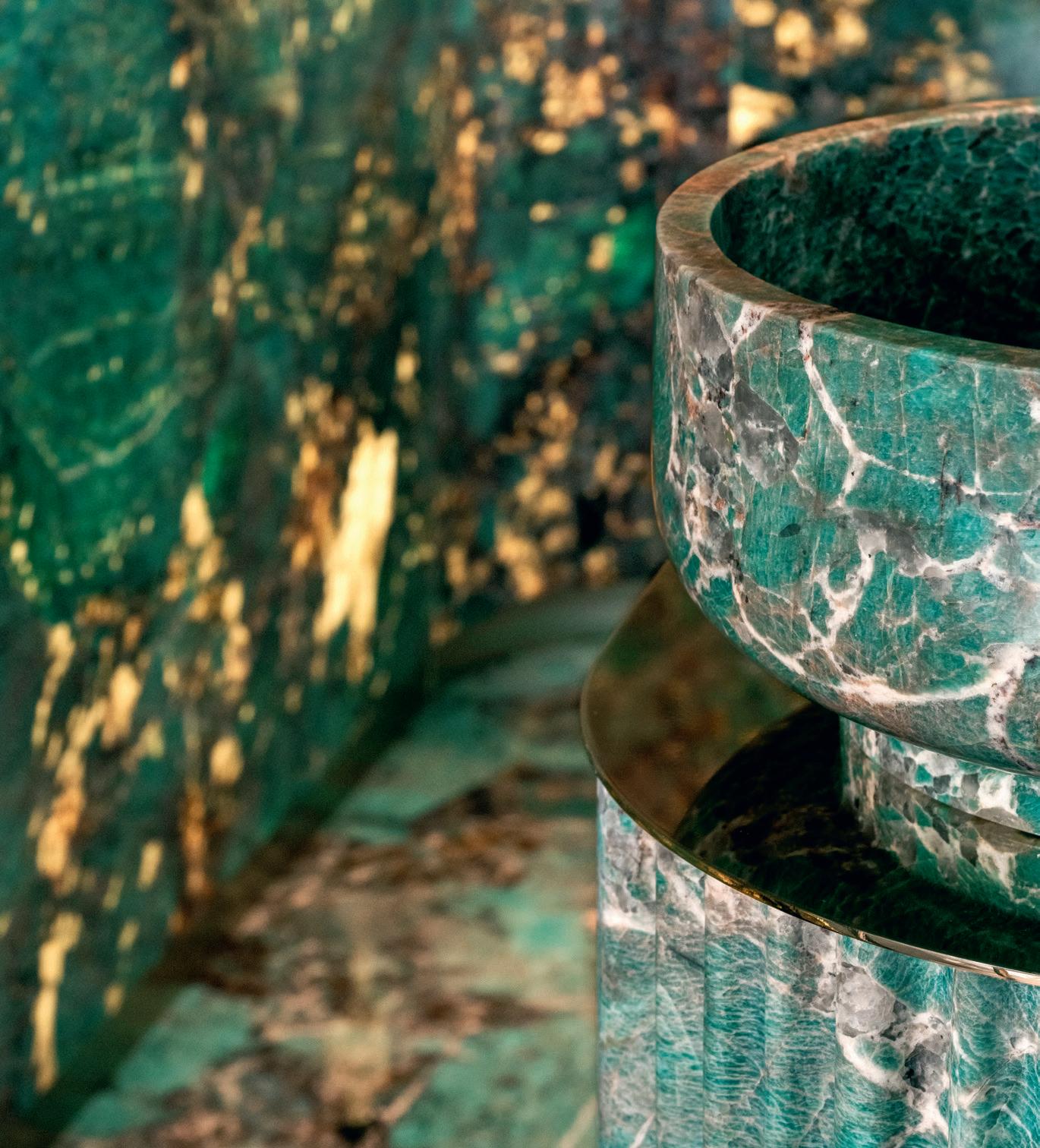
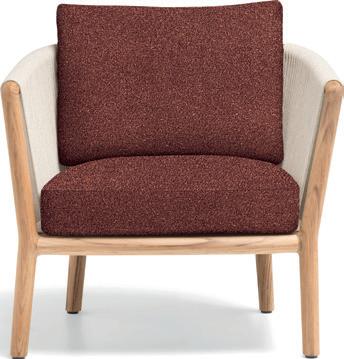



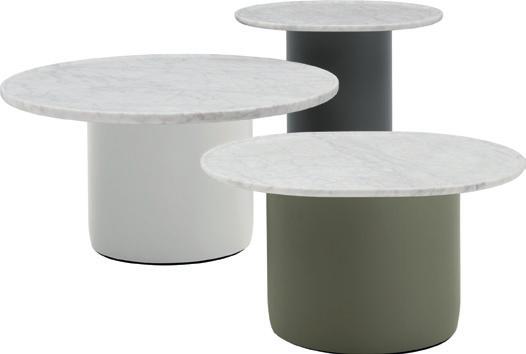
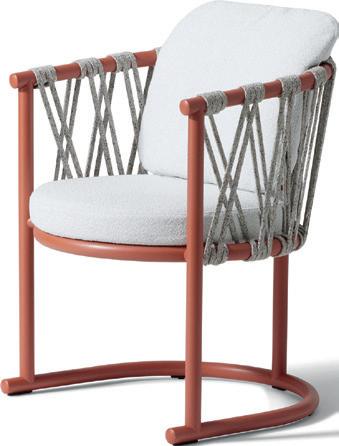


Sweet Life
1 | Pangea rug with diamond pattern created by studiopepe for ETHIMO (Hall 22, L22-L24). 2 | The Dreispitz hanging light created by Herzog & de Meuron for ARTEMIDE , now also in an outdoor version (corso Monforte 19). 3 | The Button Tables collection by Edward Barber & Jay Osgerby for B&B ITALIA , offers outdoor side tables with tops in white Carrara marble and bases in rigid polyurethane painted in five colours (via Durini 14). 4 | Boboli chair by Vincent Van Duysen for MOLTENI&C : light, enveloping, with teak frame and handwoven backrest. Customisable cushions from the Molteni&C Outdoor Collection by Marta Ferri (Hall 24, A09-C10). 5 | Rattan M rug by BLOOMINGVILLE 6 | Trampoline Chair by Patricia Urquiola for CASSINA comes in two versions: one with backrest in handwoven polypropylene and nylon rope, the other with metal structure left exposed for a stripped-back charm (via Durini 16). 7 | Aluminium, customisation, attention to detail, harmony and nature all feature in the Roè chair, designed by the new creative directors of FAST , Francesco Meda and David Lopez Quincoces (Hall 22, G14). 8 | The structure of Cosmo by ETHIMO and Studio aMDL Circle features sturdy columns in brushed teak giving it an organic and eco-friendly look. Covers are supported by aluminium “branches” that hold the fabric shades (Hall 22, L22-L24). 9 | Maximo modular sofa made from recycled materials by Raffaello Galiotto for NARDI has a structure in recycled resin and fabrics with a high post-consumer component (Hall 18, D23-E22).
40 | April 2024 MOOD BOARD
2 3 4 6 7 8 9 1 5
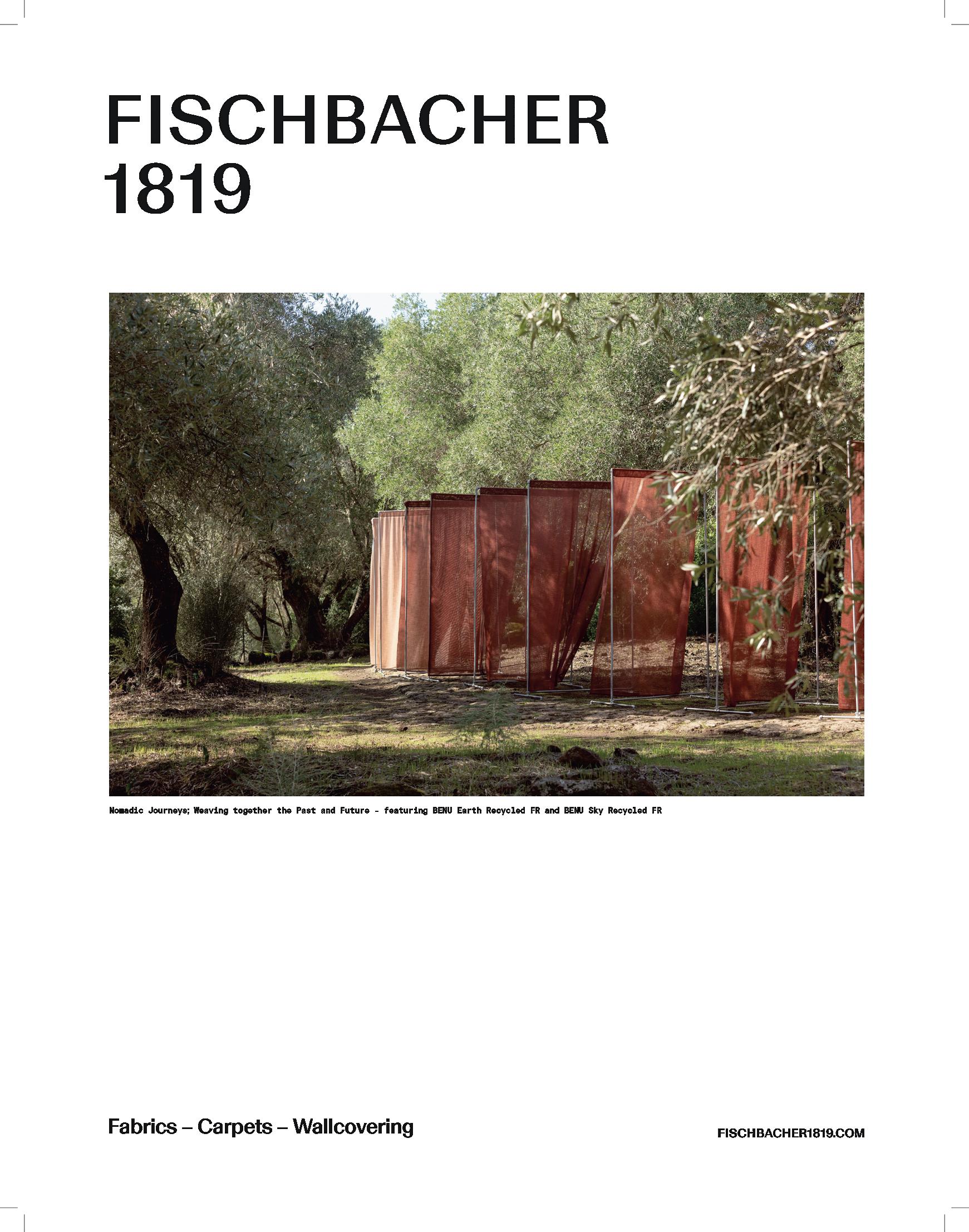









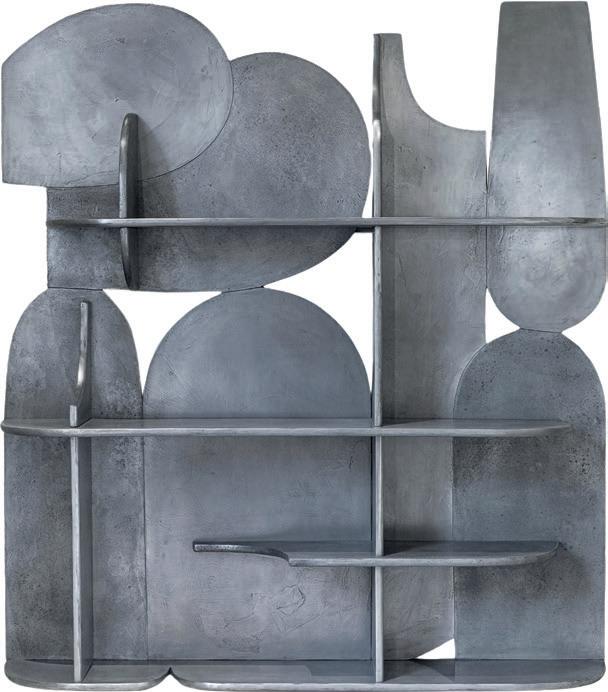

True Blue
1 | To mark its 135th anniversary, BONACINA present a new collection of furniture created by Mattia Bonetti including a mirror in wicker (via Mozart 9). 2 | Horizon is a collection of lamps designed by DT Studio for IL FANALE, made with brass and white acid-etched glass. 3 | Lou by David Lopez Quincoces for FRIGERIO is the reinterpretation of a traditional bucket chair (Hall 11, C23-C25). 4 | Alchimie is a collection of porcelain and decor accessories created by Alessandro Guerriero and Vito Nesta. This collaboration brings together the Milanese designer and intellectual, known for his role in the Italian post-avantgarde, and Pugliese designer with his cosmopolitan spirit, owner of the brand GRAND TOUR (via Ferrante Aporti 16).
5 | The round Half-Step mirror by BOWER STUDIO is divided horizontally with the upper part projected forward with respect to the slightly recessed mirror underneath, creating a subtle effect of depth in the reflection. 6 | The reissue of the Gomma chair by Jonathan De Pas, Donato D’Urbino and Paolo Lomazzi for ZANOTTA celebrates its 70th anniversary with the opening of the new Flagship Store (via Durini 25/27). 7 | The Mima metal-effect wooden bookcase by Matteo Cibic, new art director of DELVIS UNLIMITED (via Fatebenefratelli 9).
8 | A sculpture base made from antiqued brass articulates the shape of the low sideboard from the Siona collection, created by Matteo Cibic for VISIONNAIRE (Hall 9, L11-M06). 9 | Pastel shades and fluorescent details, flashes of metal and refractive effects feature in the Glaze coffee table by Draga & Aurel for NILUFAR GALLERY (via della Spiga 32). 10 | Coliseum, designed by Alvaro Uribe for SLIDE, is a chair inspired by the Colosseum in Rome, with a monolithic body punctuated by a series of arches that give it a sense of timeless lightness (Hall 18, D14).
42 | April 2024 MOOD BOARD
2 3 4 5 6 7 8 9 1 10
Colour Calling
Nu Collection

Nu faucets represent a purity of visual expression and a synthesis of essential design elements: form, shape and colour. A collection that strips away the artifice to arrive at the essence of its timeless design.
roca.com/nu

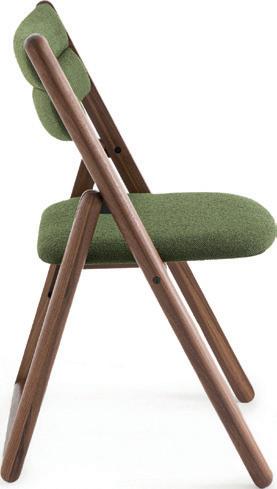
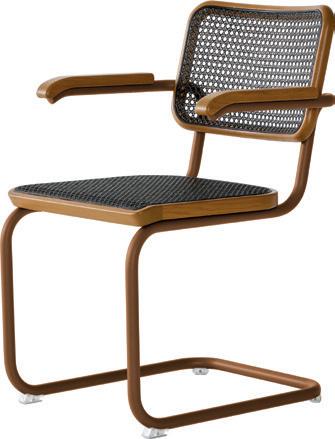
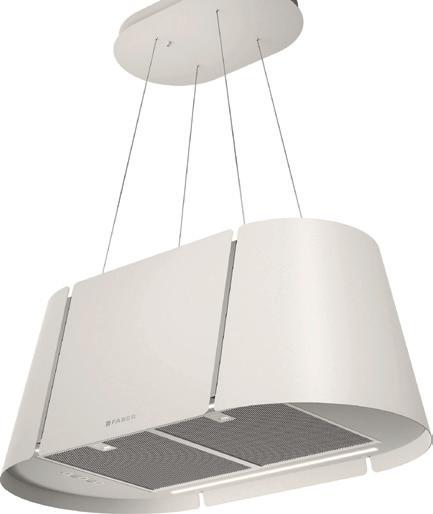



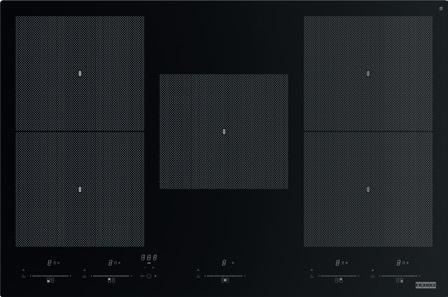


Natural Recipe
1 | Frammento is the new MARAZZI collection in porcelain stoneware that offers a contemporary reworking of Venetian terrazzo, thanks to the use of artificial intelligence (via Borgogna 2). 2 | The Beat XL by FABER , in the elegant new White Matt finish, is an 80 cm suspended elliptical extractor, featuring soft touch controls and double LED bar to guarantee a perfectly illuminated cooking area (via Pontaccio 18). 3 | The sculptural modular cabinet by SIGNATURE KITCHEN SUITE , design Patricia Urquiola, houses the undercounter convertible refrigerator. Available in three combinations, in wood or Cimento finish, in Vanilla, Blue, Burgundy, Green, Sand shades. (via Alessandro Manzoni 47). 4 | CGF11BLEU is the latest model of multifunctional coffee grinder from SMEG , featuring stainless steel conical burrs for better consistency. 5 | Flora by CASARIALTO is the new service plate in handmade transparent glass with green and white leaves added to the surface by hand. 6 | A creation by Emmanuel Gallina, exclusively for AM.PM (the premium designer brand of the La Redoute group) the Camminata chair is particularly mobile and suitable for small spaces (via Santa Marta 10). 7 | Mythos Induction 77 Hob, FMY 805 I F KL BK, frameless black glass induction hob by FRANKE (via Pontaccio 18). 8 | MOAK presents Coffee Jockey, the new coffee machine from the For You system, exclusively designed by Odo Fioravanti. 9 | The iconic S 32 and S 64 chairs by Marcel Breuer reworked by Sebastian Herkner for THONET in the “Rethinking Classics: S 32/S 64 Dark Melange” collection (via Palermo 1). 10 | A great comeback for SCHIFFINI : the famous Cinqueterre kitchen by Vico Magistretti, launched in 1999 that still today expresses all the appeal of an avant-garde design, this year interpreted by Toan Nguyen (via Durini 3).
44 | April 2024 MOOD BOARD
2 3 4 5 6 7 8 9 1 10
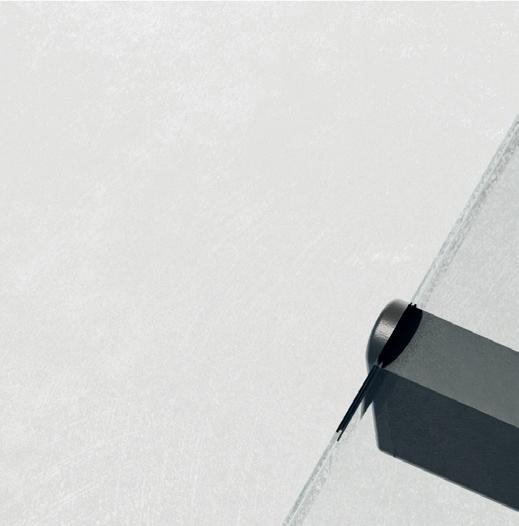
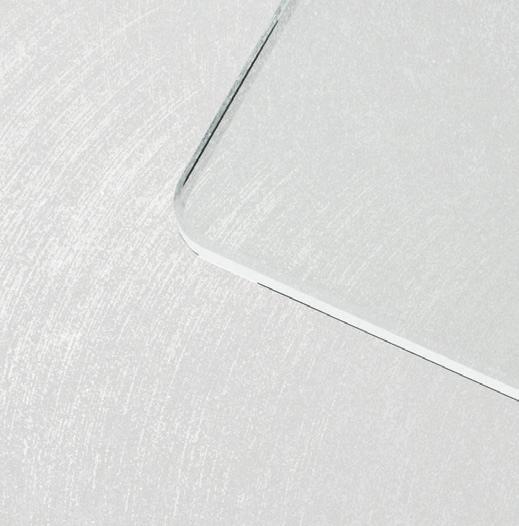
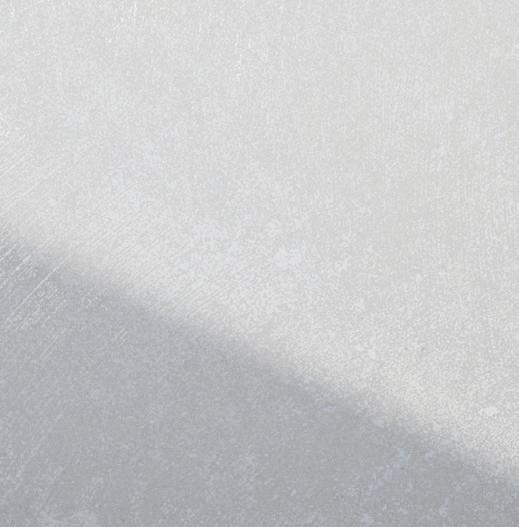
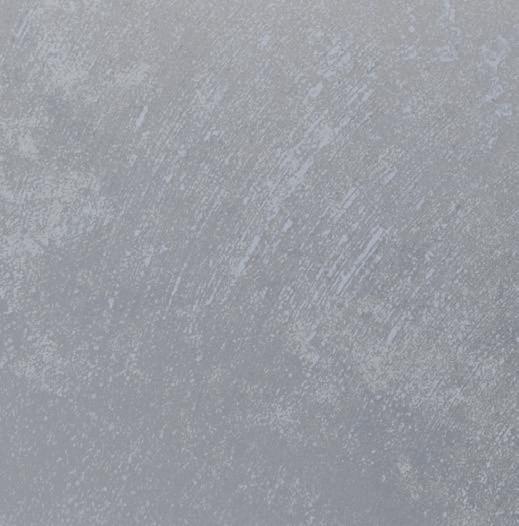
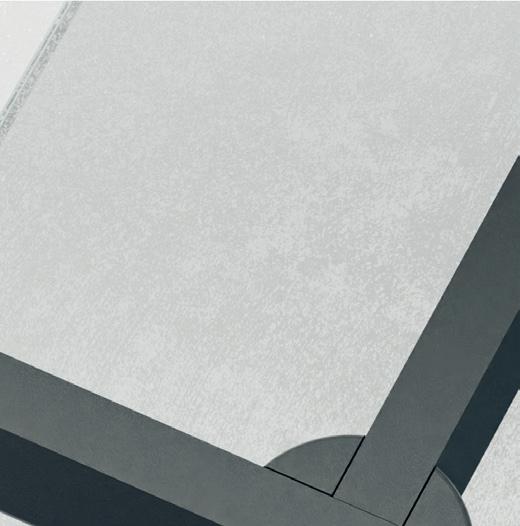
GIULIO IACCHETTI + MATTEO RAGNI


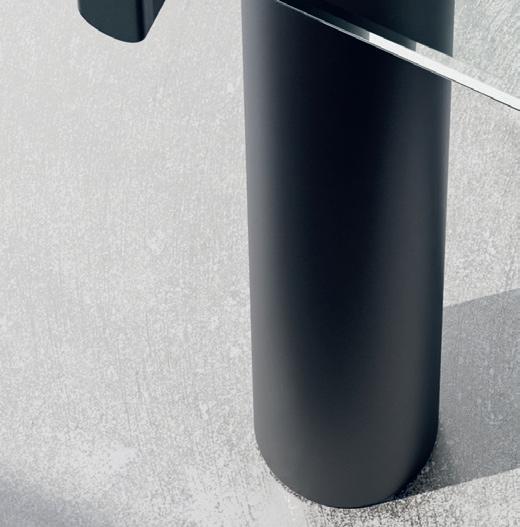


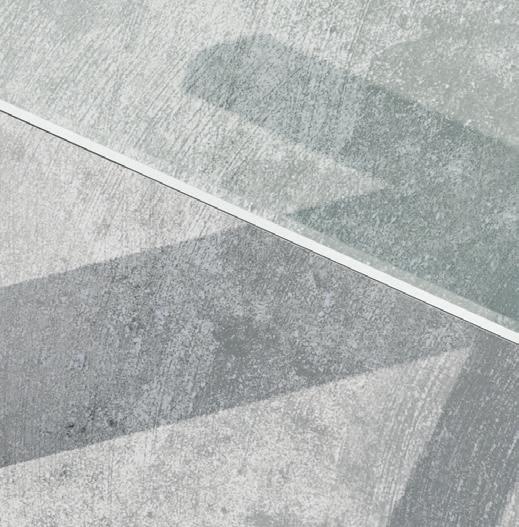


DECUMANO
Salone del Mobile.Milano 16—21.4.2024 / Pav. 22 Stand F15 G12 www.fantoni.it
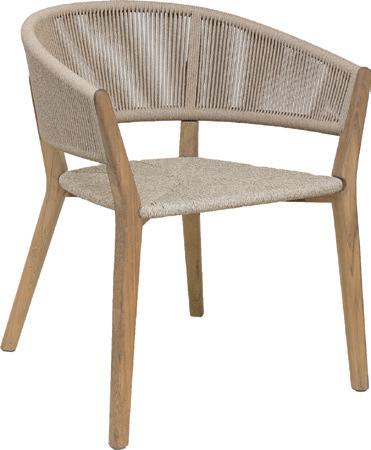



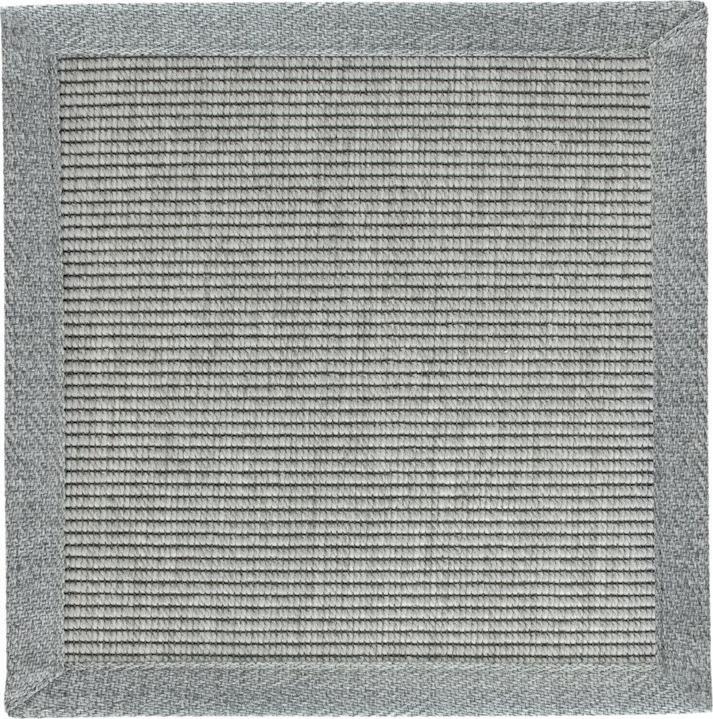
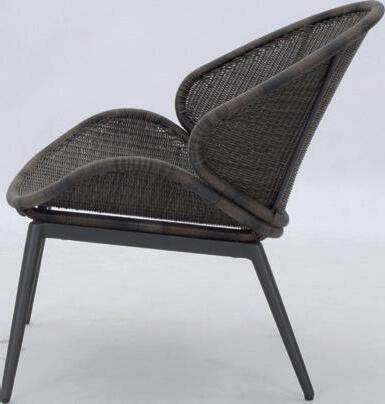



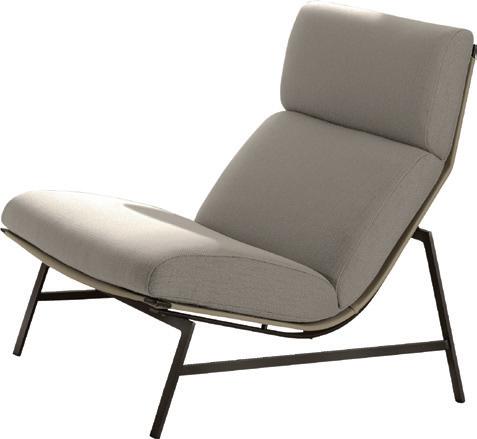
Green Card
1 | Park, designed in two weaves each in eight colours, with herringbone or straight ribbed options, is part of the first In-outdoor collection by CARPET EDITION (Hall 18, D09). 2 | The Carés chair by ROYAL BOTANIA combines traditional elegance with modern craftsmanship. With a teak structure and backrest in Batyline, it is perfect for gardens and terraces (Hall 09, E06-E08).
3 | The Cebu baskets by JANUS ET CIE, handwoven in the Philippines, combine locally-sourced teak with synthetic fibres. 4 | Mirasol, designed by Paolo Zani for WARLI, is a rug woven by hand from 100% polypropylene rope, completely recyclable. The flat technique with rope in relief creates a graphic texture with contrasting colour combinations. 5 | The Nacre chair by UNOPIÙ, with legs in graphite aluminium and WaProLace® recyclable rope, offers soft and enveloping shapes guaranteeing total relaxation even in the smallest of spaces (Hall 18, A05). 6 | Clara, the new outdoor lantern designed by Chiara Caberlon and Marco Forbicioni for CONTARDI LIGHTING, offers practicality and style with its Bauhaus-inspired design and cane-effect resin shade. 7 | Eolie by RODA is the new modular outdoor collection by Gordon Guillaumier, characterised by a clean and simple design. Made entirely from FSC Iroko, it consists of sun-loungers, side tables and a gazebo, with a distinctive wide wooden slat that is repeated (Hall 24, C02-C04). 8 | The dining table from the Embrace Outdoor range by CARL HANSEN & SØN, designed by EOOS, has a lightweight structure inspired by the dancing movement of kites, with a crossed wooden base and round top made from 50 pieces of solid teak (via Mercato 3). 9 | From VALENTINI the Criss Cross chair by Gian Paolo Venier from Studio Otto, is made from high-quality materials and depending on the fabric chosen can be used inside the house or out in the garden (Hall 7, C05). 10 | Stylish, practical and sophisticated the chair Allure lounger by Christophe Pillet for TALENTI with aluminium structure is available in assorted colours, including Mambo Pearl shown in the photo (Hall 24, M02-M04).
46 | April 2024 MOOD BOARD
2 3 4 5 6 7 8 9 1 10





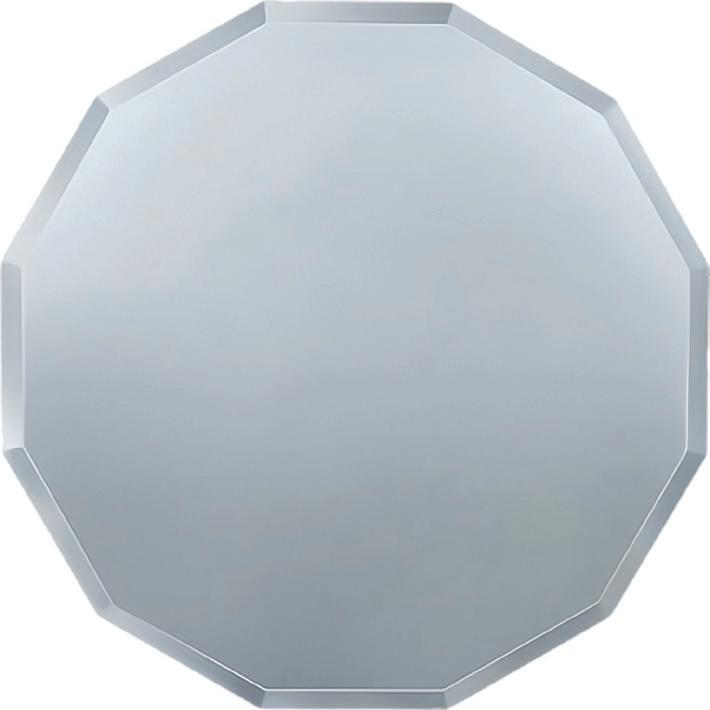



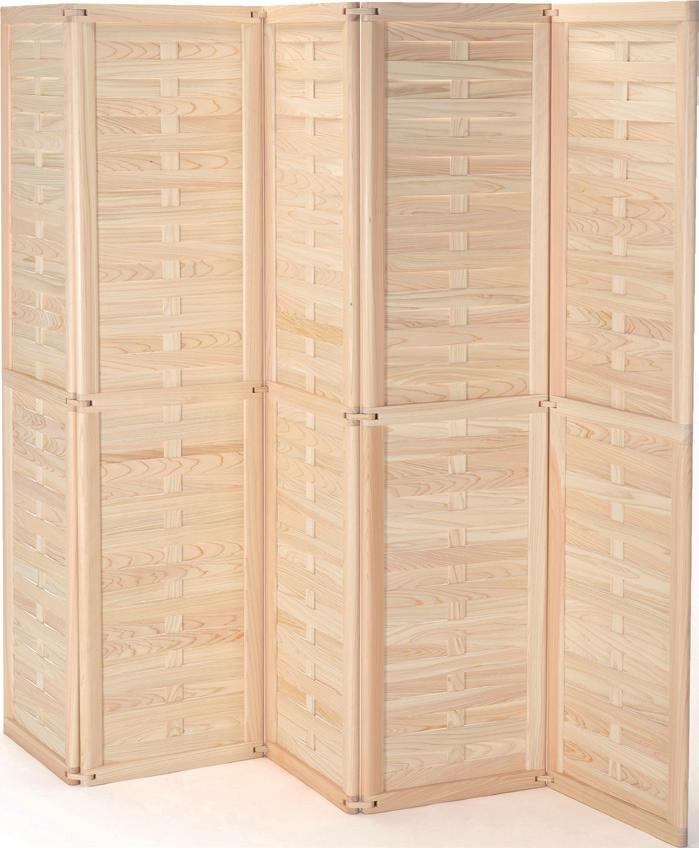


Soapy Secrets
1 | Boost Color by ATLAS CONCORDE is a design for stoneware cladding based on an innovative colour palette of 14 shades made in collaboration with Piero Lissoni. 2 | The Infinita lamp by Marta Sansoni for MARTINELLI LUCE is made from borosilicate glass and offers the possibility of creating different compositions thanks to its three-dimensional elements.
3 | The Naturae collection by GABEL , is characterised by the use of unbleached, undyed raw cotton (corso Garibaldi 65). 4 | The combination of digital and analogue: the Virgola dressing-table by Xu Zheng for OROGRAFIE , is versatile and offers a space for the telephone and personal objects (viale Gorizia 14). 5 | Taps from the Side collection by RUBINETTERIE STELLA , designed by Studio Meneghello Paolelli, offer a sophisticated line and endless options for customisation, (via Thaon de Revel 21). 6 | The Virgo mirrors by ARTELINEA in collaboration with Bizzarri Design combine craftsmanship and technology; ideal for domestic and contract environments they feature a touchless switch that makes it easier to turn on and off, improving cleaning and making the product last longer (Hall 6, A39). 7 | Itaca oval countertop sink on freestanding pedestal by CERAMICA CIELO , designed by Luca Cimarra and finished in Agave from the “Terre di cielo” palette. Accompanied by the Argo ceiling mirror, designed by Andrea Parisio and Giuseppe Pezzano (via Pontaccio 6). 8 | The VK Divider Short made with fragrant Hinoki cypress wood, the main material used for the entire collection by MAS one of the brands of the KARIMOKU FURNITURE (via Tortona 14).
9 | The Dama baskets, designed by Maurizio Manzoni for CIERRE1972 , bring out the elegance of handcrafted leather (Hall 11, L22-L24). 10 | The Ledro bathtub in Quarrycast™ by VICTORIA + ALBERT , was designed to reduce water consumption, focussing on water efficiency without compromising the style and comfort of the bathroom environment.
48 | April 2024 MOOD BOARD
2 3 4 7 6 8 10 9 1 5

The Ona Collection by Eugeni Quitllet I Fabric by Perennials sutherlandfurniture.com




NEUTRA and Mario Bellini: a revolutionary reissue

Exploring new territories of indoor and outdoor design, NEUTRA has produced the original project La Grande Muraglia by the famous Italian architect. This outdoor collection brings out the company’s deep heritage of craftsmanship and its mastery in the processing of stone, combining sturdy materials with a contemporary look as a tribute to the durability and elegance of authentic Italian design
by Giulia Guzzini

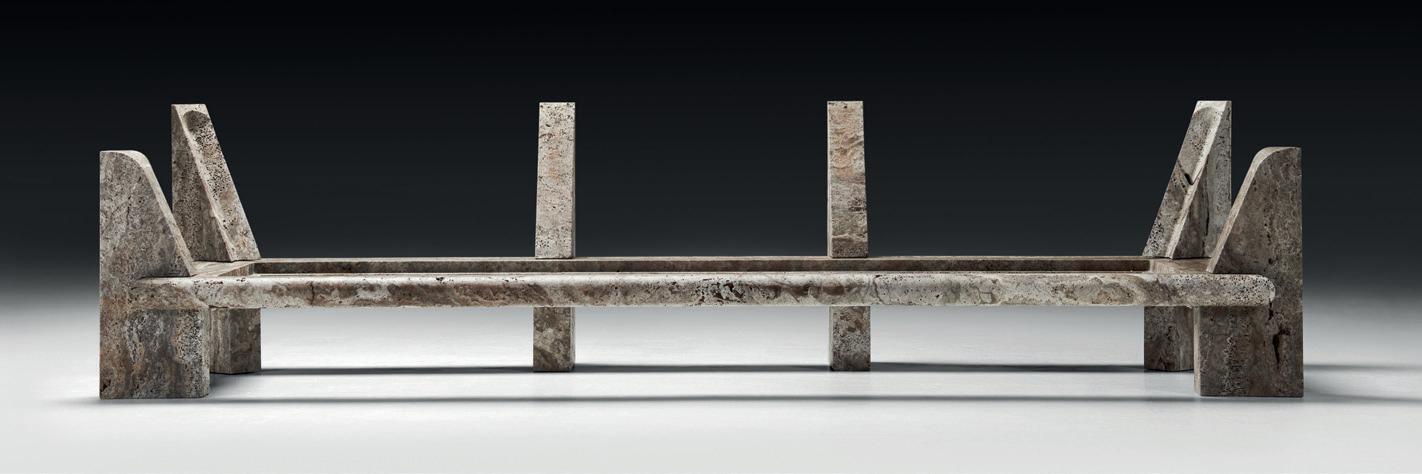
52 | April 2024 CLOSE UP
3 2 1

The company, founded in 1880 as Arnaboldi Angelo Srl in the heart of Brianza, Italy, stands out for its peerless dedication and painstaking focus on details in the creation of premium furnishings for the living area and the bathroom. Particular care goes into the use of fine varieties of stone, carefully quarried, crafted with advanced technologies and finished by hand to generate each piece as an epitome of artisanal skill and a refined emblem of Made in Italy. The year 2022 has marked a turning point, in which the company becomes NEUTRA, acquired by Emanuele Chicco Busnelli, son of the legendary founder of B&B Italia, Piero Ambrogio Busnelli. This acquisition brings new energy and passion into the company’s steadfast commitment to research, conserving a very high level of quality in design and workmanship.
All the foremost collections – from washbasins to bathtubs, shower trays to cabinets – embody the perfect synthesis between natural materials and advanced technologies. The company’s approach concentrates on elegance and perfect proportions of materials and measurements, weaving together natural stone, metal, glass and wood in a mixture that creates a sophisticated atmosphere. Furthermore, NEUTRA alternates its offerings with the ability to make personalized furnishings, adapting to the specific needs of the client.
Among the new developments presented this year, La Grande Muraglia Outdoor is a collection of seating that takes the success of the indoor version, presented in 2023, into spaces in the open air. The collection has the virtue of having returned the spotlight to an original project from

1981, based on the collaboration between the great master Mario Bellini and Piero Ambrogio Busnelli. Composed of furnishings of the highest quality, the outdoor collection underscores the strength and elegance of stone, translating it into a modern, sophisticated image. The company thus opens up a new territory of outdoor design, combining natural stone – the core of its true DNA – with its original habitat, to demonstrate the lasting value and force of design. The architectural embodiment of the seat is clear in the supports, which reference the pillars and architraves of a monumental construction, reflecting the majestic presence of the Great Wall with all of its solidity and durability. The bold character of the extraordinary forms, like the central protruding foot in the lower part of the chaise longue, emphasizes the remarkable expressive force of the brand. The collection, in fact, blends the soft language of upholstery with the solid, eternal character of marble – Roman Silver Travertine – to create a harmony of parts of great sculptural impact.
The collection relies on Silver Travertine to add refined aplomb to any outdoor space. Every piece, unique and timeless, aptly represents the special focus of the brand on durability and high quality. The new items in the collection include a three-seat sofa, a two-seat sofa, an armchair and a new addition: a chaise longue. The soft, enveloping lines of the furniture welcome the body in a comfortable embrace.
The materials chosen for this collection are just as remarkable as its design: the upholstery with removable covering is made in waterproofed polyurethane, clad with resin-treated fiber and lined with waterproof polyester. The cushions, in
waterproof polypropylene fabric, 100% recyclable, have been designed to stand up to weathering. In its commitment to respond to the needs of clients, offers five fabric variants –Zaffiro, Matcha, Corallo, Terracotta and Tabacco – and custom solutions by request, including the choice of the stone for the structure. The cushions can be easily removed for storage in a safe place during the winter months.
The same focus on excellence, open to discovery and contaminations with the world of architecture, is reflected in NEUTRA’s initiatives for the upcoming Milano Design Week. In the exceptional setting of the MEET Digital Culture Center, the space for digital cultures created in the Porta Venezia district, the company will unveil the results of intense and stimulating interaction with eight recognized masters of worldwide architecture, opening the exhibition “To the edge of matter. An unforgettable journey,” a display path created by Migliore+Servetto as a blend of physical and virtual reality. Through eight décor proposals for the living area and the bathroom, the designers involved – atelier oï, Draw Studio, Foster + Partners, Gabriele and Oscar Buratti, Mario Bellini, Migliore+Servetto, Nespoli e Novara, Zaha Hadid Architects – present an intense interpretation of matter in its various forms.
La Grande Muraglia Outdoor
1 Chaise Longue
2 Three Seater Sofa Structure
3 Three Seater Sofa Terracotta
4 Armchair Corallo
5 Armchair Zaffiro
6 Chaise Longue Terracotta
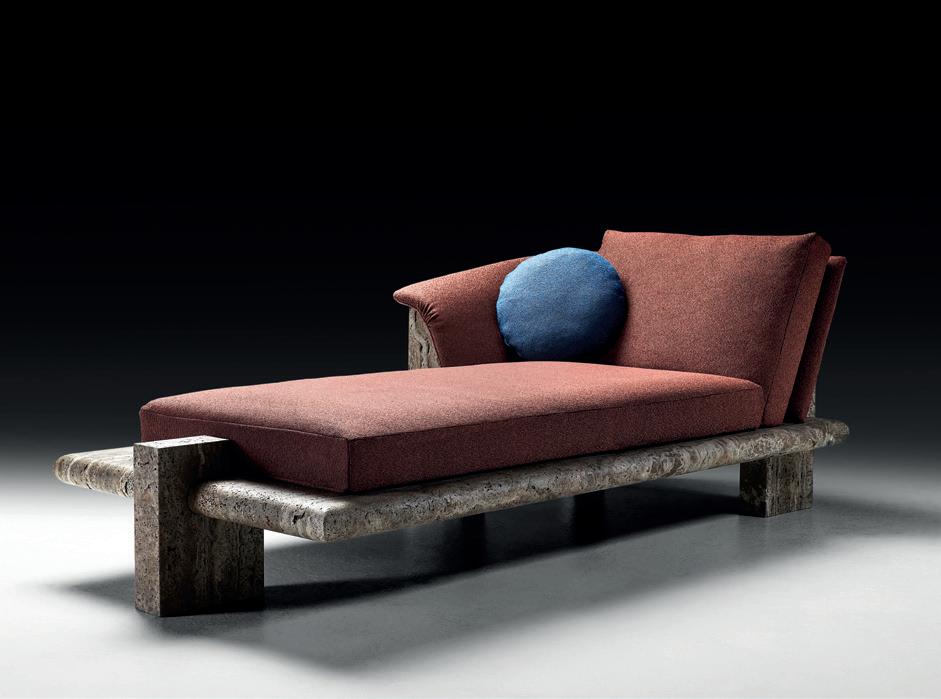
April 2024 | 53
5 6 4
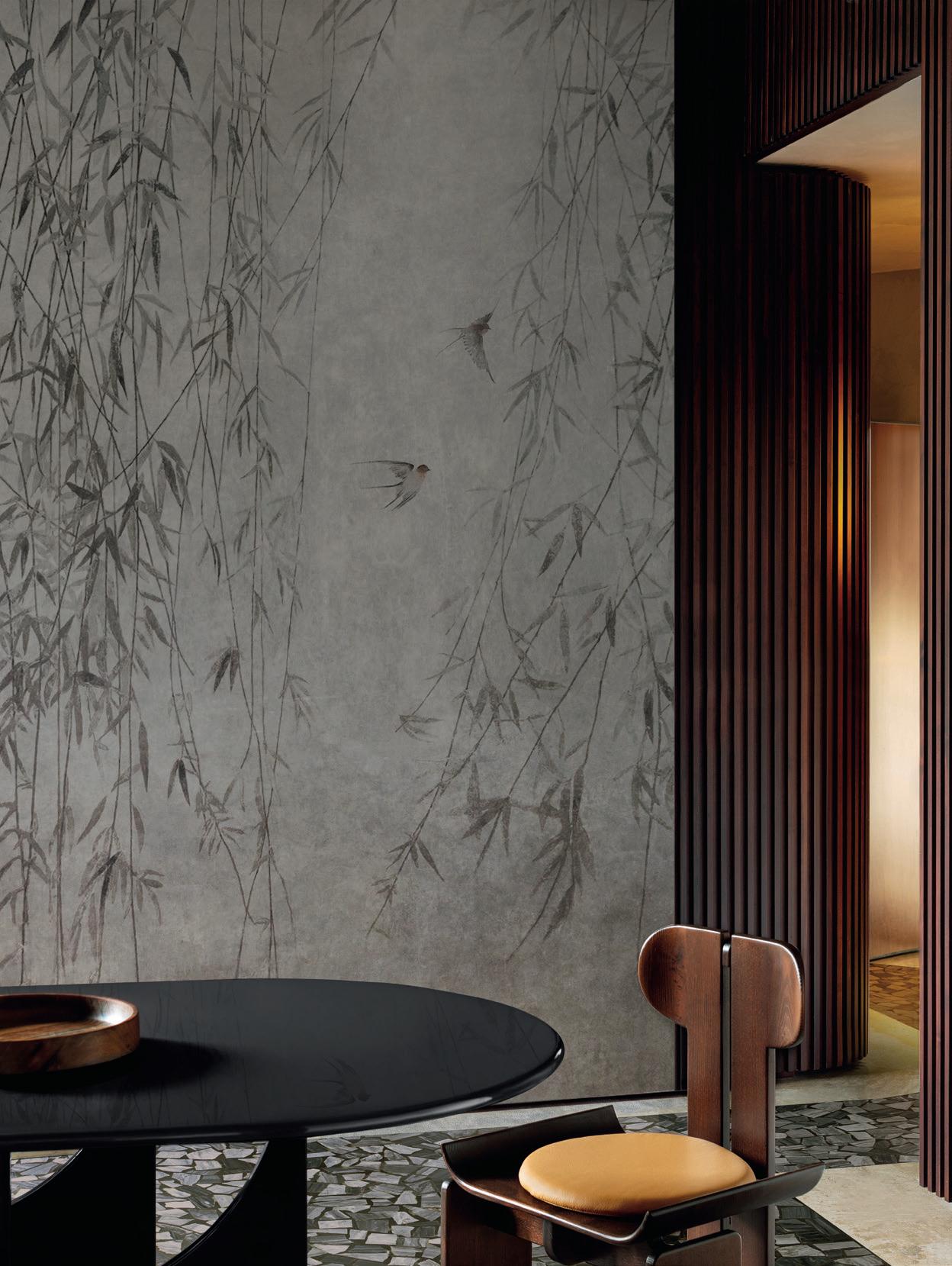
wallanddeco.com
layout
D+
/
studio
photo
Silvia
tailor-made contemporary wallcoverings
Rivoltella / design Lorenzo De Grandis
Design directions
The 2024 furniture and decor exhibitions highlight innovative design trends that embrace imperfections as a distinctive attribute in home fittings designs. Evident versatility in kitchen spaces comes to the fore as new collections cater to a variety of styles and requirements, transforming the kitchen into both a social and functional space. The trend towards maximizing outdoor spaces perseveres, with new collections that elegantly enhance exterior environments. Furthermore, timeless pieces of furniture are being reinvented, achieving a seamless blend of tradition and modernity.
by Matteo De Bartolomeis, Giulia Guzzini, Simona Marcora, Veronica Orsi
84 Agresti
86 Amphora
66 Arrital
86 Devon&Devon
55 Elica
60 Ernestomeda
64 Ethimo
58 Fischbacher 1819
86 Flexform
64 Gallotti&Radice
72 Giorgetti
66 Illulian
74 Kettal
70 Laufen
76 Ligne Roset
60 Living Divani
60 Mara
80 Margraf
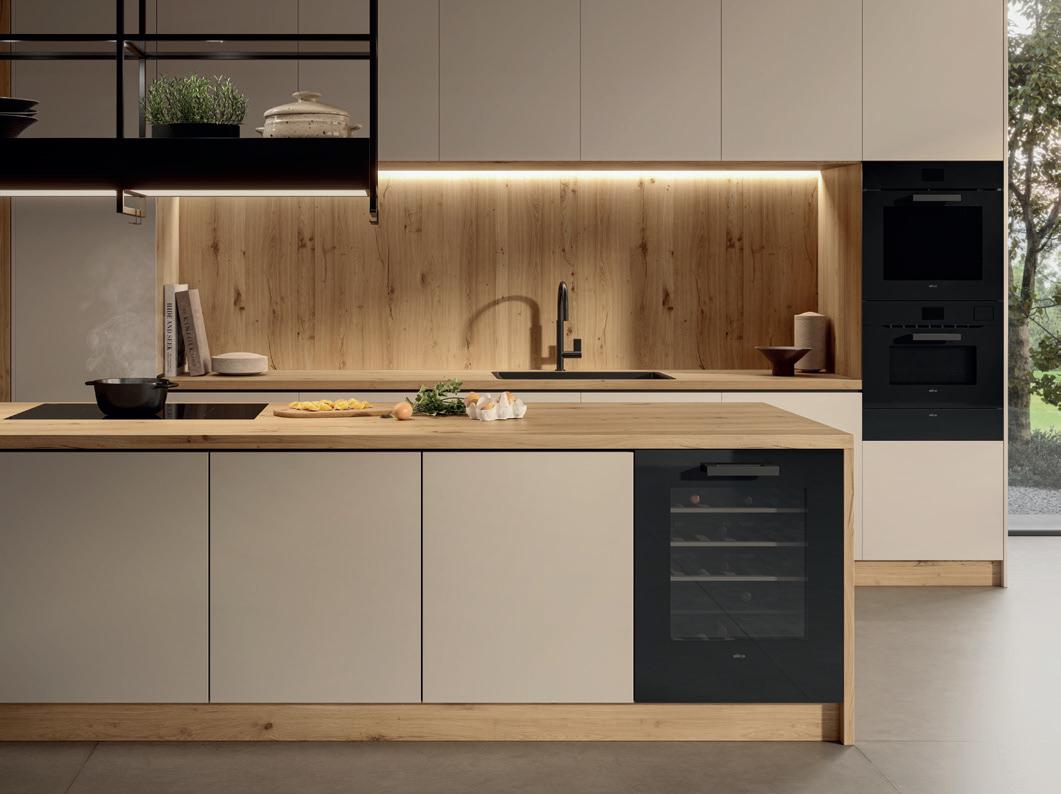
Technology and total black aesthetics
Presenting a linear and contemporary look with impactful expressive details and all-black surfaces, this is the new Virtus Multi 60 DD oven by Elica. “My idea in designing this product,” explains Fabrizio Crisà, the company’s chief design officer, “is based on the desire to focus all attention on two particular elements with
which one interacts: the handle and the knob. Both are in black anodized aluminum, but while the handle is small with a solid grip, the knob is generously sized and designed as a large floating ring, with the inside hollowed out to give a sense of lightness.” In addition to an attractive aesthetic impact, the technological functions
of this oven constitute another important asset. Among these is the Perfect Heat system that optimally manages internal heat in all cooking functions, ensuring a rapid temperature increase up to 300°C, high thermal inertia, and energy efficiency.
78 Marmo Arredo
82 Nardi
62 Pedrali
80 Penta
76 Perennials and Sutherland
56 Poliform
80 Poltrona Faru
58 Pratic
72 Riflessi
76 Roca Sanitario
82 Sahrai
70 S•cab
78 Scavolini
84 Signature Kitchen Suite
68 Talenti
70 Venini

April 2024 | 55
FOCUS ON
ELICA FTK, Technology For the Kitchen Hall 02/A03-B02 1-2 VIRTUS MULTI 60 DD oven
1 2

Natural elegance
A tribute to outdoor living with elegance and style. Poliform’s Outdoor Collection appropriates outdoor spaces with its distinctive allure, taking the DNA that has always characterized the indoor settings of the brand outdoors: a timeless sophistication that defies time and trends. The result of a long process of research and development, the Outdoor Collection bears the signature of historic collaborations such as Jean-Marie Massaud, Emmanuel Gallina, Marcel Wanders, in addition to Soo Chan. Each of the four creatives has interpreted, according to their own sensitivity, the vision of Poliform’s outdoor lifestyle in complete proposals for living en plein air. Massaud was therefore inspired by the world of boating, giving life to solid and generous volumes declined in sofas, armchairs, and coffee tables, thus giving life to the Ketch collection. In all the elements, the essential and solid structure in iroko solid wood is completed with lighter sections, which in the seats take the form of a flexible backrest like a sail stretched between the two masts of a boat. The Le Club seating collection is also proposed in a new outdoor version: the same allure, with materials designed to withstand outdoors. Emmanuel Gallina directly observed nature and its organic lines – like the delicate sinuosity of branches or the gentleness of a falling leaf –and recreated them in wood to give birth to Magnolia, a collection of seating (including sofas, chairs, armchairs and loungers) in iroko solid wood. Marcel Wanders, on the other hand, transforms his iconic Mad collection into an outdoor line that retains the character and style but adapted to the outdoor context: soft curves and backrests in hand-woven rope define Mad Out, with material, sensory and light plays. Soo Chan gives space to the idea of comfort and open air
relaxation with Soori Day Lounge, a day bed with a round shape and relaxed mood, is characterized by the enveloping woven backrest, and the three-dimensional textures of the fabric covering that create a pleasant tactile sensation. With the Outdoor Collection, Poliform expands its idea of a complete home, creating a new bond not only between in&out, but between man and landscape.
POLIFORM
Hall 09/A05-B05-C06
1 KETCH collection, design Jean-Marie Massaud
2 MAD OUT collection, design Marcel Wanders
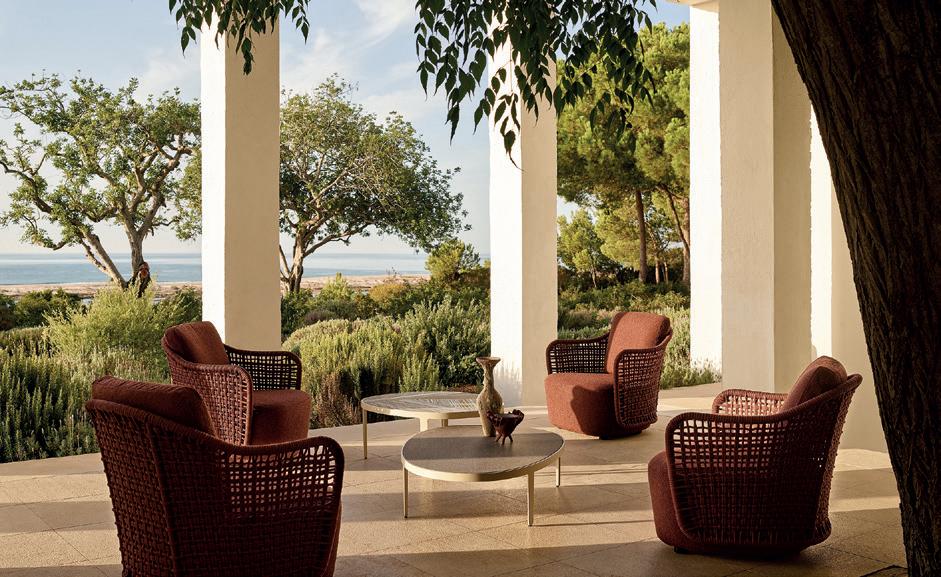
56 | April 2024 FOCUS ON
1
2








The Alps in a fabric
Inspired by the Swiss mountains, the new capsule collection from Fischbacher 1819 has been created. Unveiled as a preview during the Fuorisalone 2024 at the Via De Carmine showroom, “The Drei Berge Collection” aims to capture the atmosphere and allure of mountain landscapes that are so dear to the multi-generational company based in St. Gallen. The capsule is signed by the French-Moroccan designer and entrepreneur Ramdane Touhami, who a couple of years ago purchased and renovated a hotel in Switzerland in Mürren, an ancient Walser settlement located on the edge of
Modern plays of light
In the panorama of bioclimatic pergolas, Pratic’s Carrera stands out as a true jewel of design and technology, redefining the concept of outdoor space, merging nature and architecture in a scenographic embrace. Thanks to its unique covering, it offers dynamic solar protection, with overlapping aluminium blades that dance to the rhythm of the sun, guaranteeing maximum comfort at any time of day. The three-dimensional appearance of the closed ceiling is given by the alternation of fixed and movable blades, which slide and hide with elegance, regulating natural light and air flow. This system
lends itself to intelligent automation, with sensors that adapt to climate changes, to maximise energy efficiency. The structure can be enriched with advanced home automation systems, lateral windows, to perfectly adapt to the desired style.
PRATIC
Hall 22/F19-F21
CARRERA pergola
the alpine glacial area. For this capsule, solid colour and knit fabrics made from 100% virgin wool have been chosen. The fabrics are available in a bright range of colours, which the designer has paired in a bold yet always harmonious way.
FISCHBACHER 1819
Via del Carmine 9
THE
BERGE COLLECTION fabric

58 | April 2024 FOCUS ON
DREI

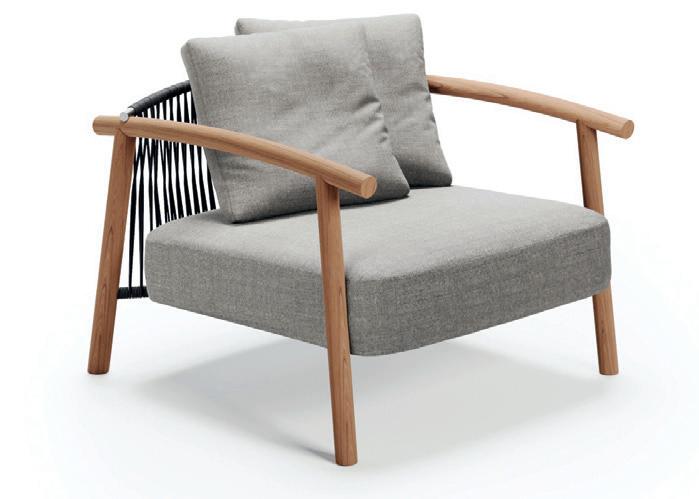
The minimalism of comfort
Three proposals, among many others, that underline the fluid and light soul of Living Divani: Halfsquare, Kasumi, and Ile Club Outdoor faithfully follow the red thread of Living Divani, which has always combined essential design, product quality, and contemporaneity without ever losing elegance and refinement. Ile Club Outdoor represents the quintessence of timeless seating. The first proposal by Piero Lissoni dates back to 2007 and today it presents itself with a new look, such that it doesn’t appear as an updated reissue, but as an absolute novelty. Remaining outdoors, Mist-o proposes Kasumi, a “glow in the fog” (its faithful translation from Japanese), a seat that evokes nature with its del-
The beauty of imperfection
It appears to be born from a mistake, a design flaw. But every detail has been masterfully studied by AMDL Circle and realised by the expertise of Mara. The distinctive feature of the new Typo chair is in fact the “curl” that arises from the bending of the square-section steel tube of the frame. Redefining the archetype of the office swivel chair, Typo plays with contrasts of lines and materials: soft lines draw the backrest and seat, both in wood, and contrast with the bold angularity of the metal frame, giving shape to a composition with a dynamic silhouette. Enhancing its functionality is an
internal mechanism connected to a hook in regenerated cotton that protrudes from the frame and allows the height of the backrest to be adjusted. With this design and in the dual version of chair and stool, the Typo collection lends itself to furnishing residential, hospitality and workspace environments.


icate curves and the harmonious dialogue between the wood and the weave of the structure. Living Divani adds to the complement with Halfsquare, a family of containers that develop vertically, quickly changing roles and uses in both the living and sleeping areas: here again, lightness is the key, and the thin lines of the collection can marry infinite furniture solutions.
LIVING DIVANI
Hall 11/C15-D16
KASUMI armchair, design Mist-o

Multifunctional workstations
Conceived by Giuseppe Bavuso, K-Garden is the new outdoor kitchen model presented in preview by Ernestomeda on the occasion of Fuorisalone 2024. The new collection represents an evolution of the K-Lab project, characterised by equipped worktops that create an efficient and informal kitchen environment. In this new version, K-Garden retains these features, but is enriched with multifunctional workstations, composed of hobs, grills, BBQs and everything needed for outdoor cooking. The project’s distinctive features are its high degree of customisa-
tion and extensive modularity. A series of freestanding open elements can be combined and aggregated together, to form fully equipped islands. Alongside the new kitchen model, there is ample space for new elements of the Sign model, also designed by Giuseppe Bavuso.
ERNESTOMEDA
Via Larga 9
K-GARDEN kitchen, design Giuseppe Bavuso
60 | April 2024 FOCUS ON
MARA Workplace 3.0 - Hall 18/C15 TYPO chair, design AMDL Circle

ligne-roset.com
Collection Pierre Guariche. Made in France
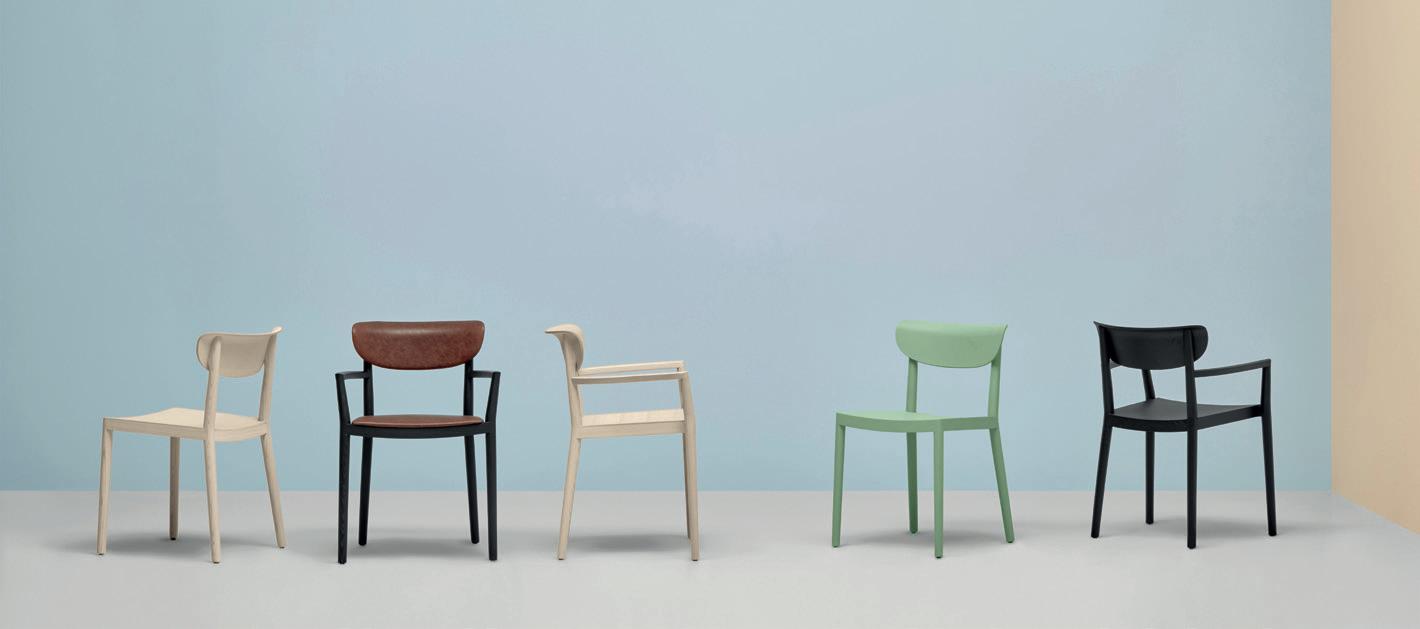
Take a seat!
A universe of seating revolves around Pedrali design: novelties, icons and best sellers create a rich and articulated collection of transversal products for function and style. The 2024 proposals parterre turns the spotlight on the brand-new version of a successful model of the brand, Héra. The seat designed by Patrick Jouin is back on the scene in a new guise with intertwined seat in cellulose cord, in harmonious duo with wood structure – ash or American walnut. The seat thus acquires an even more material, warm and enveloping character, which continues from the base onto the back, made of three-dimensional curved multi-layer, with only 6mm thickness. Other collections emerge with their timeless stylistic strength, on the occasion of their tenth anniversary. These are

Inga and Tivoli, distinguished by materials, united by extreme versatility. Inga, born with a body in multilayer oak or in a soft version characterized by the padded shell, is re-proposed on occasion of its ten years with a new version with a technopolymer shell (in the delicate shades of white, black, gray, sand and powder). The base remains unchanged, with sled frame or four-legs in steel tube, which gives it lightness and informality. Designed by CMP Design, Tivoli is a homage to the masters of design, the result of the meeting between craftsmanship and technological innovation. What defines it is indeed the “infinite back”, in three-dimensional multi-layer. This is a shell made with a special multi-layer curved in two directions, so as to naturally follow the dorsal line adapting to people of all
heights. Pedrali thus expresses itself through a heterogeneous series of furnishings that all lead back to a common ideal of comfort and functionality, the common thread of the entire design by the company.
PEDRALI
Hall 14/A23-B24
1 TIVOLI collection, design CMP
2 HÉRA seat, design Patrick Jouin
3 INGA collection

62 | April 2024 FOCUS ON
1 2 3
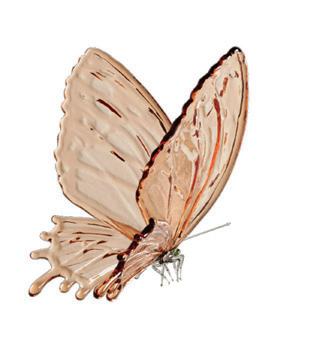
The

temptation is Pesca.
Venini icons are tinged with spring with the extraordinary new Pesca colour.
OPALINO / Designer: Venini / Y: 1932 / Finishing: Glossy. FAZZOLETTO / Designer: Fulvio Bianconi and Paolo Venini / Y: 1948 / Finishing: Glossy, Transparent. MONOFIORI BALLOTON / Designer: Venini / Y: 1970 / Finishing: Sandblasted, Transparent. venini.com
new
Visit us at Salone del Mobile. Milano 16-21 April Pav9 | Stand L06 L08
Art meets functionality
Ethimo revisits its iconic Bold sculptural table by offering the Boldini coffee tables in a mini version. Inspired by the bold megalithic architecture, the Boldini tables enhance the original design, offering new volumes and a wide range of vibrant colours. While retaining the strength of the original model, they accentuate its sculptural impact with innovative shapes. Ideal for outdoor lounge areas, they lend themselves to endless possibilities of configuration and matching. Available with tops in fine marble – French Red, Guatemalan Green or Sand-coloured travertine – they come in three sizes. The glazed ceramic legs harmonise with the tops, giving the design cohesion and dy-
namism. They can exist as single pieces or in a striking triptych composition, always with the possibility of customising the finishes. The attention to detail and the careful choice of materials and colours, which draw inspiration from nature, make the Boldini tables unique pieces, capable of embellishing any outdoor space.
ETHIMO
Hall 22/L22-L24
BOLDINI coffee table



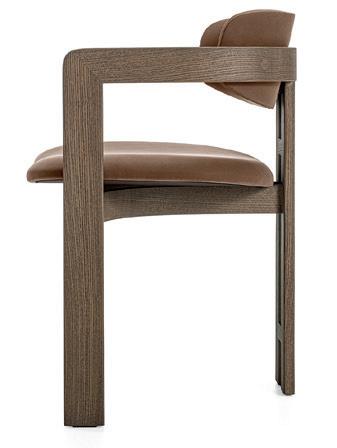
Gallotti&Radice chooses a total colour proposal to celebrate the ten years of two of its bestsellers: the seat 0414, designed by Studio G&R, and the Bolle lamp by Massimo Castagna. Through an unprecedented range of colours that give rise to new combinations, It’s All About Colours aims to pay homage to the history of these
two strongly characterising products for the company. Thus, 0414 defined by clean lines and an enveloping shape, wears new monochromatic proposals in a tone-ontone combination between the curved wooden structure and the seat. The new variants include four colours (Pink Jaipur, Green Provence, White Camargue, Bor-
deaux Etruria) and three shades (Wengè, Chalk and Ash) that complete the collection, thus reaching twelve variants. For the ten years of Bolle, to enhance the transparency of the mouth-blown spheres and coupled with the metal parts, four new shades of colour have been studied: bronze, amber, amethyst and topaz.
GALLOTTI&RADICE
Via Felice Cavallotti 16
Hall 09/F09-G10
1-2-3 0414 seat, design Studio G&R
64 | April 2024 FOCUS ON
2
Ten years in full colour 1 3
















Showroom:




















39 Commerce Cres, Kramerville, Sandton, Johannesburg, South Africa +27 10 600 2100 info@illusso.co.za www.illusso.co.za illusso_za
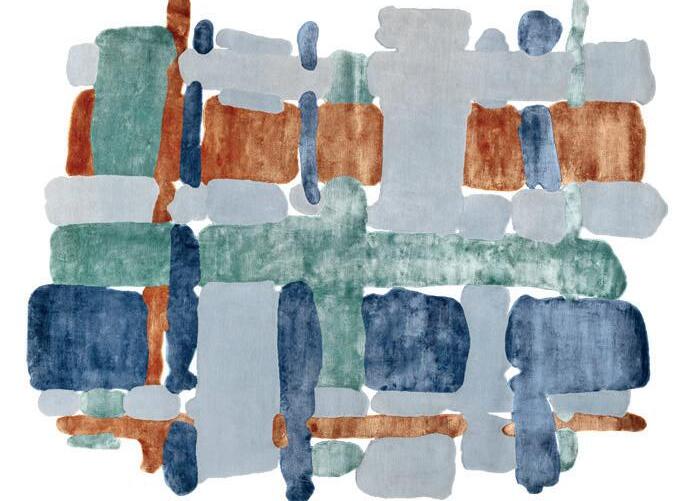
The thousandfold expressions of the carpet
Illulian celebrates its 65th birthday in its renovated showroom in Via Manzoni (as well as at the Salone del Mobile) with a host of new proposals signed by an “onze de gala” of designers. From Paola Navone to Karim Rashid, from Alain Gilles to Ferruccio Laviani passing through Zaha Hadid and MC Plus, just to name a few, they represent the expression of the brand reality. Between geometric patterns and decidedly more decorative and expressive choices, Illulian’s collections are enriched year after year following the demands of
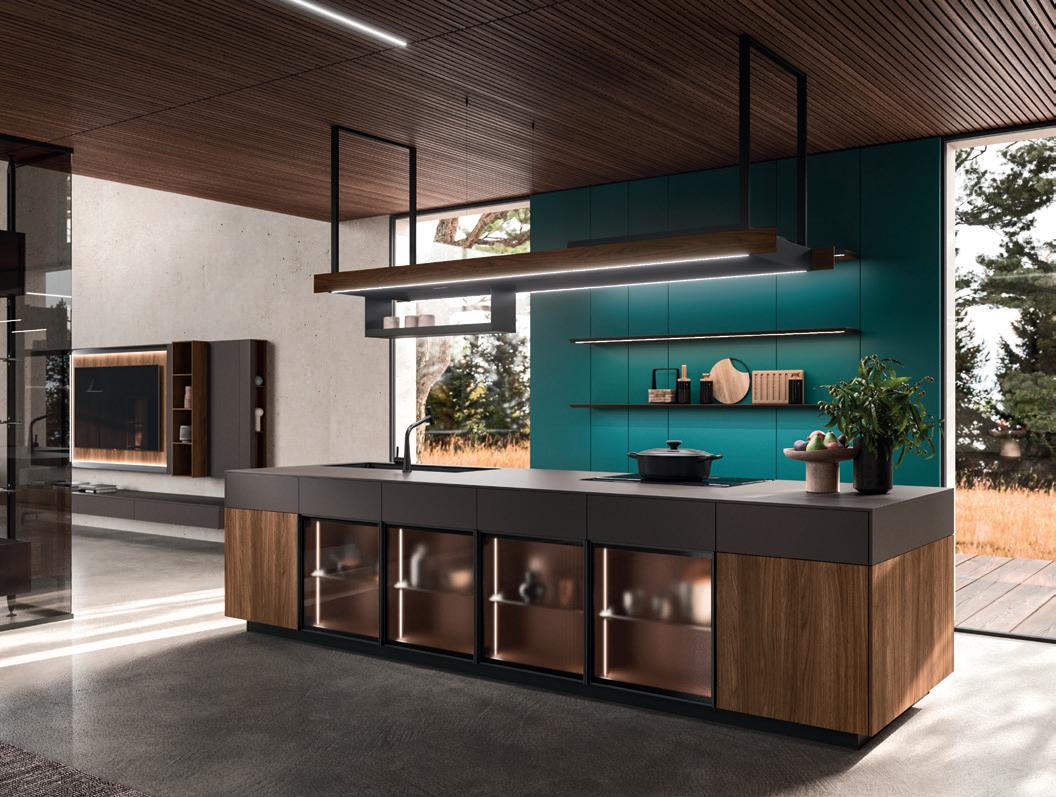
Watchword: experimentation
Arrital’s Ak_Project is updated and expanded to accommodate a multitude of styles, living needs and projects. A concept of versatility and transversality defines the system that, through a single stylistic code, satisfies an extremely wide range of tastes and contexts. Designed by architect Franco Driusso, Ak_Project adds to its aesthetic
possibilities a series of new materials declined in a striped effect, such as the RIGA finish, or the Tecnolineo in matt Pet, but also the Bronze Lineo glass version. The compositional modularity is also enriched thanks to the Boiserie Planar, the Divider System modules, and the Pass System door (in glass). Elements such as the Sipario
storage unit, which elegantly conceals the operative area, or the Divider System with Alu-Table, represented by a sliding table that allows two separate rooms to communicate with each other, create a marked stylistic coherence even in dialogue with the living area.
the reference markets: from residential to hospitality and retail where the “carpet” has gained a prominent place both in its horizontal and vertical applications, increasingly becoming a decisive complement in interior design projects.
ILLULIAN
Hall 15/D18-D20
SYMI carpet, design Ferruccio Laviani

ARRITAL
Corso Europa 22
1-2 AK_PROJECT kitchen, design Franco Driusso
66 | April 2024 FOCUS ON
1 2


Nomadic style
From the union of elegance and simplicity comes Allure, the refined outdoor seat designed for Talenti by Christophe Pillet, one of the most prominent designers on the contemporary scene. A name that reflects the elegance of the product, revealed both in its form and in its materials, and which qualifies as a masterpiece of versatility and design. Everything in Allure revolves around lightness and elegance. The seat’s design offers a visually light appearance, while the elegant texture adds a distinctive touch to outdoor spaces. The harmonious contrast between the aluminium structure and the padding translates into a sophisticated and essential style result that does not go unnoticed. The choice of aluminium, not by chance, underlines the brand’s strong commitment to sustainability. Allure is distinguished by its incredible ease of movement, offering endless possibilities for configurations, all without sacrificing the strength conferred by aluminium. The variety of colour solutions promotes Allure’s versatility. Among these, the cold and fascinating Mambo Pearl shade stands out, which contributes to reinforcing the charm of the creation. Presented at the Salone del Mobile in Milan, the Allure chaise longue and from the first glance it was clear that
it was an ode to practical sophistication and untamed taste. But Allure is not just a seat; it is an authentic testimony to Italian allure, an emblem of the elegance and charm that made in Italy design has brought to the international scene. Talenti’s intent to create timeless pieces and the constant focus on the quality of materials and attention to detail are reflected in Allure. What emerges from Pillet’s own words is painted precisely: “The new lounge chair, ample and generous, speaks a clear and coherent language with the rest of the collection. Allure has a raw and, at the same time, summery, beachy touch, but in a different sense.” A clear example of how design can combine elements that are apparently in contrast with each other and transform them into something harmonious and fascinating.
TALENTI
Hall 24/M02-M04
1-2 ALLURE seat, design Christophe Pillet

68 | April 2024 FOCUS ON
1 2
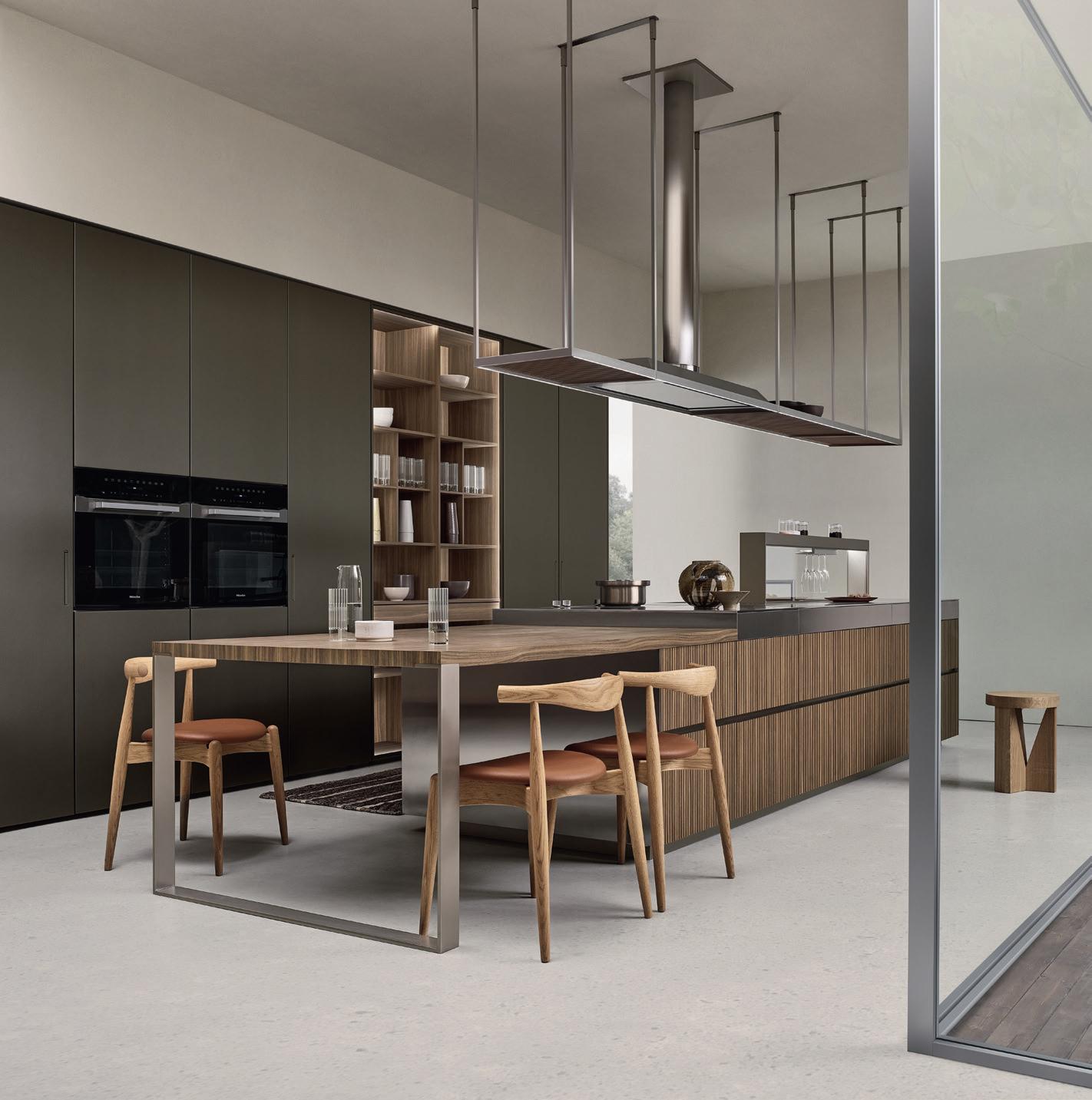

Light as the wind
Taking inspiration from the lightness and movement of the wind, Alessandro Stabile has imbued each piece with those qualities, resulting in Brezza, a collection that represents a significant step forward in eco-sustainable furnishings. The series comprises a chair, a lounge armchair, a two-seater sofa and a coffee table, and is characterised by the use of eco-sustainable materials. The emphasis on circular production is evident: the cushions are easily removable and attached to the frame without the use of glue, buttons, zips or Velcro. Completing
the collection is a low table made of cement or HPL, which amplifies the sophisticated aesthetic of the line. Brezza features fabrics made from recycled yarns, with the introduction of two new variants created from recycled post-consumer materials.
S•CAB
Hall 03/D12-D14
BREZZA collection, design Alessandro Stabile
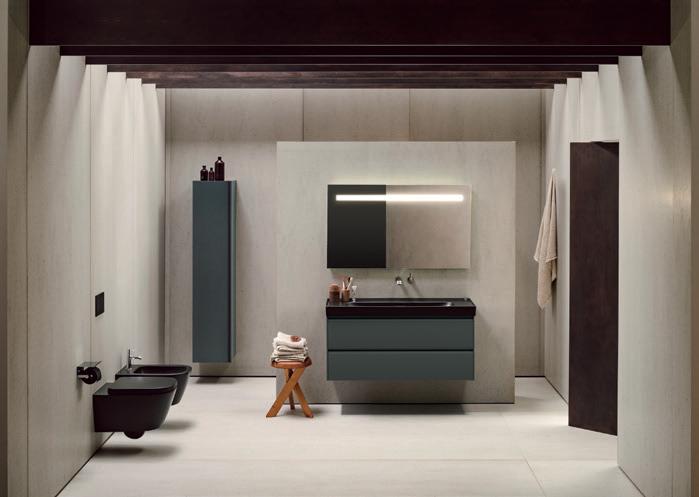
A symphony of serenity
Masterpiece of art and innovation, Venini’s Pesca collection draws inspiration from the ethereal hues of sunrise and sunset, encapsulating the essence of nature’s most tender moments and transforming them into exquisite glass craftwork. It seamlessly weaves the charm of the past with the freshness of the present. Its vases, with their fluid and transparent contours, echo the timeless beauty of classic forms, while delicate contemporary touches infuse a sense of modernity. Each piece in the Pesca collection is a testament to the remarkable craftsmanship of Venini’s master glass-makers. With meticulous precision,
they morph molten glass into works of art, capturing light and unveiling the inherent magic of this extraordinary material. Pesca represents a harmonious blend that transcends trends and resonates, creating a symphony of serenity in the environment where the collection’s elements are placed.
VENINI
Hall 9/L06-L08
PESCA collection
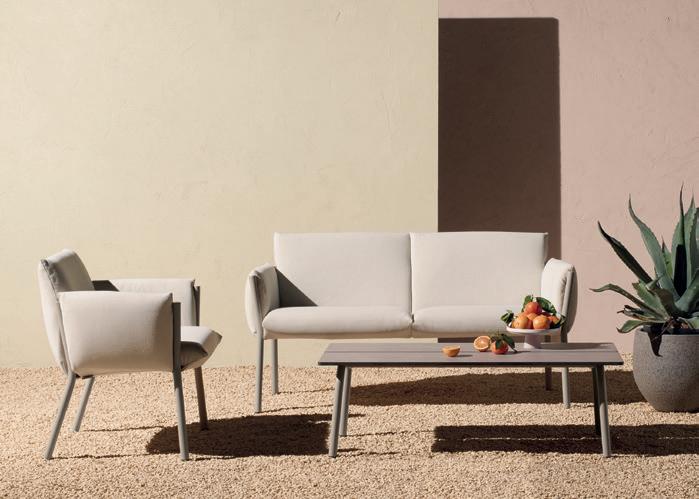
Harmonies of contrasts
Peter Wirz and Laufen have been collaborating for 20 years. A synergy that over time has allowed them to create innovative collections together, such as the complete PRO programme or the Cleanet Riva and Navia shower toilets. Today, Peter Wirz and the group of professionals working in the multidisciplinary Vetica studio, are taking the exploration of the brand and its productive possibilities to a new level, with the design of Meda, a complete system of ceramics, taps, and furniture. The stylistic signature of the collection is the skilful alternation of sharp, precise lines and soft shapes, resulting in a timeless, essential design that’s above all extremely modular. The
washbasin perfectly illustrates this concept: it has a squared outer profile, in contrast to the wide inner basin with its delicately shaped, rounded corners; moreover, it’s available in different variants characterised by a certain asymmetry, which caters to the need for a wide support surface.
LAUFEN
International Bathroom Exhibition Hall 10/B21-C16
PRO programme, design Meda, Peter Wirz (Vetica Studio)
70 | April 2024 FOCUS ON
ILBAGNOALESSI
DESIGN STEFANO GIOVANNONI
LAUFEN.IT

FUORISALONE | MILANO DESIGN WEEK
APRIL 16-21 | 11-21H, SUNDAY UNTIL 17H
LAUFEN SPACE MILANO VIA ALESSANDRO MANZONI 23, 20121 MILANO
COLOUR ARCHAEOLOGY AN INTERDISCIPLINARY JOURNEY THROUGH ART, DESIGN, ARCHAEOLOGY AND THE HISTORY OF COLOUR IN CERAMICS BY ROBERTO SIRONI. IMAGINATIVE VISION OF STUDIO LYS AND BEDA ACHERMANN.
SALONE DEL MOBILE 2024 MATTER BY SNØHETTA HALL 10 / STAND B21 C16
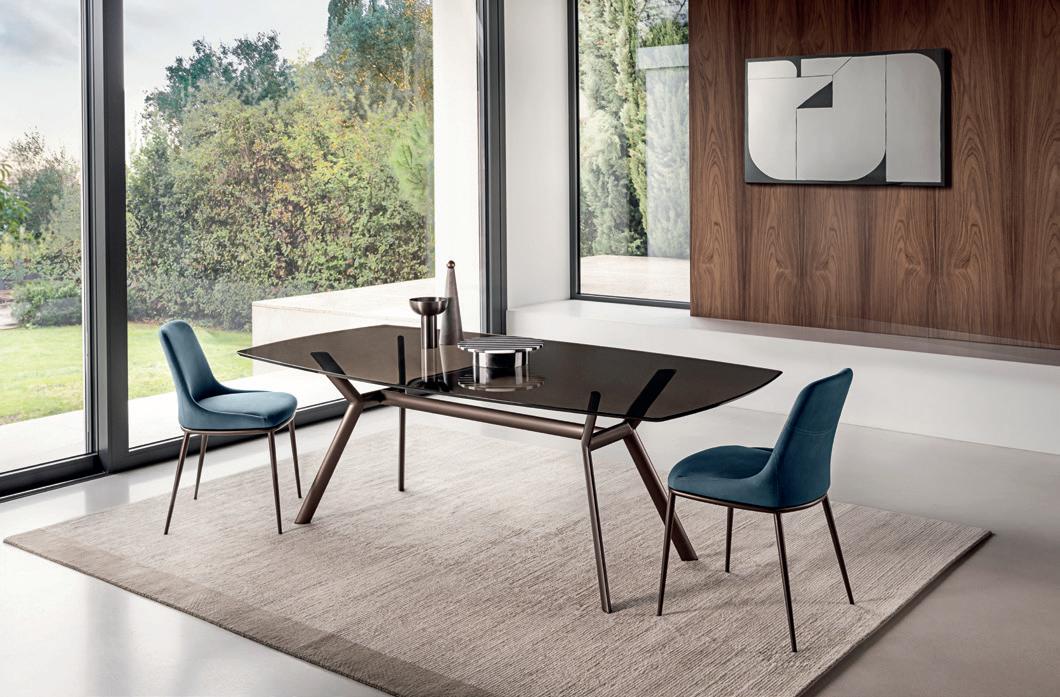
The magic triangle
Always in the vein of the dynamic and engaging relationship between object, person, and space, Riflessi’s native journey lands in Milan for Milan Design Week 2024. The company presents the latest novelties in its Milanese showroom on Corso di Porta Romana, and a particular focus is deserved by the new Paradise table, a synthesis of the company’s strategy embodied in the product: richness of materials and finishes for objects that speak the language of uniqueness and customisation. Paradise is

the work of the Riflessi Design Lab and is represented here alongside the Sofia chairs (designed by Stefano Sandonà and Sabrina Bettini) with bronze legs and a Nubuck L54 leather seat. The top of Paradise, available in a wide range of variants, is customisable to the centimetre in the fixed version to fit best in rooms of any size in the name of maximum design flexibility and is also available in an extendable version. The base, made from aluminium extrusions, is unique and inimitable: Riflessi has chosen
to invest in specific moulds that guarantee maximum aesthetic cleanliness together with the best performance.
RIFLESSI
Piazza Velasca 6
(corner of Corso di Porta Romana) PARADISE table

OUTDOOR, THE MATERIALS TAKE CENTER STAGE
With the creative direction of Vincent Van Duysen, the 2024 outdoor collection project by Molteni&C continues its path of connecting the indoors with the outdoors. The main actors of the new proposals are the materials: solid natural shade teak converses with aluminum profiles and hand-woven polypropylene ropes. The inclusion of ceramic for the new Picea coffee table, a sculptural monoblock crossover to the whole collection, is particularly noteworthy. The new entries also include the Petalo armchair, characterized by the weave of polypropylene ropes, the Fairmont table in solid teak, and the two Cobea seats in teak essence and Boboli proposed as a sofa-armchair. The Canadian duo Yabu Pushelberg adds to the collaborations for the 2024 outdoor collection, signing the modular Sway sofa system, with fluid and layered lines.
MOLTENI&C
Corso Europa, 2 Hall 24/A09-C10
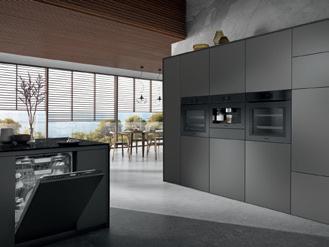
PULSE OF EVERY KITCHEN FOR MIELE’S 125TH ANNIVERSARY
Refined design’s apex
The Liz collection, an exclusive debut into Giorgetti’s world by designer Silvia Musetti, is a triumph of elegance, harmony, and functionality. The collection, enchantingly comprising of furniture pieces that exude a fusion of materials and form of remarkable balance and refinement. The collection’s central element is the elegant Liz-valet. A sculptural object that amazes for its versatility and practicality. Beautifully composed of two cylinders of different heights, it features a lower cylinder in Canaletto walnut with a leather top, along with a taller leather-coated cylinder with optional backlighting. Liz-valet highlights
a thoughtfully designed functionality, evident through a slightly raised edge, creating a sort of change tray for small items. With the addition of two leather-coated rods for hanging trousers and suits, Liz-valet completes the experience of an elegant, yet notably practical, piece of furniture.
GIORGETTI
Giorgetti Spiga - The Place via della Spiga 31 LIZ-VALET valet tray, design Silvia Musetti
Founded in 1899, Miele reaches its 125th anniversary this year. With a 900 square meter stand at the fair and at FuoriSalone through activities organised at the Miele Experience Center, the brand celebrates this milestone by presenting itself at Milan design week with “The Pulse of Every Kitchen”, a format that invites reflection on the evolution of household appliances throughout history. From an initial concept where the product was perceived as a useful tool exclusively for carrying out a function, to the current one where it is experienced as an object capable of contributing to the atmosphere of the environment, through lines, finishes and technological innovations. Alongside the line integrations presented at the stand, Miele is launching 125 Gala Edition, a series of promotions introduced on the occasion of the anniversary to make consumers an active part of the celebrations.
MIELE
FTK, Technology For the Kitchen Hall 02/A02-A04
72 | April 2024 FOCUS ON
ONE PAGE


One Page, design Ron Arad 2O24
Galleria Rossana Orlandi via Matteo Bandello 14, Milan
Photo Alessandro Paderni / Dancing Flowers by Massimo Gardone
Moroso Showroom Milan via Pontaccio 8-10, Milan
Milan Design Week 16-21 April 2024

Expanded home
Kettal’s project has taken the gazebo and transformed it into a more refined and advanced form, turning it into a sophisticated, complex, and versatile external architecture: Pavillion H. With this project, the company offers a completely customizable space that adapts to any context, perfectly blending with the surrounding environment. The aluminum structure of Pavilion H stands out for its lightness and brightness. The wide range of options for the cover (waterproof, aluminum, wood, etc.) and for the side panels (fixed or sliding, in various materials) allows for 360° customization. The structure is enhanced by various light models for lighting and a wide choice of colors for finishes. All of this is available tailor-made to meet the specific needs of the user.
The goal of Kettal Structures is to bring order, form, and structure to outdoor areas, functionally designed to provide shelter. Their mission is to shade and refresh or protect from rain and wind. The series of pavilions was designed with the aim of further aligning the system with architecture. This series has specifically developed tools to integrate it into an architectural context and create fluid outdoor spaces. What sets Pavilion H apart is its advanced technology equipment. This system allows you to control and automate the bioclimatic system, the integrated lighting, the curtain system, the heating, and the ventilation of the spaces. These features offer significant advantages in terms of efficiency, safety, and strength, ensuring a perfect atmosphere for outdoor environments. The Kettal Pavilion H is not just a motorized pergola, it is an extension of the house. With the addition of connectivity, it is possible to create an extra room that can be used all year round. The functions of the pergola can be controlled via the new Kode app, which allows for perfect management of the integrated features of Pavilion H’s intelligence, whether it is home environments or workplace spaces.
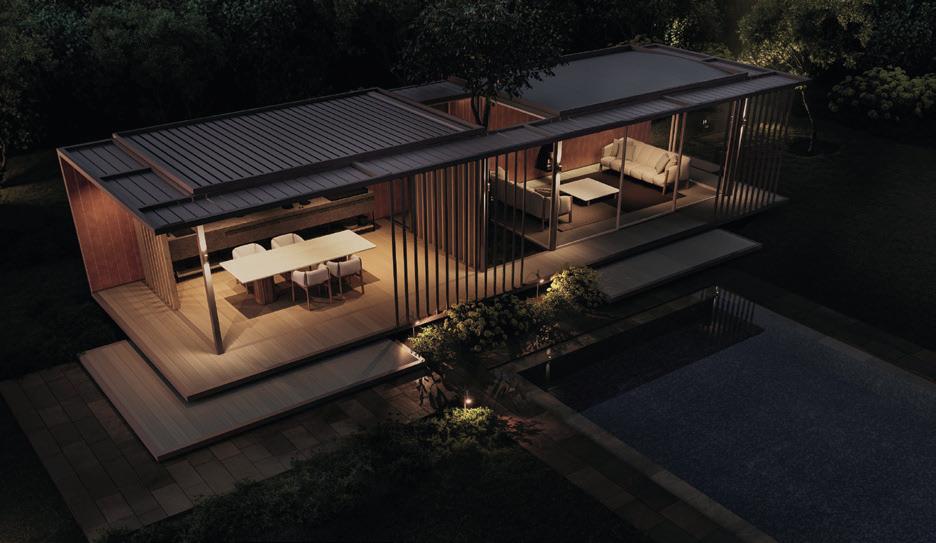
74 | April 2024 FOCUS ON
1
Hall 24/C11-D10 H pavillion 2
KETTAL

Homage to the Costa Brava
From the collaboration between Roca and Andreu Carulla comes Tura, a bathroom collection with an essential design characterised by linear shapes, smooth contours, clean lines and earthy textures. The name of the collection derives from the ending of two closely interconnected Spanish words - arquitectura and cultura - where architecture is an integral part of Catalan culture. From this, the identifying feature of the collection is expressed in the designer’s desire to reinterpret and pay homage to the landscape of the Costa Brava. Confirming the Spanish brand’s attention to considering the environmental impact in
every process, the various pieces of furniture are distinguished by the use of FSC®-certified wood and new materials, such as recycled fabrics for the cushions and felt boxes with cork lids, in addition to the use of Roca Rimless® Vortex, which optimises the flow of water and the efficiency of rinsing.
ROCA SANITARIO
Hall 10/B19-C12
TURA collection, design Andreu Carulla

Ode to imperfection
Perennials and Sutherland present Wabi Sabi, the new Spring 2024 collection of fabrics and rugs made from 100% dyed acrylic, as well as a selection of outdoor furniture. With a strong reference to the imperfection celebrated by Japanese aesthetics, the collection revolves around the idea that objects gain personality over time and through wear. Basing on this concept, the fabric collection introduces four new textures - Kikko, Arigato, Paper Crane, and Sake Stripe - and 19 new color variations inspired by nature. The collection also in-
cludes Tatami and Taki, two new designs of versatile and highly customizable rugs. Designed by creative director Eugeni Quitllet, the Wabi Sabi outdoor furniture collection uses teak and aluminum as a vehicle to play with shapes created by light, and includes four seats, a pouf, and a coffee table.
PERENNIALS AND SUTHERLAND
WABI SABI collection, design Eugeni Quitllet

The virtuous heritage
Ligne Roset showcases Pierre Guariche’s visionary design realm that married refined design with industrial production at Milan Design Week. In partnership with Mohd, an exhibit featuring Guariche’s chairs, tables, and lamps manufactured by Ligne Roset is displayed. The Papyrus chair (1951) was the first French wooden chair designed in a single piece, the iconic Tonneau chair (1953) and the G10 armchair (1953), characterised by modularity, are just some of his creations that will be displayed. The exhibition will also feature the Vallée Blanche chaise longue (1963), which represents the quintessence of relaxation and the Jupiter armchair (1966).
In addition to the seating, the re-editions will include the Sideboard Credenza 148 and the Extendable Dining Table 125, and the Bahut Galerie M.A.I (1952), designed to be used as a radio cabinet, picnic and disco furniture, will be on display, with a redesigned interior layout, offering guests a fascinating incursion into the past.

76 | April 2024 FOCUS ON
LIGNE ROSET
Ligne Roset from Mohd Milan. Via Turati 3 SIDEBOARD CREDENZA 148, design Guariche

@gallottieradice #gallottiradicestyle
Flagship Store via F. Cavallotti 16, Milan
Salone del Mobile.Milano 16 — 21 April 2024
Fiera Milano Rho, Hall 9 Booth F09 - G10

Style evolutions
Keel, taking its design inspiration from the hull of a boat, the part which it is named after. The table collection by Marmo Arredo is already an icon of the brand, yet it’s continuously evolving. Stefano Boeri Interiors expands the family with new materials that lend even more rigor and essentiality to the new model, alongside a surprising sensory quality. Made of marble or quartz, the tabletop joins metal legs that introduce the concept of visual lightness, in a play of joints that respond to the perfect quest for balance. This piece of furniture clearly
shows the industrial precision that defines Marmo Arredo, together with the deep know-how of Scapin Group (to which the brand belongs) in the processing of marble, granite and composite materials.
MARMO ARREDO
S.Project - Hall 01/F08

Relationships at the center
The kitchen is increasingly the heart of the home and of domestic life. Scavolini’s new Stilo kitchen, designed by Spalvieri & Del Ciotto, interprets this ideal, enclosing a convivial spirit, open to relationships and encounters, in its essential and geometric lines. With Stilo, the kitchen is no longer
just the space where meals are prepared, but thanks to the combination of different furnishing elements, it becomes the place where people socialise and even work. A distinctive feature is the pure form of the cylinder that horizontally and vertically traces the design scheme, giving life to
handles, shelves, desks, lighting bars and equipped for organising utensils. The two shades, black and titanium, offer a dual aesthetic expression, respectively sophisticated or more delicate and natural.
SCAVOLINI
EuroCucina - Hall 02/A15-B12
STILO
78 | April 2024 FOCUS ON
CHIGLIA table, design Stefano Boeri Interiors
kitchen, design Spalvieri & Del Ciotto

I ggy sofa K I m arm chair I an bookshelf D I ve console P assenger coffee table design | castello lagravinese me Da | tor I no | bresc I a | Pa D ova | roma | s I nga P ore | lugano call now +39 0362 333082 an D ma K e your a PP o I ntment at the showroom www . bertosalott I . I t ad : c astello l agravinese s tudio ph : s tefano t onicello
Renaissance of marble
Conceived by designer Raffaello Galiotto, the Frammenti collection by Margraf pays homage to history and ancient architecture, drawing on the beauty and unique nuances of marble. The collection comprises three design pieces: a table, a seat and a column, made by assembling fragments of marble joined together by an elastic element. Each element in the collection evokes the power and nobility of marble through contemporary lines. The table, made of Fior di Pesco Carnico marble, stands out for its elegant shades, which range from white to grey and light pink. The seat, made of precious Polaris Gold quartzite, is characterised by its intense veining, with variegated tones
ranging from yellow to green. Completing the installation is a magnificent column in Notre Dame marble, which captivates the eye with its dark veining of profound beauty. This collection is a brilliant demonstration of Margraf’s ability to combine advanced technology with artisan mastery.
MARGRAF
Hall 18/E08
FRAMMENTI collection, design Raffaello Galiotto

Lighting couture
The Gems lamp collection by Penta, designed by Francesca Lanzavecchia, is a testament to the sophisticated art of lighting design. These unique pieces, crafted from monolithic crystal, offer endless combinations thanks to their interchangeable components. The collection comprises six distinctive elements: three diffusers of varying sizes embrace a light source composed of a sphere and a cylinder. Gems lamps emit a soft glow enhanced by gentle hues and plays of light, creating an enveloping atmosphere and stimulating the imagination with their ethereal reflections. They project subtle transparencies and gradations of col-

Daytime outdoors
Poltrona Frau collaborates with GamFratesi on the Mirabell collection, seamlessly blending indoor and outdoor design. This timeless collection follows a design dialogue initiated in 2018 with the Italo-Danish duo the company from Tolentino has long been familiar with. Mirabell extends its indoor range of leather baskets, Cestlavie, with outdoor sofas and tables. The sofas take inspiration from 20th-century French wrought iron seating, now reinvented in contemporary aluminium forms. The tables feature a lava stone top or, optionally, a metal one, the structure rests on a double foot (like the sofa) and its support curve is a clear distinctive element. Cestlavie Outdoor faithfully
follows the footsteps of the indoor parent, the materials change and its use flexibility – as a low table or a container - make it the perfect partner for the entire collection.
POLTRONA FRAU
Via Manzoni 30 MIRABELL collection, design GamFratesi
our onto the surrounding walls, akin to the effect of a kaleidoscope. Despite their complexity, they exude an airy elegance, comparable to that of delicate jewels illuminating a space. Echoes of a pearl necklace are revealed in a mesmerising play of refracted light dancing across the lamps.
PENTA
Via S. Damiano 2
GEMS lamp, design Francesca Lanzavecchia

80 | April 2024 FOCUS ON


Mondsee, Austria. 30th July, 3 pm New comfort and total privacy. Perspective from your point of view.
AD Designwork –Photo concept Eye –Copywriting Carter&Bennett
YOUR INSIDE, OUTDOOR
Bioclimatic pergola Connect pratic.it
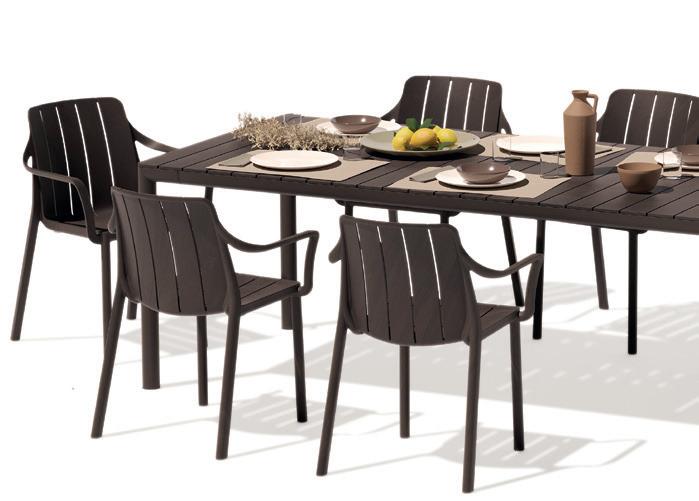
Open-air sophistication
Created in the image and likeness of the sweet life outdoors, Nardi’s Tevere and Tiberina creations are a masterpiece of design, durability and sustainability. This garden set stands out for the elegance of its soft, rounded lines. Thanks to the Tevere extendable table and the coordinating Tiberina chair, it is possible to furnish any outdoor space with great personality. The table, resistant to atmospheric agents, is designed for maximum durability. Its top is resistant to knocks and scratches, making it ideal for hosting your outdoor events. In addition, the table features an intuitive and simple extension sys-
tem, which allows you to increase its size without moving the legs. The heart of this set lies in the materials chosen: recyclable polypropylene and aluminium, highlighting the company’s commitment to reducing its environmental impact.
NARDI
Hall 18/D23-E22
TEVERE table and TIBERINA seat, design Raffaello Galiotto
The shapes of decoration
Don’t just call them rugs. These creations are genuine expressions of art and craftsmanship, the imaginative outcomes produced from a depth of creativity, and the fruits of traditional weaving savoir-faire, wherein each single knot is meticulously handcrafted. Such new introductions further diversify the Sahrai collections, faithfully preserving the brand’s signature stylistic ethos. Like the new Pretty Shell, a piece belonging to the Underwaterlife Collection. This collection is specially curated to enhance nautical spaces and summer residences. Its distinctive freshness and lightweight character along with an inspiration derived from nature and the maritime world are cohesive elements that unify the entire line. But what also defines the proposal is a peculiar attention to materials: Pretty Shell is indeed hand-tufted in bamboo silk loop and embossed bamboo silk.
SAHRAI
Hall 15/C19
PRETTY SHELL rug

82 | April 2024 FOCUS ON

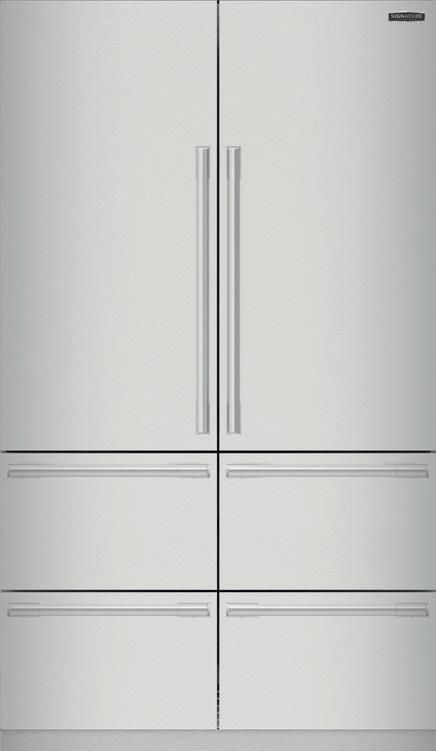

A jewel of freshness
Representing the perfect balance between aesthetics and functionality, combining advanced technology and exclusive design: this is the French Door 48” by Signature Kitchen Suite, the new high-end refrigerator that surprises with its 735-litre capacity, distributed among five separate compartments. The double-door refrigerator offers a refined organisation system, with adjustable shelves and Crisper drawers. The large spaces, inte-

grated cold water dispenser and LED lighting ensure practicality and efficiency. The three freezer drawers, on the other hand, offer precise temperature control and a practical ice-maker for ice cubes or spheres. Special mention goes to the convertible drawer, which can be customised to store different types of food at the ideal temperature. In terms of aesthetics, the glass and stainless steel interiors stand out, prestigious materi-
als that ensure hygiene and optimal preservation, all conveniently managed via Wi-Fi.
SIGNATURE KITCHEN SUITE
via Alessandro Manzoni 47 1-2 FRENCH DOOR 48 refrigerator

BOFFI|DEPADOVA CELEBRATES 90 YEARS OF BOFFI
The 90 years of Boffi represent a symbolic milestone as they celebrate the founding of the original nucleus of Boffi|DePadova, built through a strong projective vocation in the sign of traditional design and the synergies put in place. Synergies that have contributed to the history of the brand and returned as protagonists on the occasion of the Salone del Mobile: Zaha Hadid with her Cove Kitchen, Patricia Urquiola with Salinas, Elisa Ossino with a re-design of Xila, a model designed by Luigi Massoni in 1972, Claudio Silvestrin, who perfects the series for the Fiumi bathroom and Piero Lissoni who presents the new Novanta kitchen system for the occasion.
BOFFI|DEPADOVA
Via Solferino 11 Via Manzoni 17

THE NARRATIVE INTERTWINING OF DRAGA&AUREL
Sophisticated grandeur
Uniqueness in design is embodied in a new storage solution: an imposing and distinctive cabinet, finished in a brilliant white that exudes elegance. Its surface, as lustrous as a mirror, makes this solution a focal point that enhances any setting. The feature that immediately catches the eye is a captivating detail: a leather bow tie that acts as a central decorative element. This touch of softness offers a delightful contrast to the solid, polished texture of the entire unit. The pure aesthetic is further enriched by components finished in 24-carat gold, representing a symbol of unparalleled splendour. Despite the sumptuousness of its appearance, the cabinet’s functional-
ity does not take a back seat. The unit is equipped with a circular handle featuring a biometric opening system, a symbol of impeccable security. Inside, the cabinet reveals itself to be a veritable jewel box, with a series of lined drawers and a pull-out leather jewellery case, complete with meticulously stitched handles.
AGRESTI
Hall 15/M20
Power of colours and pictorial gestures compose the intertwined narration of Draga&Aurel, hosted since mid-April in the Wunderkammer of Visionnaire. A continuous exchange of roles between art and design guides the visitor through an immersive path that opens with the Tessa separè, a cascade of colours, lights and transparencies. The installation continues with the Lego console, re-proposed with a marble top combined with metal, while the Elysium table features contrasting geometries and textures. The Aries armchair is upholstered with an original hand-loomed fabric reinterpreting the works of Aurel K. Basedow, while the composition of the Muse screen is entrusted to a layering of printed organza. “I worked as a textile designer for a long time,” explains Draga Obradovic, “so it was natural to imagine bringing Aurel’s works onto fabric.”
VISIONNAIRE
Piazza Cavour 3
84 | April 2024 FOCUS ON
1 2
FIOCCO storage
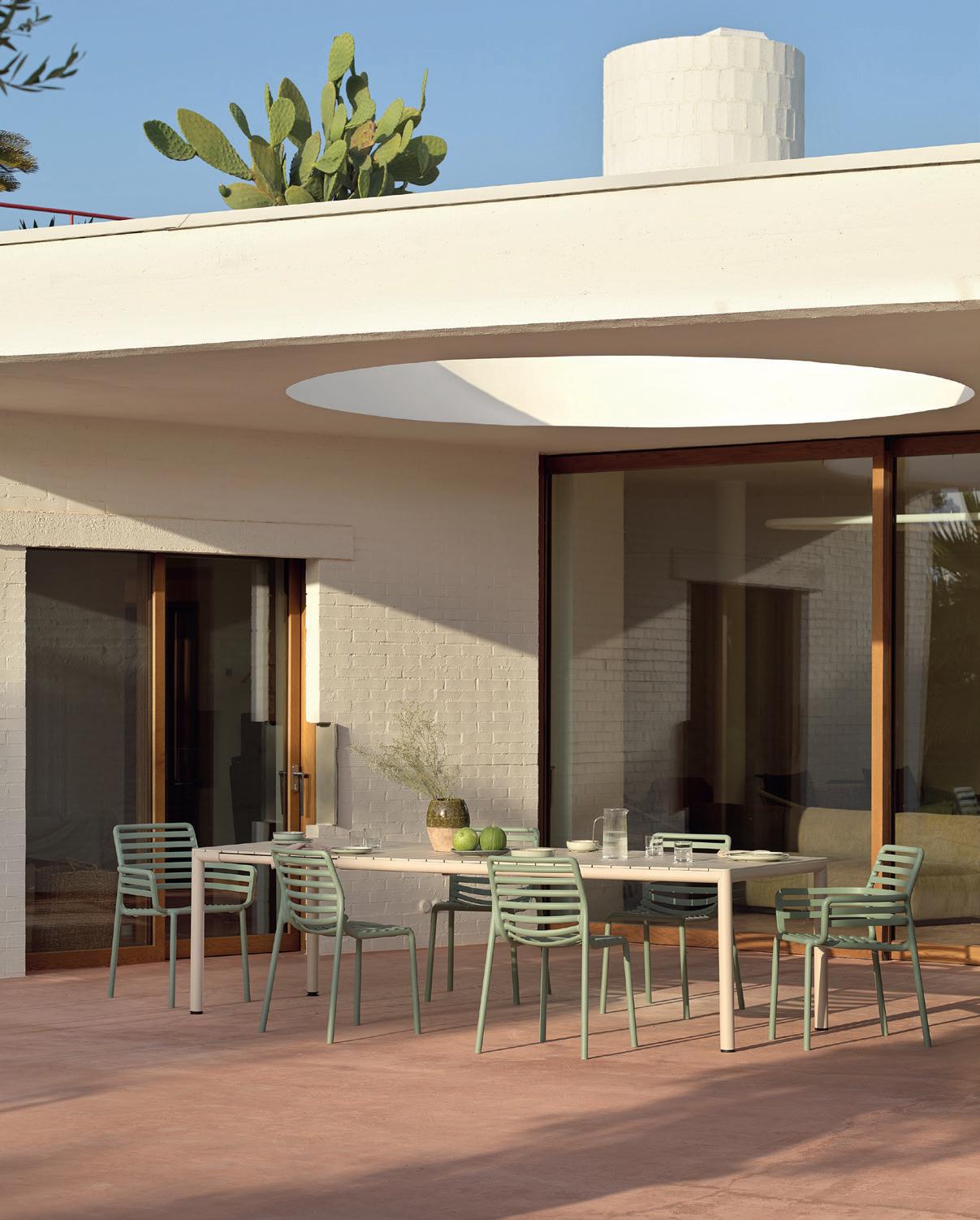
Contemporary tradition
Antonio Citterio revisits a classic furnishing piece – the folding chair, harmoniously combining contemporary appeal and Italian fine woodworking, realised by Flexform. Thus Lauren is born, an elegant seat in its apparent essentiality, but refined in every compositional and material detail. Lauren is indeed composed of a solid wood structure, turned and hand-finished, enhanced by the armrest in metal covered in leather, as well as the seat and backrest, created with great craftsmanship. Even all the metallic hardware is custom-designed, a detail that adds
further value to the project. The result is a sophisticated piece of furniture, capable of fitting into any environment of the house and aligning with any style while maintaining a strong personality.
FLEXFORM
Hall 09/E05-E11
LAUREN seat, design Antonio Citterio


Pure aesthetics
The design league welcomes a new player: the Reel series by Amphora. The latter shines as an emblem of innovation in the bathroom accessories sector, anticipating trends and highlighting technology and essential forms. With a 316 stainless steel matrix, each element stands out for its clean lines, ensuring function and elegance. Created thanks to the talent of Studio Adolini, masters known for their relentless exploration of expressiveness through minimalism, this collection is a testament to a unique symbiosis with the Ponsi family, artisans for generations. The dialogue between these two entities has given life to accessories that not only satisfy aesthetic taste but also embody a commitment to sustaina-
bility and careful functional analysis. Each element of the Reel series emerges as a tribute to the elimination of the superfluous, reduced to its purest essence. Every single detail has been meticulously refined, achieving an exquisite balance that seals its success in terms of aesthetics and functionality.
AMPHORA
via San Marco 28
REEL series, design Studio Adolini & Fratelli Ponsi
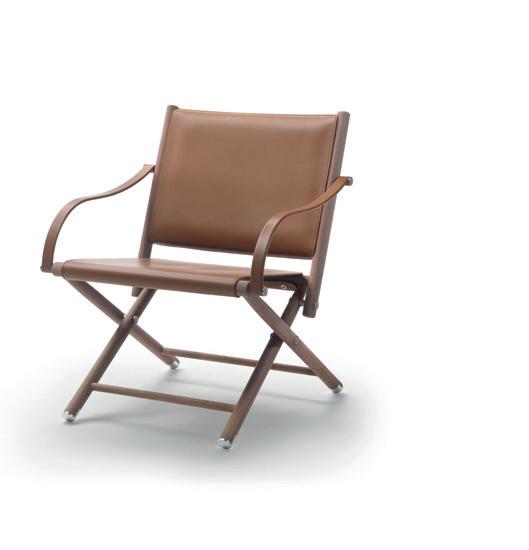
Eco-chic reimagined
Splendour, elegance and functionality intertwine in the timeless aesthetic of the Blues washbasin. This piece conceived by Devon&Devon is reborn in its new incarnation, matured through the innovative use of White Tec Plus, a technology that gives the surface an appearance similar to natural stone. This green-oriented interpretation, which includes vegetable resins derived from corn starch in its essence, has been awarded the Green Guard Gold certificate by LEED®. This eco-friendly vocation does not sacrifice beauty or durability. On the contrary, longevity is ensured by its
resistance to yellowing and ease of cleaning, and thanks to the inclusion of titanium dioxide, it exhibits natural antibacterial and antiviral protection. This piece enhances both modern consoles and vintage-style creations, such as the Single Memphis in turned brass.
DEVON&DEVON
Hall 10/A10 BLUES washbasin

86 | April 2024 FOCUS ON

pentalight.com
GEMS
— Francesca Lanzavecchia

B/W VISION
As a child, says Niccolò Biddau, he never spoke: he observed. He started taking photographs when he was still at school and has never stopped since. As time went by, his interest focused on architecture, town planning and industry. This led to his research on design, which he then collected in a fascinating book.
by Ruben Modigliani
by Niccolò Biddau


For Niccolò Biddau, the act of looking is an investigation into the essence of things. Born in Turin in 1966, he inherited his passion for photography from his father. So, after high school and a degree in political science, he decided to make it his profession. And from 1998 he began to focus his research on urban landscapes, sculpture and interior photography. Increasingly in black and white. In 2002 he began to focus his work on the production cycles of Italian companies: a world he explores with encyclopaedic commitment (to date he has photographed around 600 of them, from all sectors). Fifteen years ago he founded his own publishing house, Photo Publisher, with a catalogue of around twenty monographic titles: “To have autonomy”, he explains. The images on these pages come from a major project of his, which later became a volume (Design Made in Italy,
Photo Publisher, 2022) linked to design, which crosses many of Italy’s manufacturing excellence: fashion, food, automotive. And, of course, the world of furniture.
How did this project come about?
The beginnings actually go back a long way. In 1999, while photographing cities, I realised how much people had forgotten the presence of industry in the urban landscape, now replaced by something else. And I had the desire to tell this story in a book, which, together with photography, has the extraordinary power to tell stories that remain. I spoke about this project at Confindustria Torino and Assolombarda, and the companies opened their doors to me. I never asked for anything, and vice versa; I chose to work on shared reflections with them. During a presentation on the urban transformation of Milan’s suburbs, it was suggested that I focus

88 | April 2024 PORTFOLIO
photo

on design. Given my interest in the ‘behind the scenes’ of production, it immediately seemed like a good idea. Then Covid came along, but I took the idea further. At some point, in April 2021, I left: it couldn’t have been a worse time. We didn’t know if there would be an exhibition, the companies were in a frenzy, it was a race against time. And by the time we went to press, the price of paper had shot up. Nevertheless, a first edition was born, allowing us to chart a course, to show how design shapes all areas of our lives. It is a study of form and matter, but also a study of design, of the peculiarities of brands. This was the thread that ran through the project.
Some of these images are completely abstract.
The most abstract of them all is the profile of the border strips of the Flou beds. Rosario Messina, who was still alive, understood it
perfectly. There is nothing immediately recognisable in the picture, but we notice the perfection of every detail: engineering and design. The photo was taken by observing an absolutely random composition of these bands, resting in a warehouse of materials. There has to be emotion and information in a photograph. I find that these images are silent, but you can imagine the noise of the factory, which is almost always there. This is the photographer’s task: to maintain concentration even in complex environments, to continue to observe, to capture.
Then there is the beautiful shot of the Up armchairs by B&B Italia.
The focus is on polyurethane foam, the material that Busnelli introduced as a major innovation in the sector. If you go by subtraction, you get to the essence. In the end, it is the many that make up a single image.
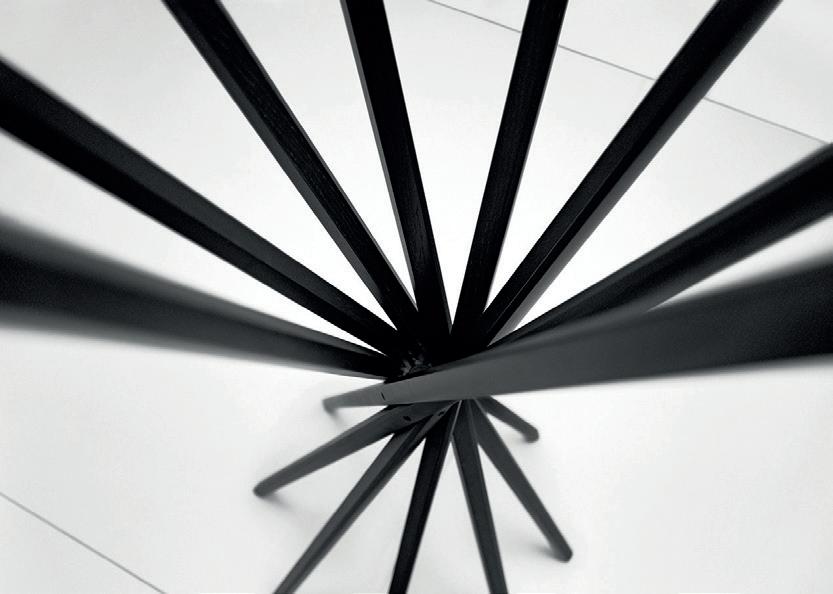
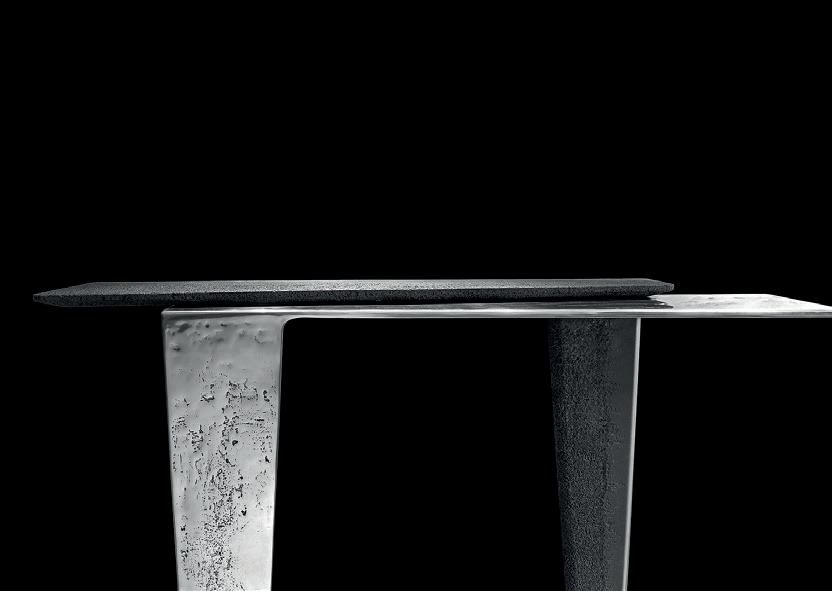
And black and white helps to highlight certain situations, it creates something magical. The less the photographer tries to make a critical comment, the better. When I approach a design object, I do so with a basic knowledge, but I never want to go further, lest I be influenced. This is where the power of the material speaks.
Where does this almost philosophical vision of photography come from? I was very lucky because from a very young age my parents took me to discover beauty, in Italy and abroad. My mother used to say: “As a child, you never talked, you just observed”. Photography was my father’s great passion and I studied many of his photographs from the fifties and sixties. I tried, perhaps unconsciously, to capture this impulse to observe. The journey, the landscape: elements that are captured and then
discarded. I started studying photography in high school, and after high school I took a ticket to Singapore, Malaysia and Indonesia and disappeared for three months. That’s when I did my first reportages. As time went on, I realised that I was more interested in architecture, urbanism and industry. So I specialised and refined my language. And I continued. With passion.
From top left, clockwise: UP armchairs by Gaetano Pesce, B&B Italia; detail of the Flou materials warehouse; lacquering of an element of the Ola 20 kitchen by Pininfarina, Snaidero; Lego console by Draga & Aurel, Visionnaire; Striped marble wall cladding by Elia Nedkov, Neutra; Sciangai coat stand by De Pas, D’Urbino & Lomazzi, Zanotta; detail of the PostKrisi lamp by Enzo Catellani, Catellani&Smith; Otto pouf, Paola Lenti.

April 2024 | 89

Marva Griffin: close encounter with the woman who invented the Salone Satellite
by Ruben Modigliani
How did the Salone Satellite come about?
In the latter half of the 1990s, what later became known as the Fuorisalone began to be created: companies that were unable to be at the Fiera created their own space and a new way to take part in the event was born. Among these were a number of young designers, some just out of school, they wanted to show their own creativity to the manufacturers. For them it was very difficult. Those who could afford it took over spaces in the most unthinkable places, like the slaughterhouse for example… Many of them, that I went to see when scouting for the magazines I was working for (American House & Garden, Maison & Jardin…), also knew I was involved in the Salone; I had organised the Salone del Complemento d’Arredo and other things with Manlio Armellini. So a lot of people asked me how to get into the Fair. I wanted to do something for, and with, them. One day Armellini called me and said “Marva, the Fiera has given us a pavilion for holding special events. See if it could be good for your project with the young designers”. That’s how Satellite was born. Now every fair has something similar but at that time no institution was looking out for the young.
What has determined the success of the Salone Satellite? 25 years is a lot…
It seems like yesterday to me. The manufacturers arrived early in the morning, they took an object, a chair, lifted it up, touched it, tried out a lamp. The relationship with a young designer started like that. And this worked especially with the Italian entrepreneurs. That are the ones that everyone wants to work with.
Why?
First of all because Made in Italy is a guarantee. And then the approach that the Italian manufacturer has towards them is unlike anywhere else in the world. Konstantin (Grcic, editor’s note) told me that Eugenio Perazza, the founder of Magis, was like a father to him. Even with quite strident discussions: when Perazza asked him to design a chair he replied “I don’t want to do another chair”, something superfluous. And that clash gave rise to the wonderful Chair_One. This is what the young find with Italian manufacturers.
How many famous designers came through the Satellite?
There are so many, I’m not going to name any names because for me all 14,000 who have come through are of value.
The best thing in these 25 years?
When I open a magazine and I see the work of one of those young people, or when I receive a letter of thanks from them. The satisfaction of seeing that their dreams have come true.
The Salone Satellite Permanent Collection is on display at Lentate sul Seveso. It wouldn’t be bad if this collection found a location closer to the city… No way! They have created the school, they’ve created the space. It is only right that it is there. You can go to Lentate, there’s a train. Even the foreigners go, they arrive by bus.
Plans for the future?
I live in the present. And hope to be able to make lots of other dreams come true.
90 | April 2024 TALENT HUNTER
Simon171 Read the full interview online C M Y CM MY CY CMY K

agresti.com
LUXURY SAFES
New kids on the block
China
COSMO CROSS
A multidisciplinary studio that combines boutique retail, the cooperation of home furnishing brands, an artistic design agency, the development of original products, business management and consulting services for the design of spaces. In keeping with contemporary lifestyle, they take inspiration from everyday life. “We believe that ‘fusion’ allows us to be unbridled and create works full of sur prises”. Cosmo Cross is to be unveiled at the Satellite, the most distinctive works from the Galaxias and Origin series, inspired by spaceships, Möbius strips and cracks in space and time. Design as a story that tells of the history of the birth of the universe, depicting its infinite beauty, imbued with artistic meaning and a perception of different dimensions. Taking inspiration from the spaceship, “Spacecraft” integrates the essence of the indefinite future and exploration of interstellar space, as if embarking on a journey through time. Taking the mysteries of the universe into private space. cosmocross.com

We have selected 12 of the new exhibitors to this year’s Salone Satellite. Young designers from India, Egypt, Singapore, China, France, Norway, Japan, Iran, Taiwan, Argentina, Switzerland, Canada: a world tour of creativity. Between the revival of ancient traditions and a keen eye for sustainability. Twelve personalities, all different, united by one desire: to leave a mark with their ideas
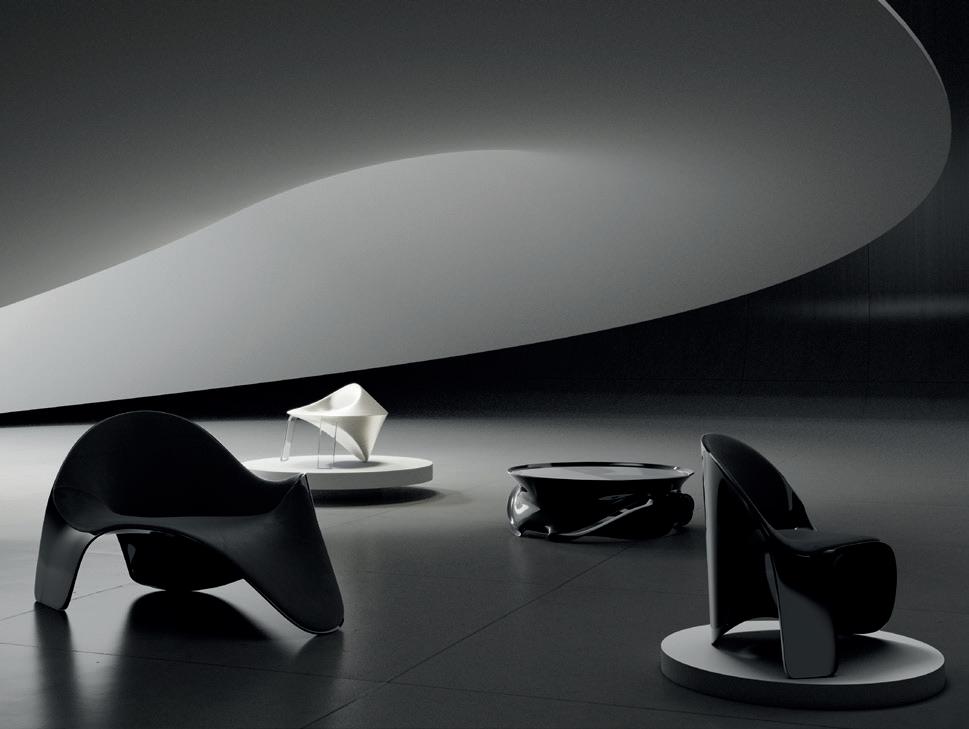

Winner of multiple awards worldwide for SHELL HOMAGE - of which she is founder and CEOin other words biodegradable materials based on egg and walnut shells that substitutes plastic, born out of her research project at TU Berlin. Applicable in multiple sectors such as lighting and interior design, furniture, accessories for the home, consumer goods, 3D printing, fashion, jewellery, the colours come from food waste such as fruit or vegetable peel, herbs and plants. Her eclectic creations are inspired by different cultures and styles. shellhomage.com
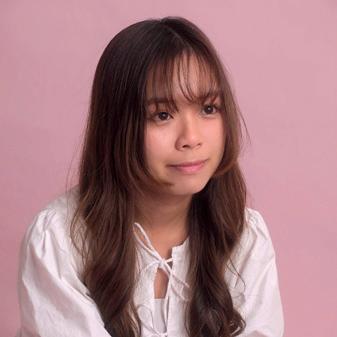
Singapore EMELINE ONG
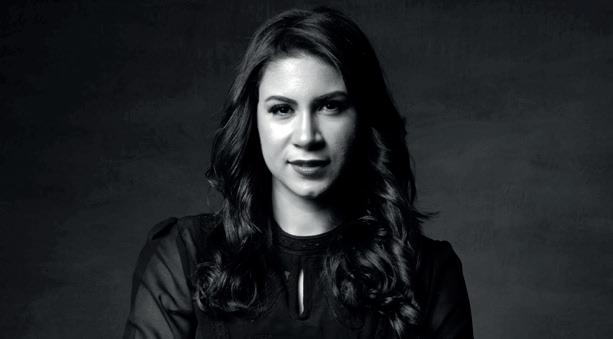
Emeline Ong sees the world through an eccentric lens, combining wonder and functionality, her creations have roots in experimentation and intuition. Inspiration is revealed in one of her passions; sweets, translated in her work through the use of vibrant colours. An example is the Pastille collection, on show at the Satellite, made up of a series of monolithic tables decorated with minimalist graphic lines made with delicate forms and inviting colours, contrasting with brutalist furnishes. Sculptural elements that blend femininity with rawness. linkedin.com/in/emelineong

92 | April 2024 RISING STARS
Egypt RANIA ELKALLA

India
LOOPS BY LJ
A brand based on an idea of Latika Jagwani, a young designer who started in fashion attending the Pearl Academy in Mumbai and then Torrens University in Australia. Loops by LJ started in 2022 as an Instagram page that evolved into a brand that is constantly growing. Latika’s journey is fuelled by a desire to infuse creativity and a sense of “craziness” into carpets, making them a bespoke and attractive piece of decor. Her philosophy embodies the perfect integration of functionality and aesthetic appeal with the idea that each piece has to arouse emotion and stimulate the imagination. loopsbylj.com


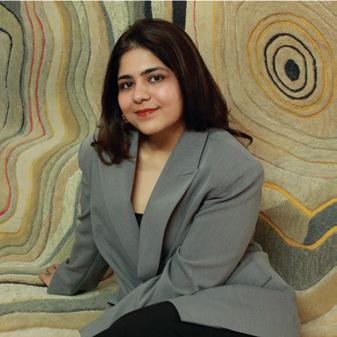
Taiwan DISHAN STUDIO

Iran SIN-A STUDIO
Po Cung Chen, after completing his Masters in Industrial Design at the Designskolen Kolding, founded Dishan Studio in Copenhagen but due to the pandemic returned to Taiwan, continuing in service design. The key words that sum up his design philosophy are simple, playful, understandable and sustainable. “Since returning to Taiwan we have worked with numerous local industries that range from the materials development to craft, platforms for social planning and government agencies. I think that design has the power to unite different backgrounds to imagine a better and more sustainable world”. And sustainability is one of the most important values that the studio aims to achieve, redefining the perception of waste materials. On display at the Satellite are designs that combine local materials with waste such as 3D printed furniture made with oyster shells and waste matter, a system of modular furniture constructed with cement-free slurry, mats made from textile waste in collaboration with Unami Studio. dishandesign.com
Raised in Teheran and fascinated by Iranian culture that is translated into his creations, Sina Karbasian launched “SIN-A STUDIO” after having obtained a Masters in Architecture. His passion comes through in every project: pieces of furniture appear like genuine miniature works of architecture, as if they were totemic elements. His creative ideas take shape when he draws by hand, still using pen and paper and his designs are deeply symbolic like the Saggha collection of lights, selected for the Satellite, designed with respect for every “star” that we have lost on our journey. sinastudio.art
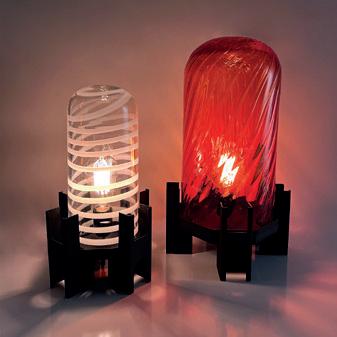
April 2024 | 93 Photo © Sayher Heffernan, Ville Vappula
Norway EDVIN KLASSON
A designer based in Oslo, with a Masters in Industrial Design from The Oslo School of Architecture and Design, who works in the furniture sector. In his design he explores symbolism, history and cultural heritage, expressed through creations for producers and artisan workshops. At the Satellite he presents Arp, an armchair that follows the form of the body in a single line: despite the sculptural and solid aspect, the core of the chair is “elastic” and designed to provide comfort. Passaic meanwhile is a table that achieves stability by adding a heavy element to the base like stones, earth or gravel, unique for every user. edvinklasson.com

Japan HANA MITSUI
France BITSCH STUDIO
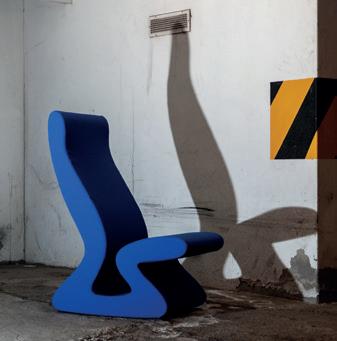

Arthur Bitsch, founder of the studio opened in Strasbourg in 2021, graduated from ESAD Valenciennes and ESADSE Saint Etienne and is influenced by the industrial heritage of these cities. His work embodies principles of conceptual and sustainable design, with a particular focus on the production of objects. “I believe that design has to fuse the conceptual and mystical strength of the artist with a production logic rooted in its time”. He will be appearing at the Satellite with HILLEL, a limited edition lamp - part of the Altar series - that aims to ritualise everyday objects. bitsch.fr
Born in 1990 in the United States, in Connecticut, Hana completed a Masters at the Royal College of Art in London where she designed a fabric that won over Alexander McQueen, used in the fashion brand’s SS 2015 collection. After returning to Japan, she worked for seven years in textile and bag design at ISSEY MIYAKE, after which she founded the Hana Textile Design Studio in Tokyo, in 2023. Hana is also a Visiting Professor at the department of Textile design at the Tama Art University and as well as for the clothing industry, she also collaborates in the interior design and architecture sectors. Transforming traditional Japanese fabrics into a contemporary de sign, at the Satellite Hana presents a fabric collection for interiors that induces optical illusions, made using offcuts from industry. hanatextiledesign.com

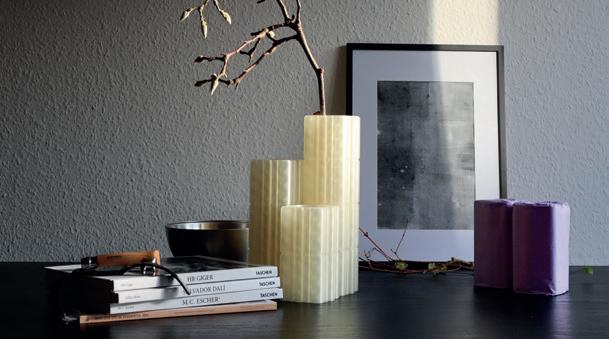

94 | April 2024 RISING STARS
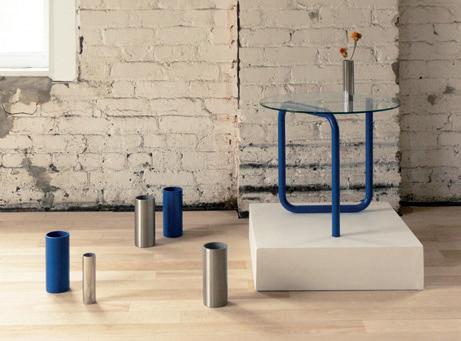
Canada
SMALLMEDIUMLARGE STUDIO
Graduates from the École de Design de l’UQAM in Montreal, in 2023 Sharlene Dupont-Morin and Juliette Mondoux set up smallmediumlarge, a multidisciplinary studio that offers design services for personalised products, integrated spaces and installation design. Revisiting archetypes and reinterpreting what already exists, the designers use high-quality and hardwearing materials to create a pure aesthetic, experimenting with forms and materials. The result is collectable pieces that are sustainable and shaped by local artisans, such as the Spag table whose tubular continuity of the single support is highlighted by the transparency of the top. smlstudio.ca

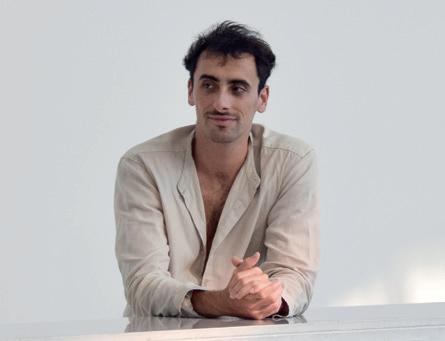
Argentina BILU

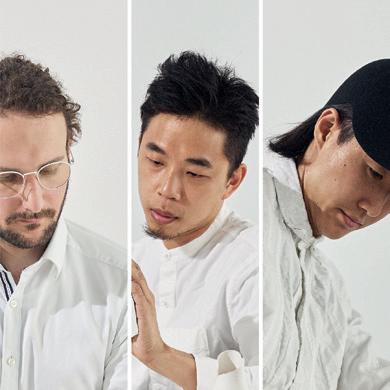
The DDD collective explores design in a holistic way, combining backgrounds in consumer electronics, the manufacture of eyewear and the arts, and is made up of Jean-Paul Brković, a German designer and artist based in Zurich, passionate about products, archetypes, sustainability and the principles of engineering; Yosuke Shimano - an eyewear designer from Osakawho explores materials, forms and a new aesthetic for innovative eyewear; Chen-Ta Hsie (who lives in Taipei) a multidisciplinary designer focused on consumer electronics produced in Taiwan, taking an artistic approach. “We give priority to the creation of objects that harmonise within spaces, celebrating the unity of our different skills. Our work promotes multiculturalism, to create a world where creativity knows no limits”. Innovation guides the creative process of DDD as can be seen in the UTO armchair made with recycled plastic or the Totem mirror and Faces Table made with technologies used for the production of eyewear. @ddd_collective
Ignacio Martínez Todeschini - who has a degree in Industrial Design from the University of Buenos Aires (UBA) - loves to explore and innovate. Founder of the studio, he has experience in various sectors: design, 3D printing and carpentry. His creative approach has led him to an intersection between art, technology and sustainability and nature is his source of inspiration. At the Satellite he will be presenting various collections including Ombo, conceived following the natural growth process of the Ombú tree, to create an illuminated sculptural element. @bilu.luz

April 2024 | 95
Switzerland DDD
FORM, FUCTION& SOUL
WHAT IS THE EVERYDAY USEFUL OBJECT YOU APPRECIATE THE MOST, AND WHY?
“A good project does not come from the ambition to leave a mark, the mark of the designer, but from the desire to establish even a small interchange with the unknown person who will use the object we have designed”: so wrote Achille Castiglioni to define what he believed was a proper approach to design. Not by chance, the product of his design that made him proudest was a small light switch created in 1968 with his brother Pier Giacomo and produced by VLM, a company specialized in the sector of electrical components. It was a small item produced in large numbers, purchased for its functional qualities, and no one, not even the dealers, knew who had created it. An everyday, familiar object that summed up the great master’s attitude. And it allowed him to enter the homes of everyone, becoming such a widespread presence that it belonged more to the people than to the history of design. Castiglioni was a curious person, and throughout his life he collected what he called “anonymous objects,” namely things we use day after day without knowing who designed them, though we are still attracted by their simplicity and functional quality. As well as all the emotional aspects that make the object pleasant and interesting. Even special, sometimes. Hence the question we have asked various international design studios to answer: What is the everyday useful object you appreciate the most, and why? The answers were far from expected, and they formed a tableau: that of beautiful, functional, but also poetic and timeless design. Objects that surround us in our everyday lives, things we would never want to do without. Some have famous creators, others are anonymous. The outcome is a long list of things that have always populated our daily existence, from water bottles to pencils. Some of them are able to make us dream, others are purely functional. All of them have a meaning, which in the end reflects the idea of design held by the people who answered our question. Because design, real design, always starts with basic reasoning, with the idea the creative professional wants to transmit. And perhaps, by observing these “cherished” objects with which people surround themselves on a daily basis, we will also be more capable of understanding the designer’s job. And to appreciate the results achieved. Never taking them for granted. Even an apparently simple chair does indeed contain a small piece of the soul of its creator.
by Marina Jonna

ANTONIO ARICÒ
1 . A primitive graphic pinwheel. A Senegalese fan that rests when closed and dances when open to a rhythm of lines and colours. I often like to combine decorative emotion with the function of objects. This fan is a miniature work of art and its graphic immediacy makes it both classic and modern. The natural colours surprise as well as reassure with a hypnotic rhythm. For me it’s an iconic object. 2 Among others things there will be Oasiblu: an installation in collaboration with Fromm (in via Savona 35); with Seletti I will be presenting the latest additions to the Magna Graecia collection and for Agave, in collaboration with Sturm Milano, I will be presenting a new chair and an armchair. Also to celebrate ten years in my Milan home, I will be opening Casa Aricò to the public, in the Nolo district, via Nicola d’Apulia 7a.
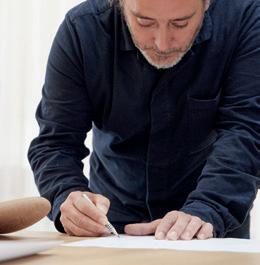
BARBER OSGERBY
1. The pencil, we rely on it to sketch ideas and convey points. Often our discussions unfold through sketching, allowing us to develop ideas with the simplicity of a pencil. For us, design is about creating objects that are inherently useful, beauty follows naturally. 2. We will be introducing two new Glass Lamps for Flos; for Marsotto Edizioni we will be presenting our Largo tables. Emeco will be celebrating their 80th anniversary exhibiting the On & On chair; B&B Italia will be presenting Tobi-Ishi Outdoor in two new materials along with our Button tables. We are also excited about working with Cappellini on the reissue of the Bottle Table and Cassina will be unveiling a lounge version of Tamburound.
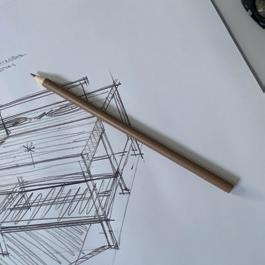
GIUSEPPE BAVUSO
1. It’s not easy for a designer to pick out just one object that can represent a sort of synthesis of their relationship with the world of things: there are lots of everyday objects that are able to improve the quality of actions that, in a ritualistic way, accompany us in our daily lives. If I have to choose one in particular then I like to think of the pencil, a tool that is essential to my everyday activity. Using the hand, the pencil allows me to express and give shape to ideas, establishing thoughts and reflections. It is an object that has remained virtually unchanged since the 16th century. With absolute simplicity, made from just two materials, wood and graphite, with no superfluous elements. Whether it is round or hexagonal, it represents total simplicity, minimalism associated with efficiency. No ambition to be a protagonist but a humble and discreet everyday companion, active and hard working. 2 . Among the various projects that we are bringing to the Salone is the new K-Garden kitchen for outdoor use designed for Ernestomeda. A kitchen conceived and designed with the aim of replanning new outdoor spaces for conviviality, with a more expansive and international vision and that represents an evolution of the K-Lab project.

GIULIO CAPPELLINI
1 . The everyday object that in my opinion is an example of good design is the San Pellegrino water bottle: simple, beautiful, practical, outside of any fashion or trend. It has always been with me. 2 . Among the new Cappellini 2024 products, I really like the X Table System, a collection of small tables by Hsiang Han because it shows how technology can be used to create artistic forms. The components of the base, in moulded recycled nylon, create genuine compositions, light but impactful.
DESIGN/LIFE 96 | April 2024
courtesy of Fredericia

CRISTINA CELESTINO
1 . The lemon squeezer in pressed glass. It entered homes in the 18th century and is still an object whose design is unsurpassed, ribbed to extract as much juice as possible from citrus fruits. It is easy to clean and beautiful to look at! 2 . I have designed some new finishes and floors for Fornace Brioni that will be presented as part of the Grounded exhibition: two different designs, one more linked to the geometric world and the other connected to the random nature of the painted mark. For Gervasoni I will be presenting the Plumeau armchair and for Fendi Casa I have designed the Ottavia chair. Finally for Manital I have created the Matrice handle, which is inspired by the marks and organic relics left by time.

MATALI CRASSET
1. A spoon by Jonas Wauthy, a cabinetmaker, made from cherry wood. The work was done with a blade, without abrasives that leave silica in the fibres. 2/3 coconut oil and 1/3 beeswax. Jonas Wauthy has sold many spoons to women who have undergone chemotherapy and become allergic to the taste of metal, no longer able to tolerate its taste on the palate. A spoon that, in a way, repairs. 2 . My research continues into seating with Campeggi, where we’ll be presenting Le Temps de la Communautè. Since the late 1980s I’ve been campaigning for objects that are nomadic, transformable, that adapt to the way we live and allow spaces to be configured in new ways. This project is about inviting us to ‘make community’. A structure to provide the possibility of an “us”.

JACOPO FOGGINI
1 . Every morning I use a small Greek brass saucepan to heat up water to make tea. I love it because it reminds me of Greece, the wind, the sea, the blue of the sky. It is an object that has always existed and that they continue to make and use in exactly the same way. It has absolute simplicity, this is the design I love the most.
2. I will be presenting the Rivers collection of candlesticks at Edra Spazio Durini. At the Statale, I am doing an installation together with Massimo Iosa Ghini.
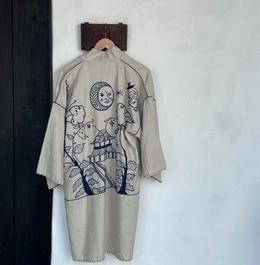
JAIME HAYON
1 . Any everyday object can give me inspiration. For example I found a small sewing machine in a far away temple where I had gone on a meditation retreat. And I made a jacket that I really love! 2 . I will be presenting some pieces designed for Wittmann and BD Barcelona.
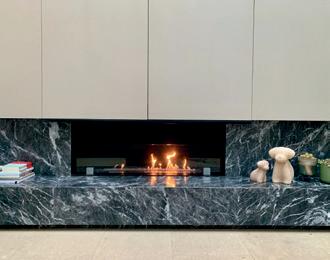
SETSU & SHINOBU ITO
1 . The fireplace we designed with Marmo Grigio Carnico, it gives us warmth all year round together with WAN dogs (sculpture) also designed by us for Riva1929.
2 . At the Salone we will be showing the TE’ table, chair and stool we have designed for Désirée.

LUCA NICHETTO
1. I can say my Unimatic watch! Ever since the company gave me this watch I have worn it constantly. It has become my everyday companion. It is sturdy and well-designed and I don’t want it to be anything other than a good watch. It is neither too big nor too small, it’s just perfect. The fact that it is made in Italy is quite unusual for a watch which makes it even more special. My encounter with Unimatic was quite spontaneous. I was in Milan to look at some prototypes for other clients after having taken part in an event in Stockholm where I had the opportunity to discover the brand and handle the products directly. I made a couple of contacts so that I could explore this young but very cool brand, I visited them at their headquarters and eventually became a proud user of their creations. 2. We are preparing an installation for Kerakoll and we are excited to announce that we will be presenting new designs for Cassina and Ethimo during Milan Design Week.

1
. At the risk of sounding annoyingly nostalgic, an everyday object that is almost invisible but with an enormous subversive charge, is that small rectangular block in paper called the “book”. In a world that is progressively dematerialised, the readers of paper books are still ⅔ of the total. That little square object is still capable of changing lives! 2 . A lot as usual but I would like to mention one: recently my studio won a competition to design the Pediatrics department of the New Policlinico Hospital in Milan, in collaboration with the Fondazione G. and D. De Marchi ETS. By mutual agreement we will be presenting an installation inside the State University in Milan, previewing what we will create in the department dedicated to children and their families.

DRAGA & AUREL
1. Draga - The Ptolomeo bookcase by Bruno Rainaldi: here the object steps aside to make way for the element for which it was created: the book. Aurel - My Breil watch, I have worn it on my wrist everyday for thirty years, it is the first gift I received from Draga. It marks the passing of time and I think in some ways it has recorded the passing of MY time, with the damage and deterioration of the surface. 2. At the Rossana Orlandi Gallery there will be a project created with Giuliano dell’Uva; at the Nilufar Gallery in via della Spiga, we have curated an exhibition. At Visionnair we have created the exhibition itinerary of the Wunderkammer. There will also be new and important collaborations such as the one with Poltrona Frau, with whom we will be unveiling a modular sofa, and with Giorgetti.
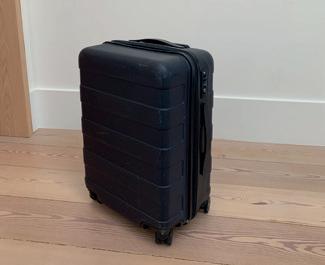
GABRIEL TAN
1. I travel frequently for work, and a good suitcase is essential. Muji’s focus on minimalism translates into a clean, streamlined design that prioritizes what matters - luggage for efficient and effortless travel. I have been using my Muji Hard Shell suitcase for over a decade and it is still in good shape and still wheels around really well. The lightweight polycarbonate shell and the spinner wheels make manoeuvring through busy airports and train stations a breeze. Muji’s Hard Shell suitcase prioritizes functionality without sacrificing aesthetics. This philosophy is something I strive for in my own design work – creating objects that are useful, beautiful, and also enhance the user’s experience. 2. The Luva Sofa and Cyclade Tables for Herman Miller, and the Chester Coat Stand for Schönbuch will be presented at this year’s Salone.
April 2024 | 97
FABIO NOVEMBRE
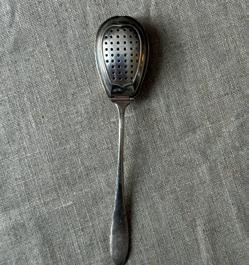
FEDERICO PERI
1. A teaspoon dating back to the early 20th century. I find this object extraordinarily intelligent, functional and at the same time pleasing. This spoon has a rounded, perforated head that has been designed to hold the tea while it steeps in the cup. I often use it at breakfast or after dinner. 2 . For Baxter I will be presenting a family of containers, the evolution of a range of wave lighting, wall mirrors and a multi-functional piece of furniture that will be called “weekend”. For the Nilufar gallery, the Butler chair; a sofa for Bentley home and accessories for Marta Sala Edition. Finally, in via Palermo 11, there will be my installation for Carpanese Home. I will also be taking part in the initiative in piazza San Fedele: Second life: 10 trees for 10 designer totems.

MATTEO RAGNI
1. The 9090 cafetiere by Richard Sapper for Alessi: every morning in the studio it gets us off to a good start. The second coffee, after the one at breakfast, is now a ritual that is difficult to renounce. 2. We will be presenting the Canalgrand bed for Twils (with Tiziano Carnieletto) and the Otto side tables; for Fantoni, the Decumano system of executive tables (together with Giulio Iacchetti); finally for Billiani, the Stella upholstered wooden chair.
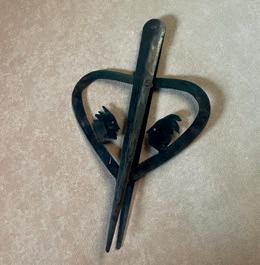
SARA RICCIARDI
1. Riccardo Dalisi’s compass design. It has an extraordinary emotional functionality. I went to visit him when I was a student, in his studio in Naples. I was enraptured by this object and he said “I’ll give it to you! It is only with the Other that we can draw perfect circles”. 2. There will be the Under the Willow Tree installation at Palazzo Litta, with Antica Fabbrica Passamanierie Massia Vittorio 1843 with which I will also be doing, at the Triennale, a project that pays tribute to Bugatti. At the Salone, new pieces for Bosa Ceramiche. In via Cappuccio 18, I will be presenting a collection of wallpapers for Texturae while in the Vito Nesta space in via Ferrante Aporti, there will be an exhibition on Alessandro Guerriero. Finally in via Fatebenefratelli 4, with Patrizia Fabri there will be a hat sculpture on Community Thought.

ELENA SALMISTRARO
1. For me the “Alessandro M” corkscrew by Alessandro Mendini for Alessi is an example of good design: it performs its function perfectly but is also an object that is fun, iconic and decorative. I decided to also buy the companion, “Anna G” so it’s never alone. 2. A limited edition bar for Cappellini. Also a new Most Illustrious for Bosa, along with three new tiles for the Dornette collection. There will also be a collection in marble for Lithea. Other designs include a table centrepiece for Orografie and an erosion-decorated metal plate for DeCastelli, with whom I am also taking part in Hoperaperta, presenting two artistic totems. In the city centre there will also be my sculpture made from the trunks of trees that fell during the floods last year.
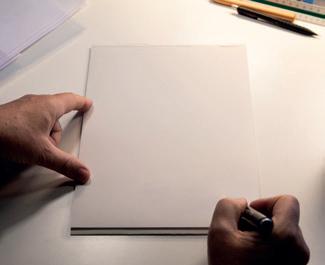
PHILIPPE STARCK
1. I have this mental sickness called creativity, which is the reason why I am constantly working on more than 200 different projects at the same time. I always work alone, with my pad of tracing paper and my Japanese criterion. This way I can create very quickly, faster than a computer because I am not limited by other people’s software or electronic programs, and I can give the best service to my community.
2 . I am convinced that to create timeless products, we need elegance in the working relationship. This year, I will present new creations with some of my long-time friends and companies that share the same vision and values such as Kartell, Glas Italia and Driade. This year also marks special celebrations of the 30th anniversaries of my collaborations with both Cassina and Duravit.

STUDIO KLASS
1 . The three-pronged fork by Caccia Dominioni, now issued by Alessi and presented for the first time at the Triennale in 1940. The most immediately striking characteristic is the fact it has three prongs instead of four. However it is only through everyday use that you can appreciate the elegance that is manifested in every detail from the richness of the reflections, created by a refined play of thicknesses, to the particular specific weight when you hold it in your hand. 2 . With Molteni&Co we will be presenting Arial, an extensive system of boiserie, doors and walls. For UniFor we have curated an installation at the showroom in viale Pasubio, dedicated to the new “Andromeda” collection of furniture. Finally, with Valli, at Viva porte in Corso Monforte, we will be presenting a new collection of handles.

STUDIO MIST-O
1 . The kettle designed by Sori Yanagi in 1953. It is an object in which form, function, craftsmanship and industry blend perfectly. What is more, it is an immortal product, extremely hard-wearing both in terms of construction quality and aesthetics. To achieve this quality many components are still made by hand, others industrially. We have used it for many years, several times a day and have moved house to different places around the world but we have never felt the need to change it for reasons of style or wear. 2 . An outdoor collection with Living Divani that will be at the fair and at the Living Divani Gallery, and a project with Fenix together with other designers, curated by Federica Sala, that will be on show in their showroom at Fuorisalone.

LEONARDO TALARICO
1. I often use chopsticks. I find them relaxing to use, they are sophisticated in their essence. Pure and perfect, they become graphic with movement and often thanks to them, I have glimpsed shapes to explore further: overlapping sticks and rotating one, I came up with the idea for a form that I developed giving it a function. That is how the Stems vase for Cappellini came about. 2. For Dieffebi I will be presenting a system of chairs for contract use; for Living Divani I have designed the first umbrella stand in the range. For Trussardi Casa I have reworked the features of the Maison to create an armchair and coffee table. In Brera there will be an out of scale skyscraper for Nero Sicilia made from waste material from working with lava stone. Finally I have curated the installation in the Cesana and Nero Sicilia showroom.
98 | April 2024 DESIGN/LIFE
Starcknetwork
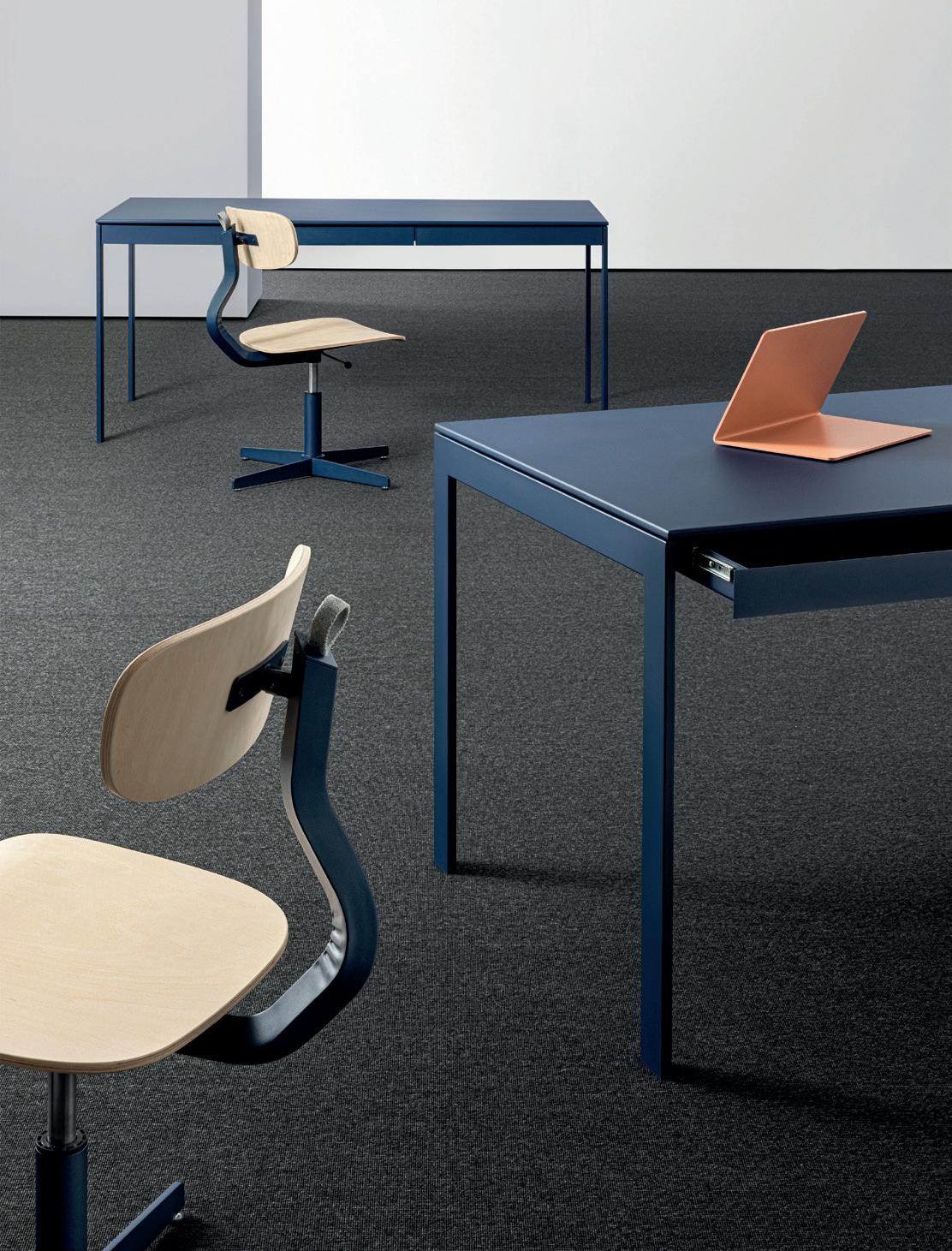

Flap design Meneghello Paolelli www.s-cab.it
THE ART OF LIVING

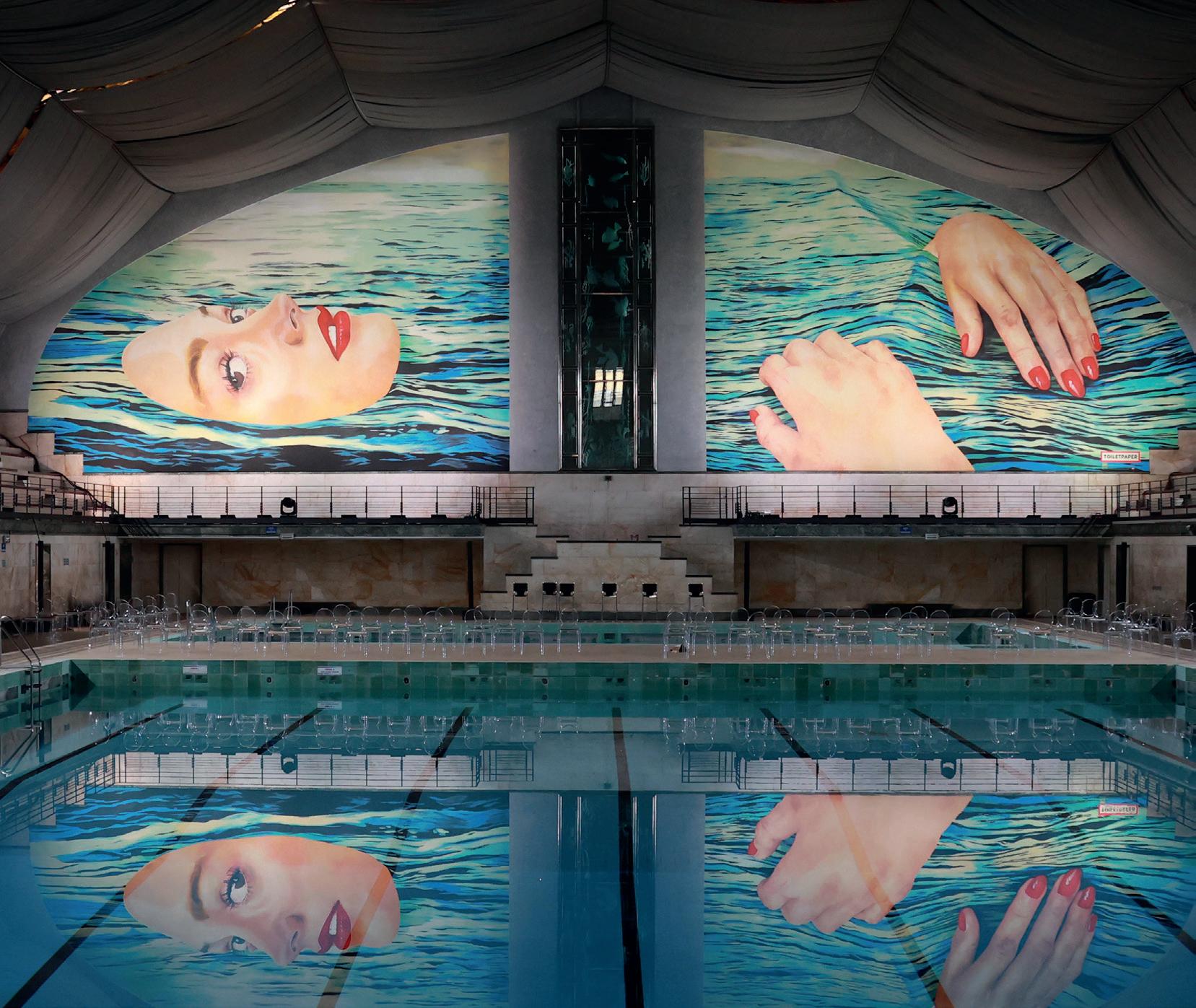
Going beyond
Design Week goes beyond the city, the geography of Design Week is redesigned: a Milan on the move
by Umberta Genta
Milano Design Week 2024 is expanding beyond the city limits: in Varedo, half an hour from the city by train, Alcova has chosen two historic residences, Villa Borsani and Villa Bagatti Valsecchi, as exhibition venues with a focus on collectible design, while a few minutes from Linate airport, another project dedicated to collectible design, Baranzate Ateliers, occupies a 1950s industrial building together with the French art and design fair Thema. At the same time, the city is undergoing a transformation: from the Brera design district, which now boasts 196 showrooms – 15 years ago there were 70 – to the growth of Via Manzoni, which has become a new design hub. Hidden or peripheral realities are appearing on the map: the Darsena is the choice of Mosca Partners for Design Variations, while in the Barona district Labò returns, an exhibition that animates the industrial spaces of the Società Prodotti Antibiotici and the Fondazione Rodolfo Ferrari. Masterly - the Dutch in Milan (the best of
Dutch design at Palazzo Giureconsulti) and Belgium is Design, (an exhibition presented by Baranzate Ateliers) are back: “One of the strengths of Italian design is its openness to the creativity of foreign designers,” explains Isabelle Valembras-Dahirel, art and design consultant; on the occasion of the exhibition of the winners of the Le French Design 100 award at the Istitut Français in Milan, Isabelle presents Le French Design Map, a printed vademecum of French design in Milan. Access to historic places usually closed to the public adds a special charm to this week: the Cozzi indoor swimming pool (pictured), a 1935 building in the heart of the Porta Venezia design district, is a must-see. In this district, Capsule Plaza stands out, a hybrid of fair and exhibition that, this year, extends from Spazio Maiocchi to the Corso Como 10 concept store. The city of design is changing, growing, expanding its boundaries. And it never ceases to be a showcase of ideas unlike any other in the world.
April 2024 | 101
Photo © Andrea Cerchi 24 HOURS IN MILAN

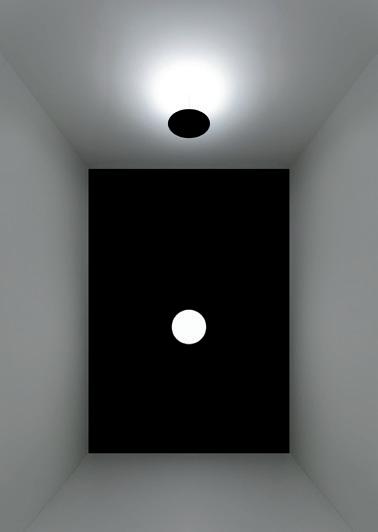


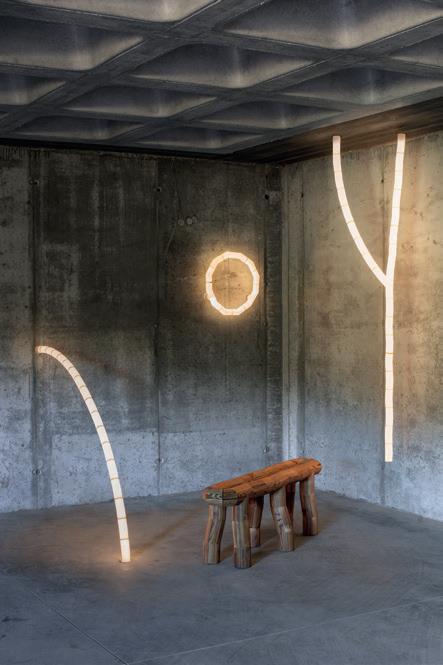
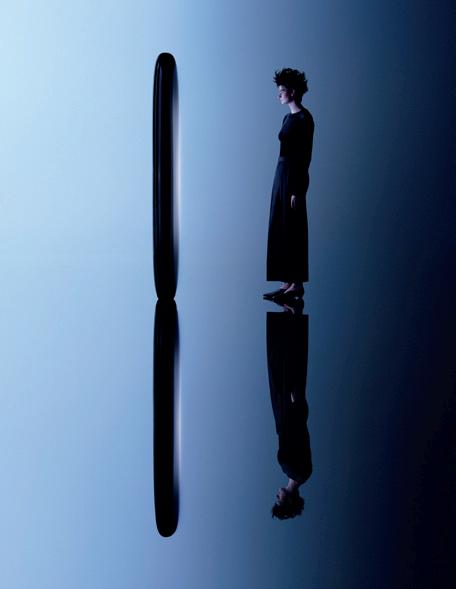
1 | POLTRONA FRAU via Manzoni 30
Among the brand’s new products, Squash stands out, the first collection in collaboration with British designer Faye Toogood (pictured), which plays on a mix of bold and soft shapes.
2 | PORSCHE via Clerici 5
At Palazzo Clerici, the automotive brand invites the public to enter and explore Lines of Flight, a floating work created by the collective Numen/For Use.
3 | DAVIDE GROPPI via Manzoni 38
“Light is storytelling”, explains the designer/entrepreneur, who presents his new lamps in the new Milan showroom, “stories of light” between functionality, fantasy and mystery.
4 | SANLORENZO via Festa del Perdono 7
In the 18th-century courtyard of the Università Statale, the SUB installation - designed by Piero Lissoni - gives the illusion of walking on the seabed, a pure and uncontaminated world.
5 | LEXUS via Tortona 27
The automotive brand presents the installation Beyond the horizon at Superstudio Più, a reflection on the relationship between technology and human life according to designer Hideki Yoshimoto.
6 | TOOY via Melzo 12
The brand illuminates the spaces of MelzoDodici in the heart of the Porta Venezia Design District: the collection of lighting elements is by the studio Cara \ Davide.
102 | April 2024 24 HOURS IN MILAN
6 5 1 2 3 4


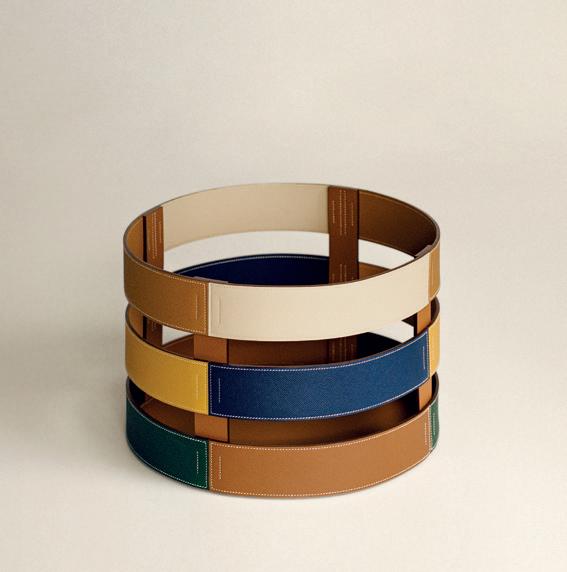
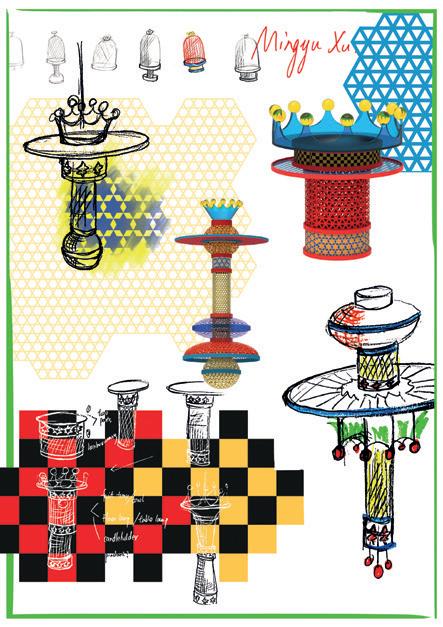




104 | April 2024 24 HOURS IN MILAN 1 2 3 Claire
7 4 6 5
Lavabre Studio Bouroullec

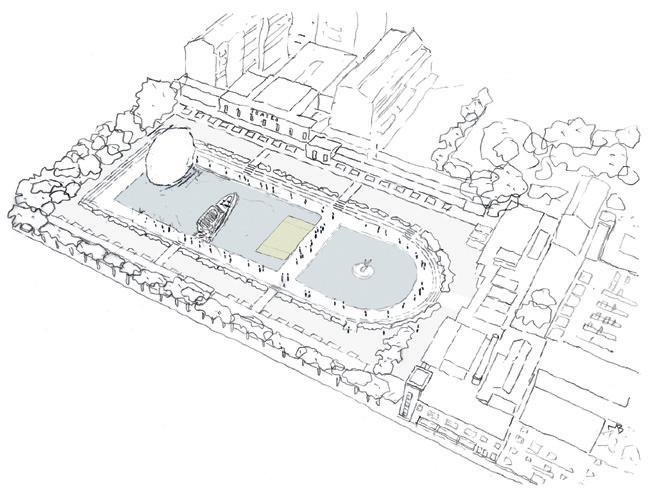
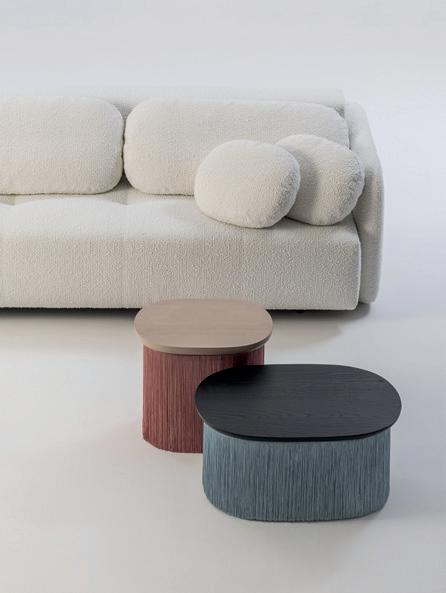


1 | MUTINA
via Cernaia 1/A
With Ronan Bouroullec solo show, the brand creates an immersive installation exploring the ceramic claddings collection by the renowned French designer.
2 | DOLCE & GABBANA
via Giuseppe Broggi 23
Design is a bridge between cultures: GEN D VOL.2, the Maison’s initiative for young talents, exhibits pieces born from collaborations between international design and Italian craftsmanship.
3 | HERMÈS
via Palermo 10
The maison presents its new collections along with objects from its heritage. Playing on temporal ambiguity, this combination demonstrates that Hermès objects are not influenced by time and trends.
4 | DRAGA&AUREL
piazza Cavour 3
The multidisciplinary duo created a series of images for Visionnaire’s Wunderkammer, exploring a fascinating path between furniture and collectibles.
5 | FENIX
via Quintino Sella 1
Polyhedricity and the concept of the double are the common thread running through Design Duo Double Feature, a project curated by Federica Sala (pictured, Martinelli Venezia coffee table).
6 | SIGNATURE KITCHEN SUITE
via Alessandro Manzoni 47
Precision is an art: origami, the protagonists of The Art of Precision installation, evoke the technological mastery of the brand’s built-in appliances.
7 | PRECIOSA
via Tortona 31
The brand returns to Tortona Rocks to light up the spaces of Opificio 31 with Crystal Beat II: the tradition of Bohemian crystal between technology, music and light.
8 | AZIMUT
via Carlo Botta 18
The shipyard lands at Bagni Misteriosi with Seadeck 6, a sustainable hybrid yacht, star of the Mooring by the Moon installation by Michele de Lucchi and AMDL Circle.
9 | ALESSI
via Alessandro Manzoni 41
The brand opens the doors of Palazzo Borromeo with the immersive installation Myth Makes Belief: among the works on display is a new project by Michael Anasstassiades (photo).
10 | LIU JO LIVING
via Pontaccio 19
With soft lighting and pleated curtains, the new showroom layout is all about comfort and relaxation. The undisputed star is the soft (and convertible) Verto sofa.
11 | LASVIT
corso Monforte 35
A leader in glass production, the Czech brand has conceived an oasis of escape in molten glass: Re/Creation is discovered in the courtyard of Palazzo Isimbardi.
12 | MCM BY ATELIER BIAGETTI
via Brera 13/15
The historic interiors of Palazzo Cusani in dialogue with seven furnishings (pictured, Chatty Sofa): transformable, modular, portable... or wearable. Curated by Maria Cristina Didero.
April 2024 | 105
11 12 8 9 10
The urban canvas
It’s impossible to see everything. This year, again, Design Week showcases an extensive program that unfolds against the stunning backdrop of Milan and extends beyond the city’s borders. A piece of advice: Take your time to savor the magic of design in every corner of the city
by Umberta Genta

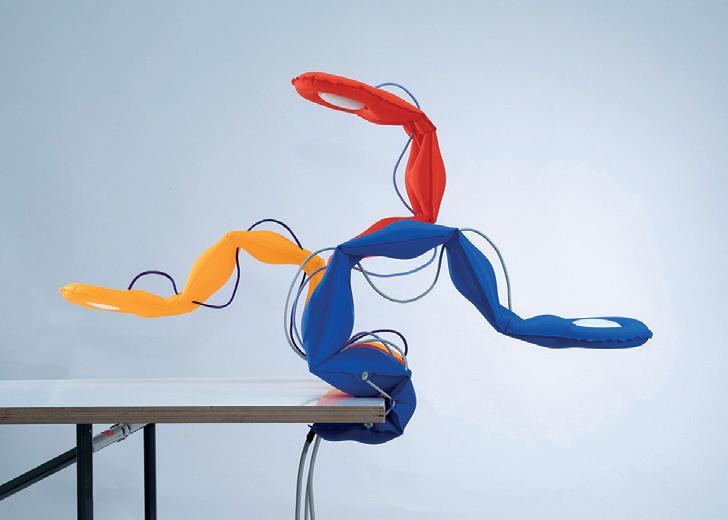
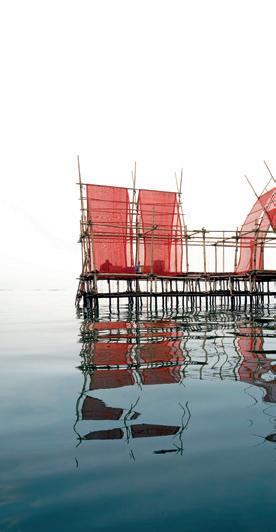
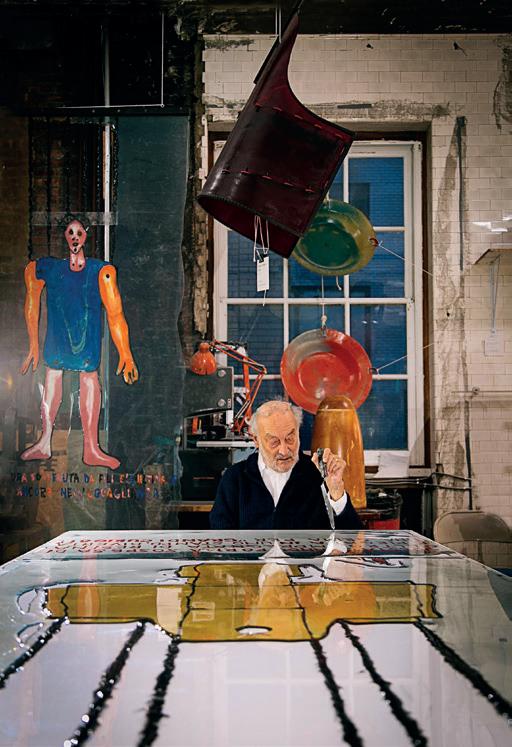
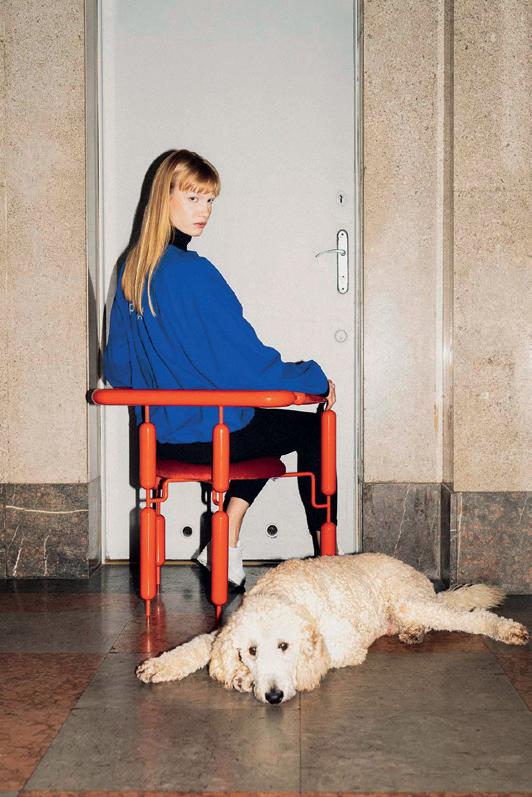
106 | April 2024 FUORI SALONE
1 2 3 4
Olga Antipina, Eva Ausmann, Ivan Lanz, Isola Design, Mila Łapko, Laila Pozzo, Foteini Setaki, W Workspace





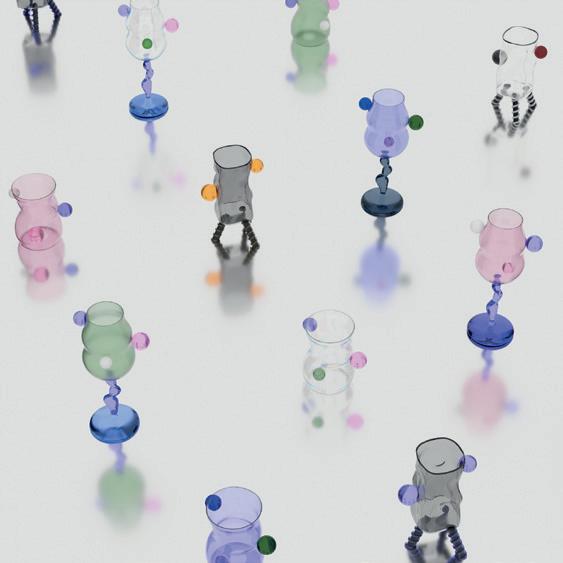
1 | NEW CRAFT (SHOP)
via Guglielmo Pepe 16
As part of the Isola Design Festival, the exhibition by Japanese craft brand Shinkogeisha shows how 3D printing can transform resin into new, funky products.
2 | EVA AUSMANN
via Valtellina 5
The Berlin-based designer’s creations and those of around 30 other creatives make up “Is one life enough?”, a focus on sustainable collectible design curated by Isola.
3 | MATI SIPIORA
via Valtellina 5
The Poodle armchair by the whimsical Polish designer is part of the Isola Design Gallery exhibition: the most colourful and irreverent collectable design triumphs.
4 | GAETANO PESCE
Pinacoteca Ambrosiana, piazza Pio XI 2
At the heart of 5 Vie, the multi-talented designer presents around thirty of his latest works in the exhibition Nice to See You, as well as an installation entitled The Tired Man.
5 | NOT COMPROMISED
Liceo Classico Parini, via San Marco 2/3
In this photo exhibition, six Thai architecture studios propose housing solutions that do not compromise the human presence, but rather protect nature.
6 | DOPPIA FIRMA
Villa Mozart, via Mozart 9
The stars of the show are the pieces born from the synergy between international design and high craftsmanship. (In the photo, the screen by Agostino Iacurci and Rosetta Gava).
7 | LAURA CASANAS MAYA
Alcova, Via Umberto I 148, Varedo (MB)
Via Vittorio Emanuele II 48, Varedo (MB)
The Colombian designer transforms rope into a structural element of furniture. The online store Alcova Shop, a showcase for emerging collectible design, features one example.
8 | DESIGN VARIATIONS
Viale Gorizia 14
The Mosca Partners project welcomes visitors to the Darsena with the site-specific work Corridor by Natalie du Pasquier. A new design destination is born.
9 | ALCOVA
Via Vittorio Emanuele II 48, Varedo (MB)
The sculptural 3D furnishings by the Rotterdam-based duo The new Raw stand out in Alcova’s selection, which also includes installations in the 18th-century Villa Bagatti Valsecchi.
10 | SLOW HAND DESIGN THAILAND
Superstudio Più,via Tortona 27
The exhibition at the Superdesign Show showcases Thai culture, design and craftsmanship, joining the group of Asian countries participating in the show.
April 2024 | 107
5 6 7 8 10 9
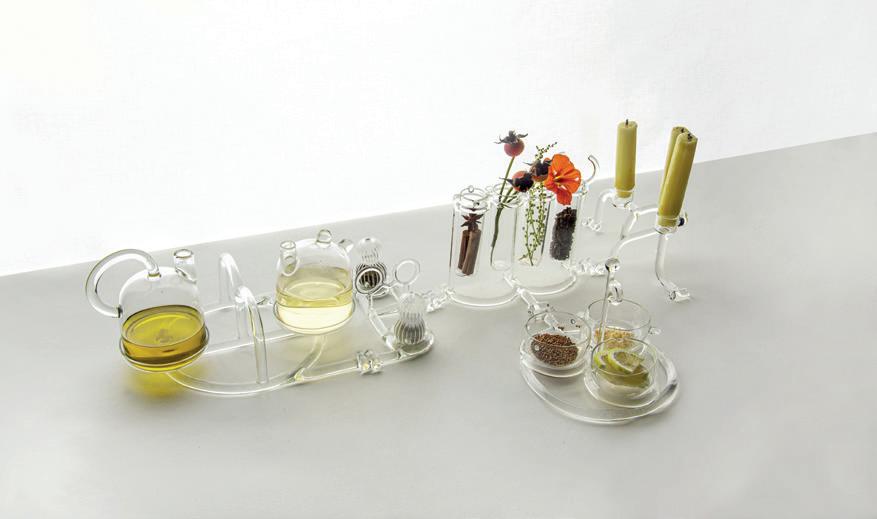

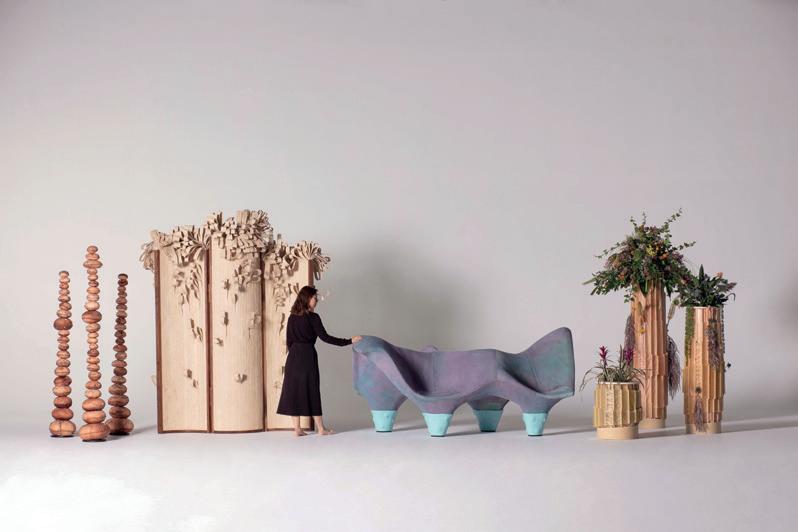



108 | April 2024 FUORI SALONE 5 1 3 4 6 2
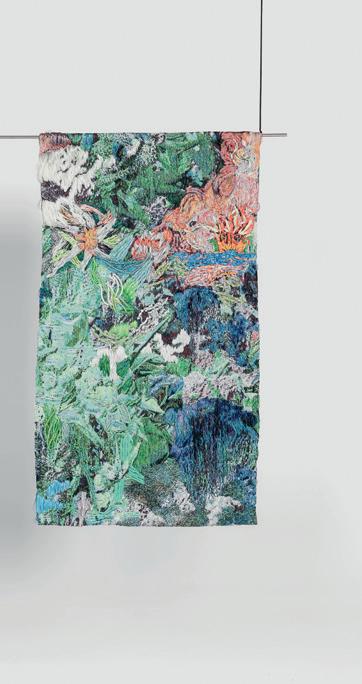

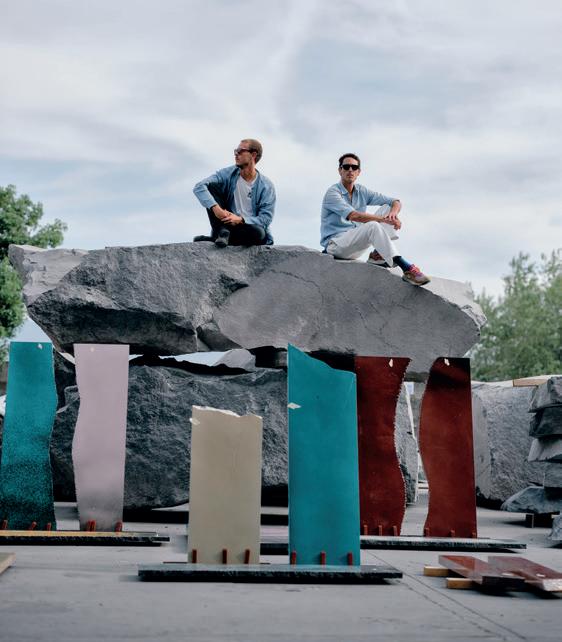

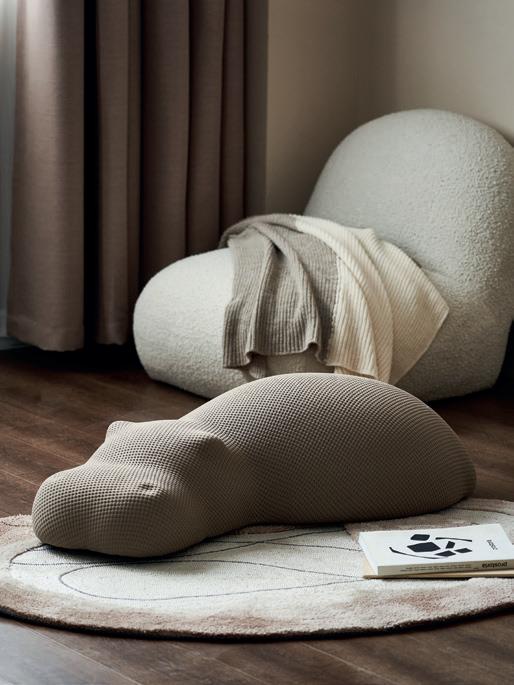
1 | STUDIONOTTE
Labò, via Biella 6
The design studio presents its collection of tableware, catapulting us into a softly lit room: a dinner party has just ended, but the table is still set...
2 | KRJS STUDIO
Via Gaudenzio Fantoli 16/3
The Belgian studio of Erika Schillebeeckx and Justine de Moriamé weaves contemporary tapestries with textures and vibrant colours. Textile installations at the Baranzate studios.
3 | DESIGN SPACE ALULA
via della Moscova 38
The exhibition showcases the work of Saudi and international designers and artisans from the Saudi city of Al-Ula. The exhibition is curated by Sabine Marcelis.
4 | KOSTAS LAMBRIDIS
Palazzo Litta, corso Magenta 24
The Athenian designer exhibits “Natural Selection”, an eclectic fountain created during the in-residence project in Turin, accompanied by an enigmatic text quoting Carlo Mollino.
5 | ARTESANOS
Via Lambrate
In the former Casoretto cinema, furnishings by Maddalena Casadei, Giulio Iacchetti and Zaven, made in collaboration with Artesanos, an initiative to support Latin American communities.
6 | ARTEMEST
Via Enrico Toti 2
The Residenza Vignale, a historic residence that blends Viennese taste with Milanese Art Nouveau, hosts the furnishings and works on the platform dedicated to collectable design.
7 | LA-BEL
via Gaudenzio Fantoli 16/3
In the industrial context of a 1950s building, Baranzate Ateliers curates an itinerary of collectible design and art (pictured here, the Calimero bench by La-Bel).
8 | RANIERI
Viale Lancetti 34
The Campania-based brand has created Dépot Meteora in Nilufar’s garden: a lava stone monolith that visitors can step into and discover a natural element at close quarters.
9 | GRADO
Superstudio Più, via Tortona 27
A contemporary interpretation of ‘less is more’, the Chinese brand - to be discovered at the Superdesign Show - focuses on essential, soft and light furniture (pictured here: the Hippo pouf).
10 | FROMM
Via Savona 35
The design brand, a “bridge” between the new talents of Doha and Milan, presents the new pieces of the Ottoman Dream collection, co-designed by Antonio Aricò.
April 2024 | 109
Alessandro Oliva, Alexander Popelier, Alessandro Treves, Tijs Vervecken 7 8 9 10

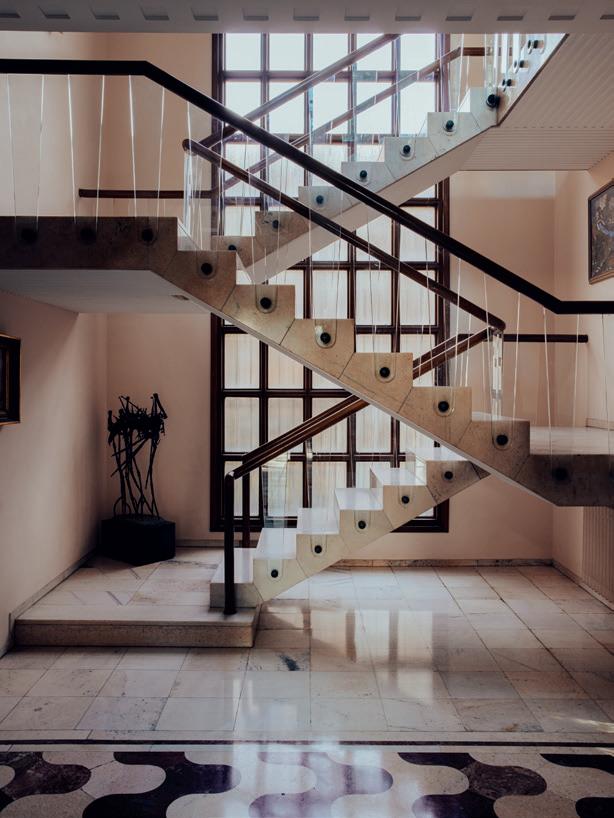

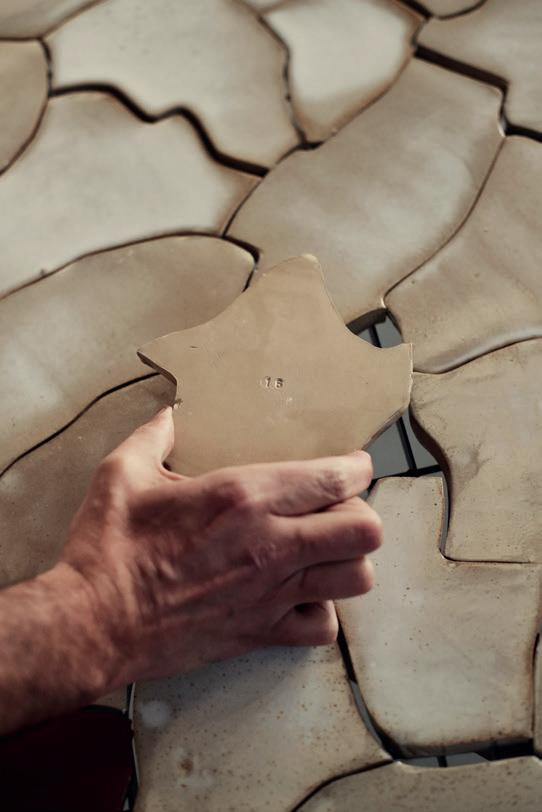


110 | April 2024 FUORI SALONE 5 1 2 3 4



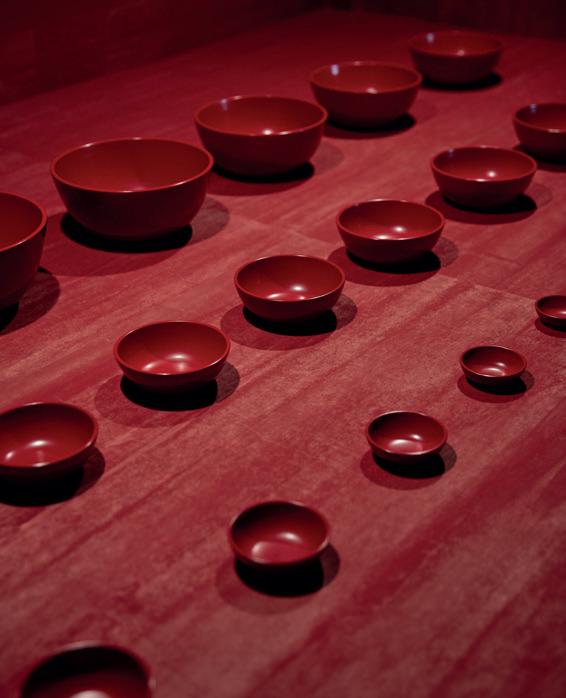
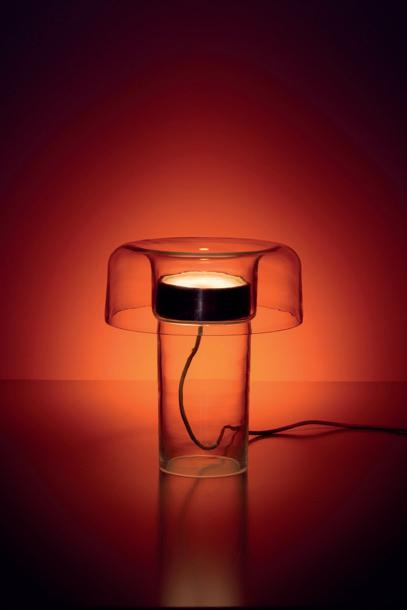
1 | SOLIDIFIED
Studio Farini, via Farini 35
At Isola, a selection of products in which the handicraft process is essential. Stories about the importance of method in design to achieve a precise result.
2 | AQUA ARIDA
Via Biella 6
The project by Jacopo Lupi and Fabrizio de Gaetano celebrates clay as a furnishing element and is part of the Labò exhibition at the Fondazione Rodolfo Ferrari.
3 | ALCOVA
Via Umberto I 148, Varedo (MB)
The travelling platform goes beyond the city limits: the exhibition animates the interiors of Villa Borsani, a jewel of modernism designed by Osvaldo Borsani in 1940-43.
4 | NILUFAR DEPOT
Viale Vincenzo Lancetti 34
The interweaving of industrial and natural materials forms the wefts of the carpets by Hechizoo, a Bogotá studio known for the elegance of its “textile architecture”.
5 | BEN STORMS
Via Gaudenzio Fantoli 16/3
For Baranzate Ateliers, the Belgian designer presents the In Hale Cast Glass coffee table, an experiment on the behaviour of molten glass cast in a mould.
6 | JAY SAE JUNG OH
Corso Magenta 24
At Palazzo Litta, the hub of 5 Vie, material layers are created from which furnishings emerge: the author, who creates them from discarded elements, is the Korean Jay Sae Jung Oh.
7 | MURALS WALLCOVERING
Superstudio Più, via Tortona 27
The wallpaper brand invites you to immerse yourself in an intimate cabinet of curiosities dedicated to the graphics of its collections: a triumph of patterns down to handmade motifs.
8 | IKEA
Via Tortona 58
What happens when you go out on your own for the first time? The Swedish brand tells the story in 1st, an exciting exhibition event that comes to life in the Padiglione Visconti.
9 | COSMOS DESIGN BLOCK
Superstudio Più, via Tortona 27
Ten pieces by ten Czech designers from different generations who have experimented with glass; the Spectra lamp by Lucie-Koldova emits a pleasant, soft light.
10 | GANGYONG PARK
Via Matteo Bandello 14
The Korean master craftsman is one of the authors of Thought on Thickness, a group exhibition organised by the Korea Craft & Design Foundation at Rossana Orlandi.
April 2024 | 111
Vaclav Jirasek, Alexander Popelier, Piergiorgio Sorgetti 6 7 8 9 10
ON SUSTAINABILITY
Twelve stories, very different from one another but with one element in common: they all set out to prepare a better world. Inventors, industrialists, scientific researchers: there are lots of ideas. Fortunately.
by Teo Sandigliano, Raffaella Serini, Giulia Guzzini

How can we define sustainability? In recent years this term has become a part of everyday life, in all its possible aspects, and in many cases it has been abused, in the process of so-called “greenwashing.” Often, however, we take it for granted that we are talking about simple practices connected with products (for example recycling, the selection of new materials, repair and reuse of components, etc.), but that is not the case: we are talking, in fact, about a true overall approach that attempts to respond to many critical aspects connected with extraction of raw materials, trans-

port, consumption and processing of resources, but also the spaces in which we live and the way we produce things. When we speak of sustainable design these terms become a true viewpoint for the design system and its methods – not only in this sector, but also with repercussions for the entire manufacturing industry: raw materials have to be obtained in a responsible way, considering not only their availability but also the energy consumed for their transport and shaping, the safeguarding of the natural environment and the conditions of the workers involved. A sustainable product is made of a few different materials, assembled with non-toxic solutions that are easy to dismantle, repair or reutilize part by part, thanks to a specific life cycle and precise instructions for the recycling of the various substances. From the standpoint of production, brands have to monitor their processes, encouraging solutions to diminish energy impact and waste. The growth of a business has to take the availability of resources into account, as well as the accessibility of the product, to boost its positive impact. These are just some of the factors connected to sustainability, and fortunately many brands are already working in this direction, offering innovative solutions. Because the future is being constructed today.
ORGANIC PLASTIC FROM THE SEA
Stronger than polyethylene but completely biodegradable, made from red algae and fish waste, a plastic has quite literally been invented by Lucy Hughes a British designer aged just 27 years who while still a student at the University of Sussex threw herself headlong into the search for a material to replace the plastic in use. “When I read that in 2050 there will be more plastic than fish in the oceans, solving this problem became my priority,” she said. The product created by Hughes – patented under the name of MarinaTex - is a strong, translucent and flexible bioplastic that can replace single-use plastic packaging and can be disposed of with food waste, thus creating a perfect circular system. From the skin of a single cod it is possible to create up to 1400 bags of MarinaTex. “Designers have a fundamental role in shaping the world of the future” says Hughes with conviction.
112 | April 2024
DOSSIER
1 2
MATERIALS EXPERIENCE
Led by Professors Elvin Karana from the Delft University of Technology and Valentina Rognoli at Politecnico di Milano, the Materials Experience Lab harnesses creative talent to redefine interactions between people, materials, and artifacts. Venturing into untapped territories of material and product design, this lab sheds light on their discoveries through exhibitions, academic publications, public discussion forums, and beyond. All these endeavours are fuelled by the aim to fortify and promote the wider scientific community. In a nutshell, ‘materials experience’ encapsulates our all-embracing approach to how materials are integrated into design. This perspective underscores the dual characteristics of materials as both technical units and experiential entities.

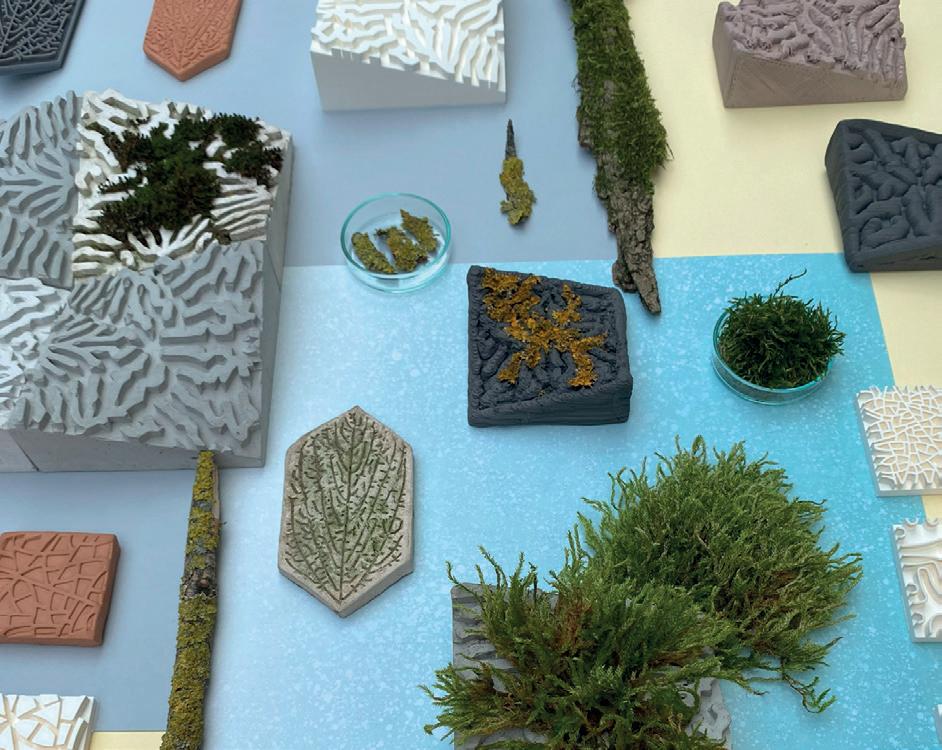
REUSING PRODUCTION WASTE
Brokisglass demonstrate how production waste can become a new resource: the company was in fact created to reuse leftover material from the production of glass products by the brand Brokis and Janštejn Glassworks. The technique of hand blowing in fact creates up to 30% of waste material for each piece and the Janštejn Glass Group (that the brands mentioned are part of) have therefore decided to invest their own resources into creating a unique new material, based on the use of glass fragments. The Brokisglass panels that have emerged from this solution offer a new aesthetic with a material with unique properties, perfect for architecture, building, interior design and furniture. The brand reuses 100% of the waste (around 10 tonnes a week) and thanks to its composition, offers a product that is unique in terms of texture and colours.
SUSTAINABLE GROWTH FOR BUSINESS
The company Honetex produce carbon-negative recyclable panels – in other words they eliminate more CO2 than they produce during their life cycle. Made from 100% waste fibres from the paper industry, the product has recently been awarded a Cradle to Cradle Gold certificate that analyses the healthiness of materials, circularity of the product, protection of air quality and climate, responsible management of land and water and social equity. To encourage sustainable growth, Honetex wants to operate reducing transport and encouraging self-sufficiency in areas where there is a problem industrial fibre waste. At the moment the brand is focussing on scalability of production in Europe that thanks to shared rules and regulations, can ensure greater control in terms of standards and the implementation of truly sustainable practices.
OPTIMISATION OF PRODUCTION AND PACKAGING
OTO Chair, designed by Alessandro Stabile and the studio Martinelli Venezia, is the first product from One to One and demonstrates a fresh approach to the design of this product type. The brand, in collaboration with the designers, has come up with a solution to reduce the dimensions of the conventional mould – all the components are moulded with a single matrix – speeding up the production process and reducing material waste to a minimum. The chair is made from a single material, created with post-industrial recycled plastic and shipped in recycled and recyclable cellulose pulp packaging. OTO Chair is sold dis-

Alga Studio
5 3 4
1-2. MarinaTex ingredients ©2020 Lucy Hughes. 3. OTO Chair by Alessandro Stabile and the studio Martinelli Venezia for One to One. 4. Bioreceptive design for biomonitoring and urban resilience by Barbara Pollini. 5. Carbon-negative recyclable panels produced by Honext.

assembled and is easy for the customer to put together: this process introduces the concept of the hyper-serial, in which some of the standard operations are omitted - like assembly - leaving the final buyer to complete the process.
PRODUCTION ON DEMAND
The brand Porro, thanks to investments to support legislation on the evolution towards industry 4.0 and the technological innovation of manufacturing processes, have developed a new state-of-the-art system that has made it possible to substitute the creation of panels in standard sizes with a form of production known as “just in time”, based on orders, without forgetting customisation, quality and sustainability. For this reason, some phases of the production are still done manually such as selection, combination and treatment of the veneers to achieve the best continuous surfaces. Thanks to an approach geared towards continuous improvement and manufacturing efficiency, Porro have rationalised lead times, use of materials and energy throughout the entire manufacturing phases.
CONTROLLED SUPPLY CHAIN FOR LOW ENVIRONMENTAL IMPACT
Not just products but also suppliers, land and social responsibility: Slide takes Made in Italy seriously to ensure supply of quality and sustainability, both in terms of raw materials and for professional services that allow the company to work correctly and at the speed required by the market today. The company is conscientious about the territory where it operates: specifically, 80% of the suppliers are located in Italy, and of these 75% in Lombardy. In terms of distribution value, 88% is destined to the Italian supply chain while 66% to Lombardy. As well as a controlled supply chain, Slide therefore guarantees transport of materials with low environmental impact and the value it redistributes remains for the most part in the surrounding area, which is also where most of the employees come from.
SUSTAINABLE INDUSTRIAL DESIGN PRODUCTS
Can mass production become sustainable? A definitive answer does not yet exist but through new products and small changes we can imagine a more responsible design sector. Such is the case with Arper: Mixu, designed by Gensler in 2012, is a versatile chair that via a system of three distinct parts (seat, backrest and base) can provide endless solutions. Specifically, the chair is made from recycled post-industrial plastic, FSC certified wood, finishes in fabric or leather. Adell, designed by Lievore + Altherr Désile Park (2020), has a shell in 80% recycled polypropylene while Kata (Altherr Désile Park, 2021) uses a polyester fibre made from post-consumer recycled plastic bottles (to produce a kilo of yarn around a kilo of waste is used - the equivalent of 48 half-litre bottles). The three solutions are produced without the use of glues and are easy to disassemble for disposing of responsibly.
POPCORN PACKAGING
Would you ever have thought, while munching on popcorn in the cinema, that one day those balls of corn would be transformed into a packaging material? The idea, only seemingly bizarre, occurred to professor Alireza Kharazipour, head of the research group in Chemistry and Engineering of composite materials at the Faculty of For-

estry Sciences at the University of Göttingen, in Germany. Thanks to many years of experience in the field of renewable energy and raw materials, Kharazipour has succeeded in developing a material made from popcorn grains that can completely replace polystyrene materials, even those made from expanded foam. The granules can offer a 100% organic and ecological alternative to polystyrene based products currently used in industry, in packaging, acoustic insulation panels, door panels and booster cushions.
CARBON ZERO MANUFACTURING
IQ LUX is a brand of lighting products that is part of the XAL group who since 2023 have been working towards achieving manufacturing with zero CO2 emissions through various solutions: recycled materials, additive production technology and renewable energy for creating products that emphasise circularity. Specifically, IQ LUX have developed proprietary 3D printed filaments made from recycled plastics (PET) or biological sources (PLA) that use mixes of salvaged materials such as wood, cement, graphite, ceramic, algae and earth - useful also for creating colours, patterns and unique characteristics for each product. The company creates their own designs using 3D printing and all activities are powered exclusively by solar energy, achieving neutral carbon emissions.
3D PRINTING FOR RECYCLING AND REDUCING WASTE
“A series of products created by our designers and made from post-consumer recycled material, for beautiful, durable, sustainable objects made with innovative technologies and craftsmanship”: this is the promise of r3direct, a Tuscan company based in Lucca and a pioneer in the field of large-format 3D printing that is made based on refuse and waste materials. Their designs have been made for public services, like anti-terrorism barriers and benches, but also for private individuals and professionals, in art, architecture and design. Two years ago for example, r3direct worked with architect Mario Cucinella to build the installation Design with Nature at the Milan Furniture Fair. And that’s not all: “In the future you will be able to print anywhere, without the need for transport or warehousing” says the group’s designer Stefano Giovacchini, “thereby also reducing pollution”.
SUSTAINABLE WORKPLACE
The headquarters of the company Gessi is located within the park of the same name, in Valsesia. In an area extending over 800,000 m2, four hectares have been given over to photovoltaic installations, one of the most innovative and advanced systems of “energy-generating roofs” in Italy, producing 18% of the total required. This system, together with other energy sources (solar, hydroelectric and thermal) ensures that 100% of the electricity used by the company is produced by renewable sources. Over four years, from 2018 to 2021, around 10000 tonnes of CO2 have been saved. Parco Gessi has been created to be inclusive not only for the employees, who can move between different departments thanks to a cycle route, but also for the benefit of the natural surroundings and houses twenty hives that are home to over 600,000 bees.
6. Adell by Lievore + Altherr Désile Park for Arper (2020).
7. Scraps and tests by Monoferments from the diffused exhibition ‘Peripheral Design’, curated by Teo Sandigliano with set up by Milo Mussini, produced on the occasion of Milan Design Week 2024 with the theme ‘Shaped by Design’ which will see the activation, in collaboration with the Milan City Council, of four peripheral spaces in the northern part of the city.
114 | April 2024
6 7 DOSSIER

Tangible strength
The Europe branch of Material Bank, the world’s largest online materials library, turns one
by Laura Barsottini
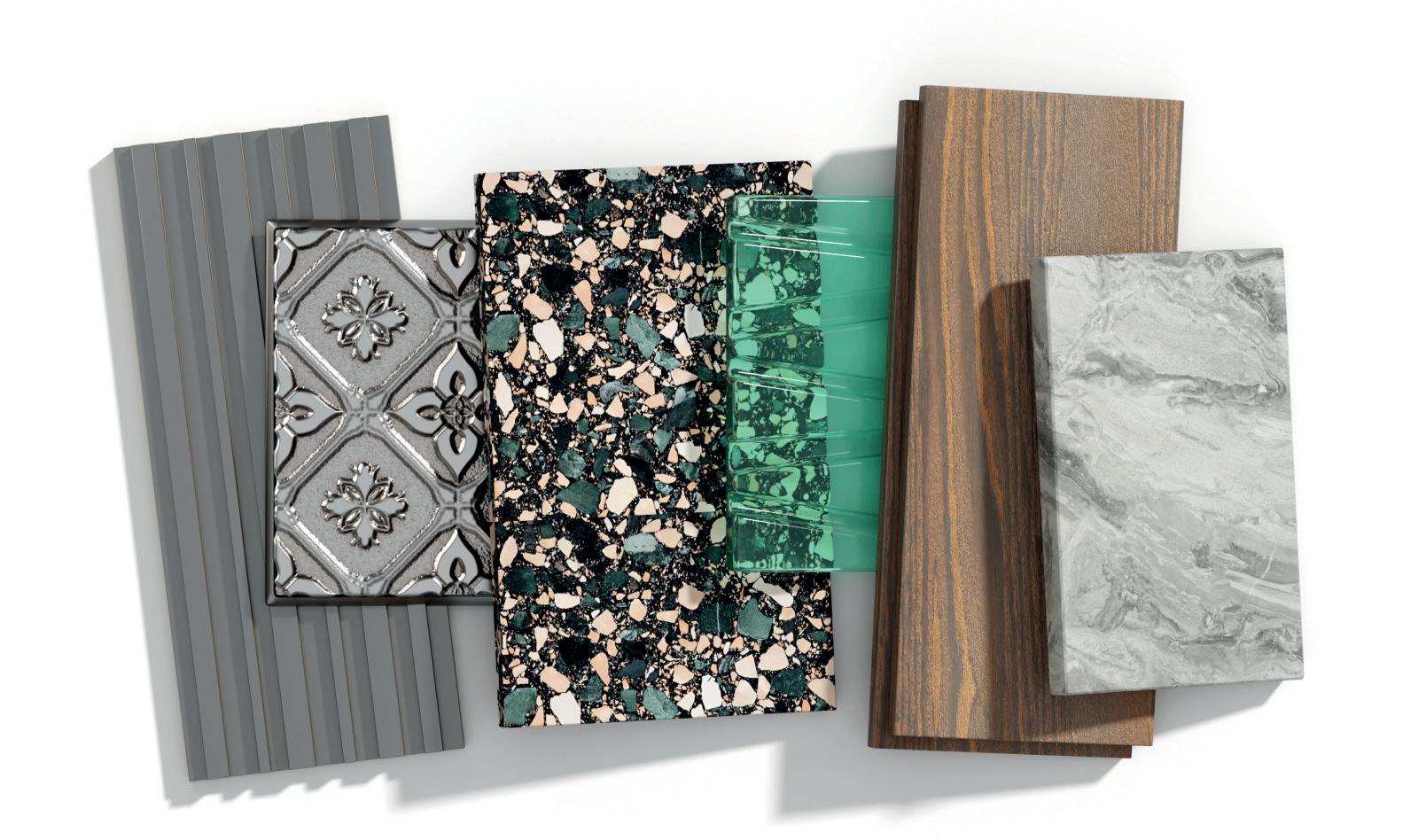
Sometimes the simplest idea is the most successful. The important thing is that it has value. Like Material Bank, a large database of materials and products from carefully selected companies that architects and designers can access for their work.
The adventure began in 2019, when Adam Sandow, editor of publications such as Interior Design and Metropolis, had the intuition to create a revolutionary startup for the world of designers.
In practice, Material Bank is a large portfolio where professionals can choose from thousands of references and receive their selection in a single shipment, without having to contact individual manufacturers one by one, by the morning after the order (if placed by midnight).
This is a great success when you consider the amount of energy, resources and time that every design studio has to invest in sampling. Material Bank’s absolutely winning intuition was to respond to a real need, so much so that today its catalogue includes the products of more than 500 companies and the users of its services - architects and interior designers - exceed 100,000.
Headquartered in Boca Raton, Florida, the company has a 35,000 square foot distribution centre in Olive Branch, Mississippi, five miles from the FedEx Express World Hub at Memphis International Airport. This strategic location, along with the use of robotics to work alongside humans, allows the company to ship all packages via Priority Over-
night, ensuring that orders placed by midnight Eastern Time are delivered by 10:30am the next day.
The shipping process also helps to reduce the number of parcels sent out, which contributes to the company’s sustainability: the various materials ordered by designers are packed in a single parcel, with a reusable and recyclable box, without any excess packaging, reducing waste: the company has calculated that it has already saved over 4.6 million parcels over time - the figure is updated in real time on the website.
Such an idea could not remain on the other side of the ocean, and in April last year, Material Bank Europe was born: its headquarters are near Roissy Charles de Gaulle airport in Paris, and its general manager is Philippe Brocart, former director of the Maison&Objet trade fair and its digital platform.
“I remember,” he says, “that I started talking to Adam about this idea in 2016/2017. We had known each other for a long time through our activities in the design world: he was the editor of design magazines and I was in charge of Maison&Objet’s digital platform. Adam is the kind of person who talks to everyone, curious to understand the reality around him, to find problems and try to solve them. So we were always talking to each other about our world, discussing opportunities and problems. One of the difficulties we encountered most often was the effort made by architects and interior designers to keep abreast of brand
1
production and, above all, to obtain samples of the products in circulation. Some said that up to 25% of their time was spent on this activity. On the other hand, it was equally difficult for companies to keep abreast of the quality projects in the pipeline and to manage the logistics of preparing, packaging and shipping samples within an acceptable timeframe once designers had contacted them. Material Bank brought these two needs together and solved them.
What is the biggest innovation that Material Bank has brought to the market?
“The secret of success is to create supply where there is demand. Material Bank’s proposal to architects is simple, but of great value: do you need samples of materials and products to take you from the conception of your project to reality? Log on to the Material Bank platform, do your research - the materials are all catalogued by type, by brand and with a rich and detailed description, order your samples by midnight and you will have them conveniently in your studio the next morning, because shipping takes place at night. The same thing happens in London, but also in Greece or Germany. At the same time, the brands are kept up to date on the projects in the pipeline and the samples are sent free of charge. We have realised that we have the opportunity to identify valuable projects, which we select carefully. Innovation, the real innovation of substance, is the simplification of a problem”.
116 | April 2024 TOOLS

What are the reasons for Material Bank’s success?
“I realised, perhaps for the first time in my life, that there is no reason why architects and companies should not use Material Bank: the service is great, for designers it is free, while companies sign up for a small fee. As far as manufacturers are concerned, we have a real opportunity to grow their business: if you are a medium-sized company, with a medium-sized market, with Material Bank you have the opportunity to supply your products to every corner of Europe and the world. In addition, companies receive a lot of data on current projects for which they receive sampling requests, a valuable indication for the direction of their work and future strategies. There are currently 29 countries covered by our service”.
Let’s talk about numbers: how many designers and architects use Material Bank?
“There are currently around 10,000 professionals registered on the European platform, but you have to consider that there are usually several designers in a studio. For example, if there are five of us in a room, the application will be unique, but five of us will use it. We are very selective about the projects we recommend to companies. We often reject
them because they do not meet our standards, which are very high. We assess not only the professional status of the designer, but also the type of projects they work on. We also want to make sure that the request for samples relates to an actually identified and ongoing project. We reject around 30% of requests from B2C consumers. Companies that use us are entitled to the utmost seriousness. But even those who are ‘rejected’ have access to our database, if only for inspiration: they can consult the list of brands, access product information, use the Mood board programme... they simply cannot place a direct order and receive the samples free of charge.
How many brands do you currently have in your catalogue?
“In terms of brands, we currently have around 500 in our portfolio, most of them Italian - we love Italian design. Again, the selection process is rigorous: we carry out careful analysis so that we can accurately describe all the products on the platform. On the other hand, we pay special attention to students, whom we see as the talents of tomorrow, and give them the opportunity to discover the platform: they can have an account and do research, but without ordering samples”.

What are Material Bank Europe’s objectives?
“We want to reach 50,000 registered designers between Europe, the UK and Switzerland. Definitely an ambitious goal, but... if we have come this far, it is certainly realistic!”
1 A sampling of different materials, all selected on materialbank.eu 2. The 100% carbon neutral box in which the order with the requested samples is delivered: each shipment is carefully packaged. 3. The distribution centre in Olive Branch, Mississippi. 4. The site allows users to save their searches and organise them into independent folders that can be accessed and edited at a later date.

April 2024 | 117 4 3
2
Nature calling
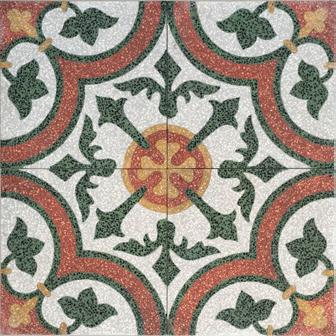
A. Tessieri & C.
900 - ED. 2020
Tiles in decorated cementina
The Tessieri range of floors ‘2020 edition’ includes designs that demanding clients and interior decorators asked the Fabbrica Tessieri to produce back in 1927. The tile made from cement, commonly known as ‘cementina’ consists of a decorative layer made from marble dust and coloured cement. The range of colours used in the patterns are created in the factory according to antique recipes.
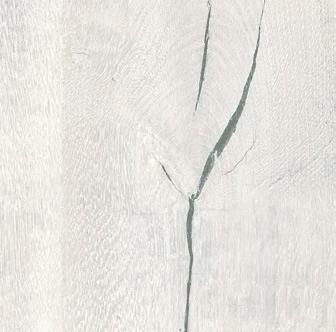
Porcelain stoneware tiles

Strips of porcelain display an iconic representation of wood marked by time, salvaged and then expertly restored. The surfaces with their skillfully varied pattern are enhanced by the grain and imperfections of wood that are combined with grooves and cracks reproduced with surprising realism using carefully studied material effects.

Amazzonite® - Lux® Stone cladding (quarzite)

A quartize characterised by its turquoise colour on an emerald-green background, with nuances of dove grey and black. Amazzonite® is a unique stone that presents a particular shine and brilliance, able to evoke the sea and the wild forest. Thanks to its properties it brings character to architecture and sophisticated effects.
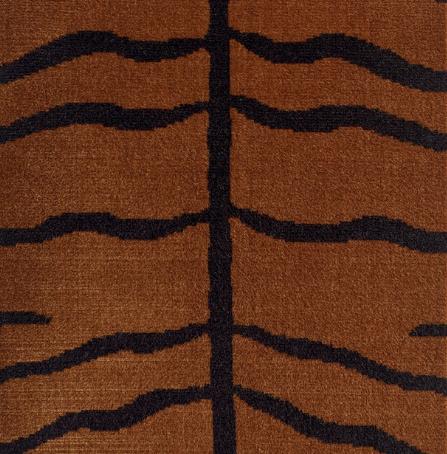
A Tiger In The Orangerie
A jacquard velvet, 100% cotton, vibrantly coloured, interprets the tiger’s coat in an idealised version. The stripes are softer and more abstract, sinuous and rhythmic. Combined with the unmistakable orange colour of the animal, they become the protagonists of this fabric with a soft and dense touch, suitable for upholstery.
Stylised, as in tiles with a 19th century design. Abstracted, in marble inlay. Recreated, reinvented. Stones, plants and animals become inspiration for interior design. Scan the QR codes: you will find the reference directly on materialbank.eu


The collection presents a selection of six natural marbles with a strong, refined character. The surfaces of Marvel PRO, with intense veining, natural graduations and a refined appearance is characterised by a very sophisticated pattern that interprets the finest marbles with extraordinary realism, for a complete range of porcelain stoneware floors and matching finishes.
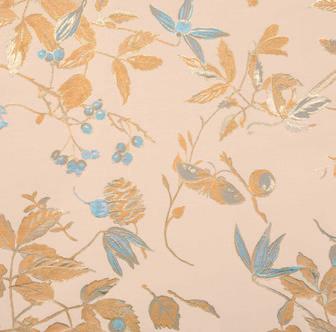
Fischbacher

A jacquard fabric for curtains that takes inspiration from the richness of nature. Luxuriant flowers and leaves dance across the fabric with a shimmering effect thanks to an outline in subtle lurex thread that creates a metallic contrast with the matt linen background. Dorato is available in three colourways: one a delicate white and pink, another in gold and blue and a third in black and copper.

– “Algas” Wall Inlay Marble cladding
Modular cladding with artistic inlay created by Patricia Urquiola that depicts at a larger scale the algae from the Algas vase she designed. Curvaceous and elegant inlays in Cipollino Green, Lapis Lazuli, Sivec White, Lapponia Green, Acquamarina Green, Azul Macaubas and White Onyx, on a background of Calacatta Caldìa.

Loro Piana Interiors
Black Swan Ebano Wallpaper
Black Swan is made from a balanced composition of cotton and artificial fibre, that makes it functional and practical. Jacquard looms are used to create the delicate decorative pattern that represents the tree of life in an exclusive and sophisticated fabric, after which paper is applied to the back for application to the wall.
118 | April 2024
Antolini
Atlas Concorde Marvel Pro Porcelain stoneware tiles
Budri Agua
Ceramica Sant’Agostino Timewood
1819 Dorato Fabric
Dedar
Fabric
TOOLS


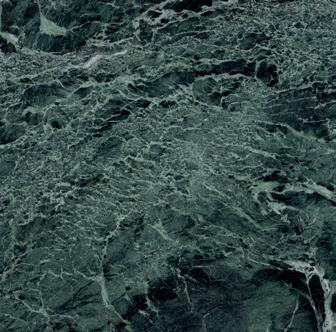

Rice Decoro Leaf
Porcelain stoneware tiles

This range of porcelain stoneware features a glossy finish and deliberately irregular surfaces that conjure up the feel of handmade majolica. In a neutral colour palette - white, natural and grey - with accents of blue and three nature-inspired patterns that give life to multiple compositions with a unique character. Between one module and another are very slight changes of tone, shading, effects of chiaroscuro and imperceptible concave-convex movements.

Les coquecigrues Wallpapers
Christian Astuguevieille has reworked a decorative motif printed using a woodcut technique at the Manufacture Oberkampf in around 1792. It is called Coquecigrues because of the fantastical animals depicted on the fabric and became a fashionable motif in the 18th century. Inspired by surrealism, the artist has altered the scale of the design and colours to produce a more modern version suited to contemporary interiors.
A light green marble with unusual nuances making it ideal for elegant settings. The surface of green Onyx is enhanced with veining in a deeper and more intense green. Available in marble slabs and blocks for bespoke creations, suitable for interior use only.
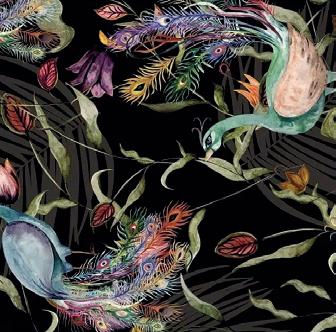
Porcelanosa
Capricce B Aluminium panels

Alluslate® panels, easy to install, large in format, are made from strong and malleable aluminium sheets with a top later decorated with advanced printing techniques. They are genuine murals, with tropical patterns, bright colours and two kinds of finish: matt and glazed, conceived for large residential spaces, hotels and retail.
A marble that conjures up in the imagination a mountain view, filled with fir trees coloured dark green. In the background, the black of the night after the sun goes down, in an atmosphere of peace that is conveyed in the interior spaces where Verde Alpi is installed.

DecorIdea Riga 1.5 Clear Glass

OmniDecor engraved glass is produced using a chemical process that creates different levels, making the three-dimensional appearance of the surface even more evident. In this way, when light hits the engraved surface, the glass comes to life. Available in grey, bronze and mirror, with acid-etched or transparent finish.
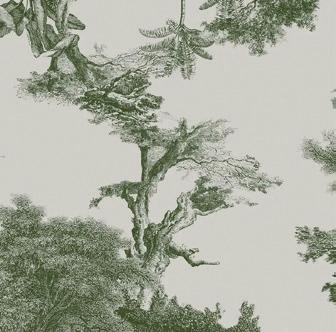
Wall&decò
Herning
Vinyl wallpaper
Using tiles in Murano glass and other materials, mosaic artists in the Sicis workshop create mosaics and eclectic creations by hand. A true kaleidoscope of brilliant, iridescent, translucent, metallic tiles that convey the lushness of nature.

Herning is a non-woven fabric wallpaper with a vinyl top layer, designed by Ludovica+Roberto Palomba. The surface layer is embossed, washable and can be removed dry. Made with an ecological process, it is recyclable, free from PVC and phthalates with a certified emissions threshold. The illustrations are inspired by herbariums and antique nature prints.
April 2024 | 119
Margraf Onice verde Marble cladding
Marmo Arredo Marmo verde Alpi Marble cladding
OmniDecor
Pierre Frey
Sicis Wonderful Mosaics
Marazzi

SPACES
122 SCULPTURAL APARTMENT
Warsaw, Poland
Katarzyna Baumiller
123 THEROSEGOLDAPARTMENT
Barcelona | Raúl Sánchez
CASA RUDE
Rome | Studiotamat
124 TRIBECA LOFT
New York | Timothy Godbold
KARLOVYVARYAPARTMENT
Karlovy Vary, Czech Republic Plus One Architects
125 ZÜRICH HOUSE
Erlenbach, Zürich | Ernst Gisel
CAFÉ HOUSE
Divinópolis, Minas Gerais, Brazil Tetro Architecture
126 THE SILVER LINING HOUSE
Bernal Heights, San Francisco Mork-Ulnes Architects
TALBOT RESIDENCE
Highgate, London | Black & Milk
ORCHESTRATION FOR INTERIORS
With a space given over to dwelling, found in different geographic and architectural contexts, from detached or semi-detached houses to lofts and urban apartments that vary in size and number of floors, the mission is to devise a complex story, both in terms of design and narrative, of materials, objects and people. Establishing a new vision, whether it be a eulogy to perfection or homage to the imperfect, giving a mere space a sense of place, that can be repaired and updated by salvaging elements from the past or coming up with new ones (or both). In each case it is always about creating layers with details and materials. Metals, fabrics, woods, stones, marbles, concrete, brick, decorations, mosaics, stuccos, mirrored surfaces, used for vertical and horizontal claddings, screens and space dividers, enclosed or hidden volumes, bespoke furniture and sculptural pieces, painted walls and doors, ceilings like fifth walls, works of art and objects. And of course colour, lots of colour. An organised and layered composition on multiple levels that perceived in synchrony is something akin to a musical score.
by Alessandra Bergamini
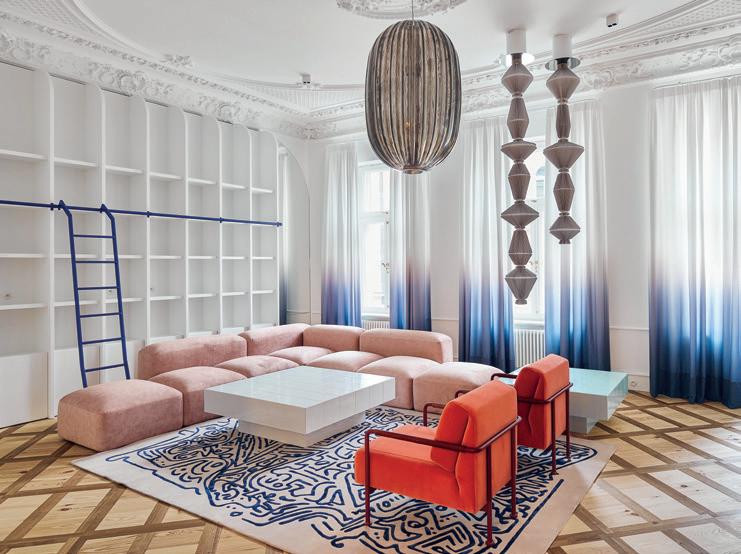


Sculptural Apartment
After moving from New York, the owners were looking for a house for the whole family and chose this apartment of 200 square metres situated in a building from the early 1900s, previously abandoned and then restored. In the classic enfilade plan layout, the restoration work repaired the rich stucco decorations on the ceilings, the parquet floors, the windows, while the interior design integrated many elements contrasting with tradition. “The owners took on unusual ideas with boldness and even encouraged me to look for new forms”. Such as the numerous made-to-measure mirrors that appear in all the rooms, conjuring up antique decorative mirrors but with irregular forms that reflect reality in unexpected ways. Another surprising form is the unusual sculptural piece covered in cobalt blue velvet that occupies a whole wall of the living room, a gym and refuge for the household cats. Then in the kitchen, the three-metre-high storage unit in candy pink, a colour also chosen for the island and for the system of ducts for the air conditioning that becomes a sculpture and
hangs over the dining area. Surfaces for applying colour are everywhere, the full height curtains, with their faded effect achieved using a scenic art technique. “I have deliberately juxtaposed rich plaster mouldings, classical parquet and traditional wooden doors with reflective tiles and coloured lacquered steel and glass in order to complicate the bourgeois character of the building. The interior is enriched by refined materials but I have treated them with detachment and humour”.
Location: Warsaw, Poland
Architecture: Katarzyna Baumiller
Furnishings: custom made on design by Katarzyna Baumiller; Amura, Baxter, Knoll, Milano Bedding, Noti, Usm
Lighting: &Tradition, Foscarini, Hasik Design, Marset, Parachilna, Tom Dixon, Toss B, Ultralight, Verner Panton, Vivid Color Studio Mirrors and curtains: Synesthesia, designed by Katarzyna Baumiller
Photos: Alicja T., Murak, Photofoyer
122 | April 2024 SPACES
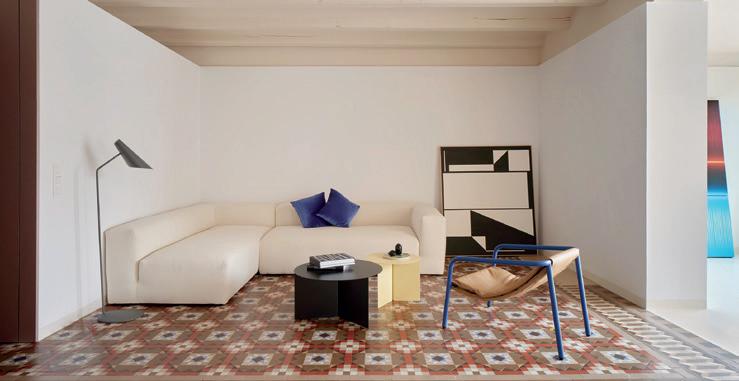


The Rosegold Apartment
In the Derecho del Ensanche neighbourhood in the Eixample district of Barcelona, this 85 square-metre apartment has a long and narrow plan, just six metres wide, created from the division of a larger apartment facing onto a large internal courtyard. The layout has been changed completely, placing two bedrooms with bathroom in the most inner and closed part, the refurbishment has however preserved the rich existing flooring made with Nolla mosaic. An exquisite carpet that from the long entrance corridor extends into the living room with ever-changing patterns that combine white, beige, brick, blue and some shades of pink and brown. A multi-coloured ‘base’ that the white of the walls, kitchen and furniture further accentuates. Another dominant presence is the wall element of connection/separation between the living room and the bright veranda overlooking the internal courtyard: a narrow section of the existing load-bearing wall allows the passage of people and natural light and is completely covered in gold leaf, an almost abstract element immediately visible
from the entrance to the apartment. ‘Rosegold’ is the finish used on the wall of the kitchen, a pink Portuguese marble made from waste pieces, with a metallic finish for the doors and walls in the long corridor, that halfway along incorporates two sections with open shelves in wood painted intense blue.
Location: Barcelona
Architecture: Raúl Sánchez
Engineering: Marés ingenieros
Builder: Gaeco
Carpentry works: Vallés carpintería
Reclaimed marble: Leleni
Textile design: Catalina Montaña
Furnishings: Hay, Kartell, Kragelund, Richard Lampert, Sancal, Vitra
Lighting: Vibia, Vitra, Artemide, Faro
Art: courtesy of Víctor Lope Arte Contemporáneo
Photos: José Hevia
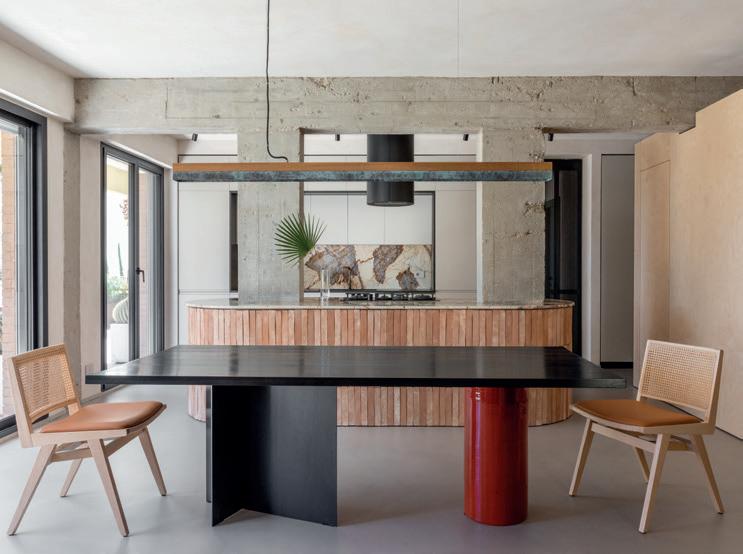


Casa Rude
The owners wanted “a bright, open house that emphasises the uniqueness - at times also imperfect - of the materials”. In the 120 square metre apartment with terrace, looking out onto the Natural Reserve of Castelporziano, the redesign therefore retains the imperfection for example of the exposed reinforced concrete of the columns and beams in the living room, but seeks a more curated and tailored approach in the combination of materials and making of a number of functional elements and bespoke furniture. The architects in fact underline “the desire to enhance the distinctive features of the unique building with terraces, dating back to the 1980s. We wanted to bring a sense of fluidity to the spaces, in favour of opening and rediscovering the existing materials and details, onto which to establish a new vision”. Like in the living room, a single open-planned space with unfinished walls and a continuous floor in resin that includes the entrance, living room, dining room and kitchen. Two key spatial and functional elements: the kitchen island clad in Fangorosa terracotta with worktop in Patagonia marble, that incorporates the reinforced concrete columns and a large multi-functional cube
in birch wood that conceals from view the larder, a cloakroom and a bookcase with TV. Also tailor made is the dining table, with a top in solid wood burnt using the Japanese technique of Shou sugi that stands on a cylindrical leg in ceramic and two sheets of raw metal, and the built-in sofa made to measure for the owners. The corridor to the sleeping area, consisting of two bedrooms and two bathrooms, is accessed through a pivot door in perforated sheet metal and is emphasised by the change in floor finish where with the Fangorosa terracotta used for the island in the living area reappears in a different format.
Location: Rome
Architecture: Studiotamat, Tommaso Amato, Matteo Soddu and Valentina Paiola
Lighting design: Fabio Silvestris
Furnishings: Livoni, Sculptures Jeux
Lighting: Aromas, Flos, GAN light, Ivela, Tooy
Bathrooms: Artceram, Cristina, Flaminia, Gessi
Claddings: Ariostea, Fangorosa, Marazzi
Partition between living room & studio: Mutina
Supplier: GruppoE Ceramiche Appia
Photos: Serena Eller Vainicher
April 2024 | 123

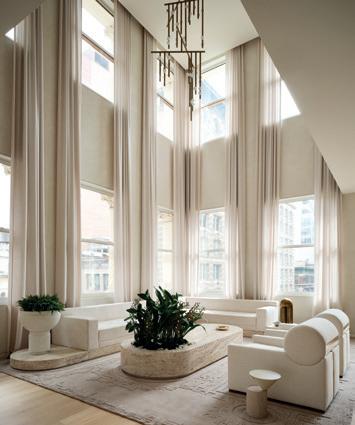
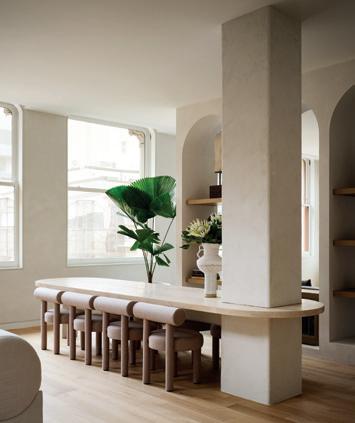
Tribeca Loft
The exterior setting is one of New York ex-industrial architecture, a textile factory dating back to 1881 with a traditional cast-iron structure, converted into a residential building in 2019 and designed by Shigeru Ban. The interior however is inspired, according to Timothy Godbold “by the surreal and glamorous aesthetic of cinema classics from the 1970s”, that in an atmosphere of full and velvety neutral tones combines gilded and mirrored surfaces, textile walls, full-height curtains and abstract and geometric forms. Like the arches that separate the two lounge areas, the bases of sofas and side tables, the large table for the dining room and the stucco decorations, overlaid and in relief on the walls, that transform the ‘white pages’ of the walls into textured tapestries. In the enormous ‘public’ area, the spaces have been reorganised for a comfortable family life without completely altering the overall layout in its original industrial function. The double height has been retained in a part of the living area, making the most of the windows and verticality with full-height
curtains while the existing load-bearing column have become a point of anchorage for the dining table, inspired by a rationalist model for industrial use from the 1930s by the Luckhardt brothers and Alfons Anker. Amid the design materials, a key role is also played by the objects and accessories such as vases, plant holders and designer tables as well as the works of art commissioned to Malcolm Hill and Etienne Moyat.
Location: New York
Interior design: Timothy Godbold
Furnishings and lighting: on design or selected
vintage and limited edition pieces
Photos: David Mitchell


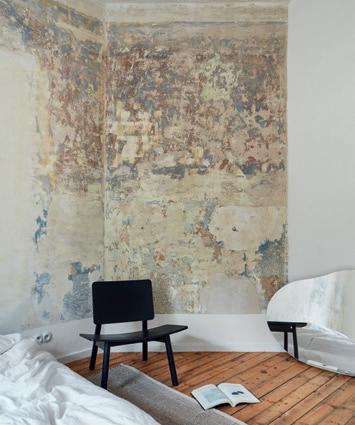
Karlovy Vary Apartment
In a residential building constructed in the last century, not far from the thermal baths for which the Czech city of Karlovy Vary is famous, this apartment had undergone many alterations over the years that had distorted the airy division of spaces, openings and original materials. The almost philological work of reconstruction by the architects started first and foremost with the total removal of structures, claddings and ceilings accumulated over time so as to restore freedom and equilibrium to the arrangement of the living spaces and the combination of the (few) materials. Leitmotiv and backdrop to the whole apartment is the original mural painting that extends across the walls and ceilings of all the rooms, now exposed to view and natural light, a vigorous but not intrusive material presence, with its decorations faded over time and palette that mixes reds and pinks. To which is added the most intangible design element: natural light that fills all the spaces - from the living room to the two bedrooms and the bathroom, also thanks to an internal ‘window’ cut into
the wall between the kitchen and the living room - and that gives consistency to both the colours and the white used as a visual counterpoint. The tiles and sanitary fittings in the bathroom are white as are many of the few furnishings chosen to contribute to the calm and serene atmosphere reinstated with this new design.
Location: Karlovy Vary, Czech Republic
Architecture: Plus One Architects, Kateřina
Průchová and Petra Ciencialová
Apartment styling and furniture: Janský & Dunděra; Archtiles, KLER, Cappellini, MCDJ, Todus, Dechem Studio Photos: Radek Úlehla
124 | April 2024 SPACES

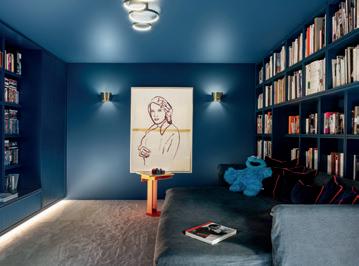
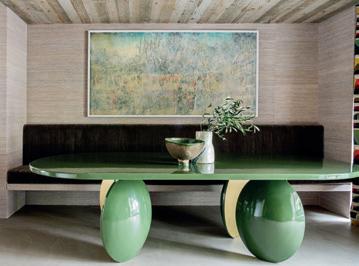
Zürich House
The aesthetics of the Brutalist architecture by Ernst Gisel, who built this three-story house overlooking the lake Zurich in the late 1980s, still remains much in evidence after the recent conversion of the interior spaces that leaves ‘exposed’ the rough grain of the concrete structure and raw colour in many places. Respecting the work of an architectural master, Victoria Maria decided to soften the coarse features of the domestic spaces with fine materials, metallic, glossy or textile, and imbue it with a contemporary feel with elements of surprise. Like the Roger table, tailor-made in bright green and lacquered, a sculptural element that immediately catches the eye in the light-filled, open-planned kitchen and dining space. Green also features in the worktop in Pyrolaye in the kitchen, a ‘void’ inside a system of storage that covers the whole wall, clad in polished brass that imitates a wood finish. Equally exquisite is the dark Spanish Emperador marble used for the island. The palette of soft and neutral colours, creamy pinky whites, ‘spread’ across
the walls, floors and cupboards, has been carefully calibrated to balance the ‘rough’ existing context and enhance the client’s many works of art. A palette however contradicted first by the bright green of the dining area, then by the deep blue of the lounge, where a full and even colour, relaxing and alienating at the same time, extends over the walls, bookcases, sofa but also onto the ‘fifth wall’ of the ceiling.
Location: Erlenbach, Zürich
House architecture: Ernst Gisel
Interior architecture: Victoria Maria
Furnishings: on design by Victoria Maria; B&B
Italia, Dornbracht, Fos, Ligne Roset, Maison de Vacances, New Tendency, Sara Regal Alonso, Vitra, Zanotta; selected vintage pieces
Lighting: Cirque, Gubi, Flos, Wilhelm Wagenfeld
Fabrics: Elitis, Pierre Frey
Floors: Texolit Rustico
Photos: Belen Imaz et Pedro Bermejo



Café House
The single family house is immersed in the landscape of the Brazilian region of Cerrado, one of the areas best known for the production of coffee, here considered not a mere beverage but a ritual carried out alone or in company, part of a lifestyle lived amidst natural surroundings. For the owners, passionate about the cultivation of coffee, the architects have sought an interpretation of the rural context, where red earth and knotted trunks predominate as do family routines. “Coffee is a drink strongly related to both land and air. In this sense, earth and air were great inspirations. Weight and lightness”. On the sloping site, that has remained unchanged and surrounded by lush vegetation, the design therefore materialises with two different construction elements, the perimeter walls in red-pigmented concrete (earth) and the curved roof elements in white concrete (air) that seem to float on the entire structure. The decisive materiality of the red walls is the same for the exteriors and interiors, in an anthropic space that seems to have emerged from the landscape to take over all the settings for domestic life, pub-
lic and private. “The earth walls guide the view”, say the architects, and the route between the two pavilions that make up the house, protected by two ‘veils’: higher up and completely open to the outside is the open-plan area that houses the dining room, living room and kitchen, lower and more enclosed is the private area with the bedrooms. In between the two blocks, the landscape and vegetation take possession of the ‘domesticated’ space in a terraced garden.
Location: Divinópolis, Minas Gerais, Brazil
Architecture: Tetro Architecture, Carlos Maia, Débora Mendes, Igor Macedo
Structural concrete design: MV Estruturas
Construction and design of electrical and hydraulic installations: Somar Engenharia
Landscape design: Nativa Paisagismo
Lighting: Iluminar
Steel doors: MA Inoxidáveis
Glasses: Cristal Vidros
Stones: Directa Pedras
Sofa and dining table: Tuoli Móveis
Curtains: Laiza Decorações
Photos: Luisa Lage
April 2024 | 125
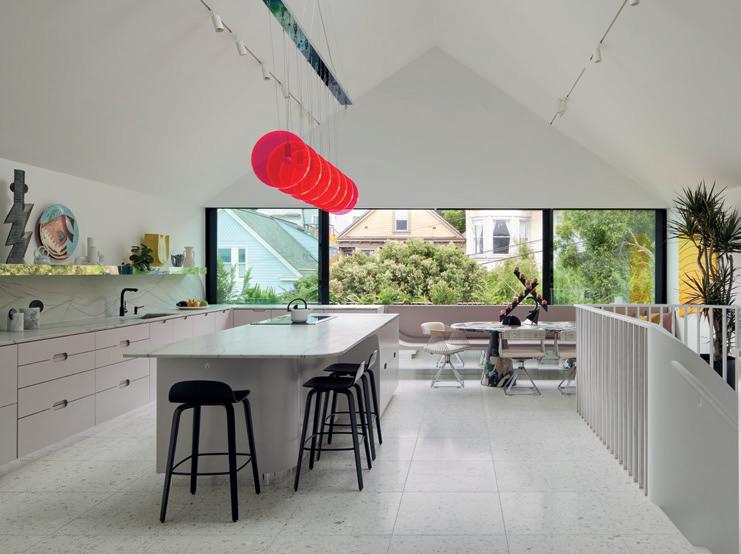


The Silver Lining House
Located in the Bernal Heights neighbourhood, the origins of this house go back over a century ago, the kind of timber-framed Edwardian-style dwelling typical of many residential areas in San Francisco. Damaged by a fire in 2017 it was redesigned by architects Mork Ulnes as a house that could be a “capsule of art and inspiration”, the perfect container and setting for the collection of designer furniture and artworks of the owners who have also curated the interiors, an organised system of objects. Spread on three floors connected by a sculptural and expressionist staircase, the building has facades clad in black wood, ribbon windows and terraces on different levels in a composition that alternates solids and voids. Inside, the spaces are white and bright, the ideal backdrop for composing a journey of everyday life but also an ‘exhibition gallery’ for vintage pieces, furniture and objects, as well as works of art. Each individual room, including the bathrooms, becomes a mass of colours, textures and patterns, with Art Deco, Mid-Centu-
ry Italian, Scandinavian, post-modern and contemporary furniture, and works by wellknown as well as emerging artists. Arranged on the three floors, from bottom to top, are the main bedroom and a small garden, then the entrance, guest room, lounge area, library and finally the spacious living room with kitchen and a large terrace.
Location: Bernal Heights, San Francisco
Architecture: Mork-Ulnes Architects
Interior design: Alison Damonte
Landscape architect: Terremoto
Lighting design: PritchardPeck
Cabinetmaker: Hopebuilt
Furnishings and lighting: selected vintage pieces
Photos: Bruce Damonte



Talbot Residence
The architectural context is one of semi-detached Edwardian houses in the Highgate area of London, one that the design of Black & Milk has left practically unchanged in order to concentrate on the transformation of the interiors that the owners wanted to be more sophisticated and comfortable, a style that the architects call cosy luxury. After having totally overhauled the design of the lighting of all the spaces with a mix of architectural and decorative lights, the spaces were reworked mixing vintage and contemporary furniture, strong colours and soft shades, rugs, fabrics and textures also contrasting, sophisticated patterns and finishes. An entrance corridor decorated with a floor in cementine with a multi-coloured star pattern separates two lounge areas on opposite sides with different atmospheres. “We saw this as an opportunity within the design to pay tribute to the traditional notions of a separate seating area and ‘His’ and ‘Her’ lounges were born”. While the lounge ‘for her’ is a natural but extrovert space featuring a black fireplace and some splashes of colour in the
fabrics of the chairs and the works of art on the walls, the room ‘for him’ is an introverted retreat painted blue, including the fireplace. Even more private is the cinema room where the protagonists are the fabrics, in the soft corner sofa, the rug and the tartan wall covering, a homage to the Scottish roots of the owners. Bright and opening onto the back garden is an open-planned area with kitchen, island, breakfast area and living room in which the brick finish of the walls creates the backdrop for an eclectic combination of furniture, woods, colours, fabrics and accessories.
Location: Highgate, London
Interior architecture, design and styling: Black & Milk
Furnishings: &tradtion, Arflex, Audo Copenhagen, Cassina, Dedar, Pinch, Tacchini, Vitra
Photos: courtesy of Black & Milk
126 | April 2024 SPACES



ADDRESS THE GLOBAL DESIGN
COMMUNITY
ON THE SAME ROOM
DAILY NEWS | TRENDS | PEOPLE | MARKETS

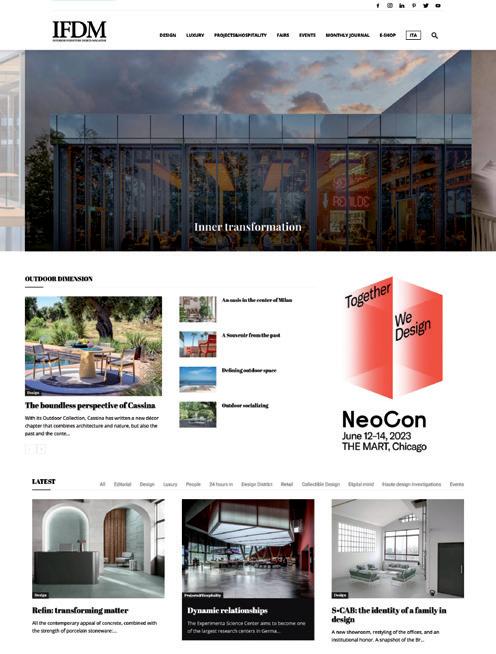
SUBSCRIBE TO THE NEWSLETTERS
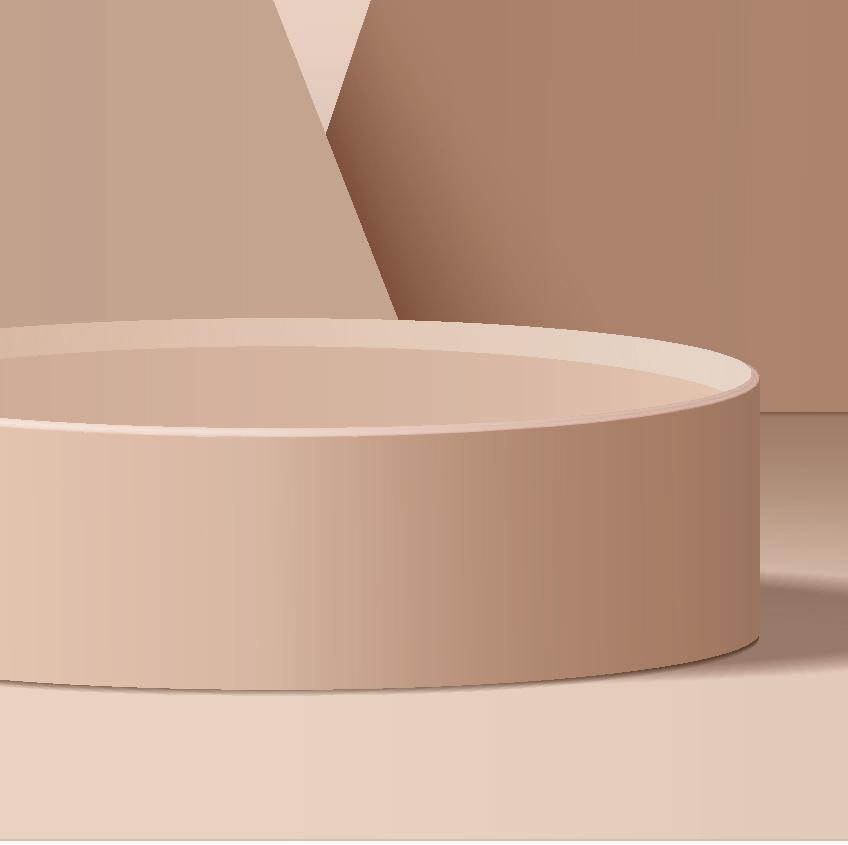


ifdm.design
Tailored. Business. Concierge.
The professional link for the design industry that encourage the attendance and knowledge of international markets with the vocation of supporting companies in expanding their network and embracing new opportunities. Thanks to its well-established presence in the Project&Hospitality field and deep experience in high-end furniture, IFDM Business Concierge department supports architects, interior designers, general contractors, buyers, developers and made-in-Italy producers in the different phases of their projects.
concierge@ifdm.it


130 PLACES
Global luxury retail experiences
132 AGENDA
Save the date. Follow IFDM at the world’s leading international trade fairs
WORLDWIDE
IL LUSSO, JOHANNESBURG
In South Africa – where, as some say, “crafts may be ancient, but design is young” – the focus on real estate and décor reaches new heights, as demonstrated by Design Joburg, the country’s most advanced event in the sector, scheduled for August this year.
So it should come as no surprise that Johannesburg is the city where Robert Marengo and Paco Pakdoust, in 2019, have opened Il Lusso, an enormous emporium of contemporary splendor – 5000 square meters on five levels – all with a rigorous accent on Made in Italy. Inside this building in glass and concrete designed by Paragon Group there is plenty of space for the leading Italian furniture makers, from Flexform to Paola Lenti, Giorgetti and B&B Italia.
“When you enter here, you have the impression of being on one of the streets in the center of Milan, strolling through the ‘real’ stores of these iconic brands,” as the magazine Objekt South Africa writes about Il Lusso.
Johannesburg is the second largest city in Africa, and it is by far the most wealthy: the total holdings of the almost 6 million inhabitants – about half of whom are under 24 years of age – reaches 239 billion dollars (Cape Town, the second in the ranks, has 131 billion). Sales in the luxury market are nearing the mark of 2 billion dollars per year.
According to Paco Pakdoust, who since 1997 also produces beautiful handmade carpets (Paco Rugs), “the companies in this retail setting have been carefully selected to represent the best in Italian luxury design, with its strong points of quality and tradition.”
Besides the many outstanding brands, Il Lusso Italia has recently expanded its (already) precious collection with outdoor furniture by Exteta, the refinement of solutions for the bathroom by Salvatori, and the artisanal fragrances of Locherber Milano.
“Il Lusso will remain the finest experience of design in South Africa for years to come, and it is clearly the place all design lovers ought to visit,” the magazine Objekt remarks.
1
Global luxury retail experiences
In this exploration, we delve into the distinct worlds of two premier luxury retail experiences: Johannesburg’s Il Lusso, with its Italian-centric paradigm, and Shanghai’s Design Republic, a unique fusion of Eastern and Western aesthetics, conceived by renowned architects Lyndon Neri and Rossana Hu
by Raffaella Serini

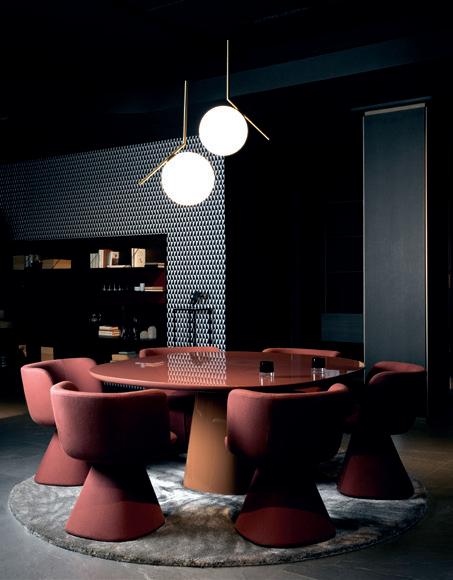

130 | April 2024 PLACES
1 2
luxury
decorated living space, furnished
carefully selected pieces from the renowned furniture brand
space
chic dining table
chairs, both products
Italian furniture brand,
distinctive feature of the showroom’s architectural layout, this grand central staircase lends an impressive feeling of grandeur to the retail space. 3
. Interiors of the
showroom in Johannesburg: a tastefully
with
Vitra. 2. The
features a
and
of the
B&B Italia. 3. A
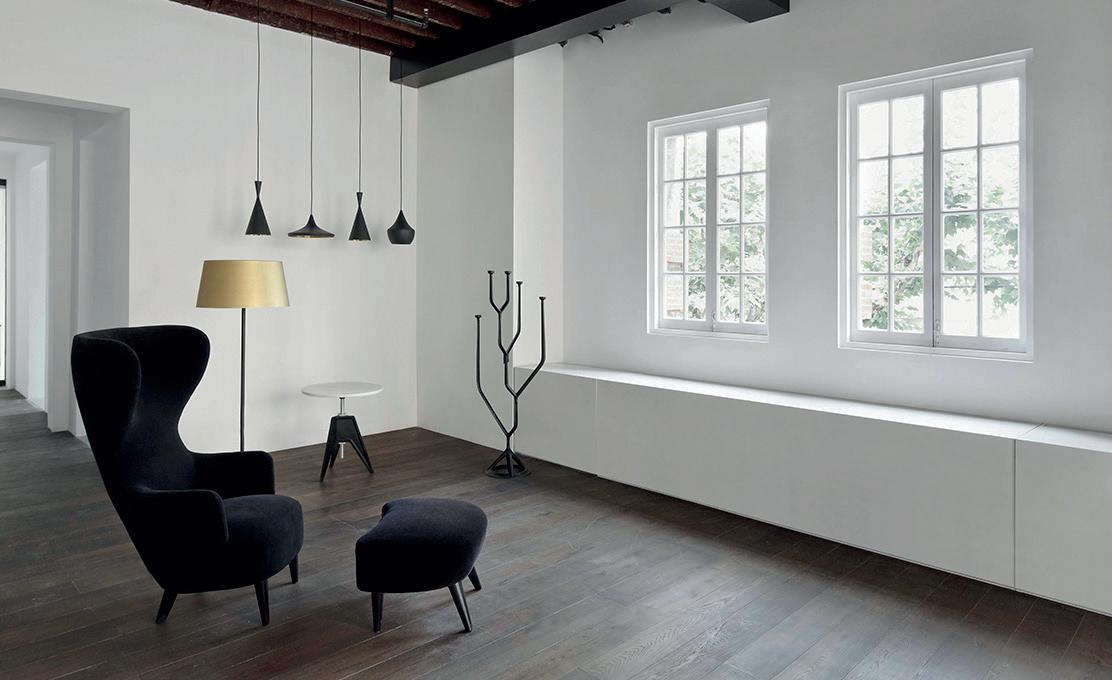
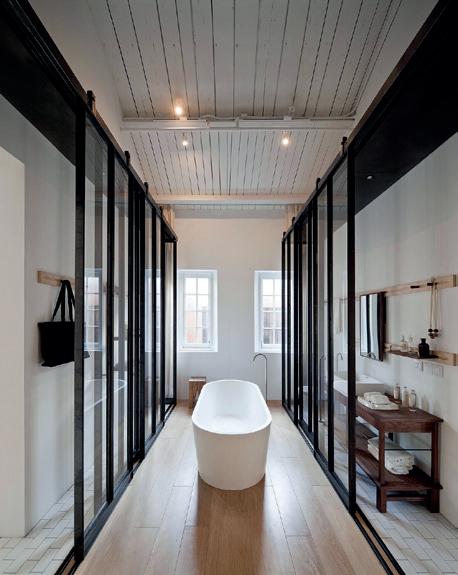
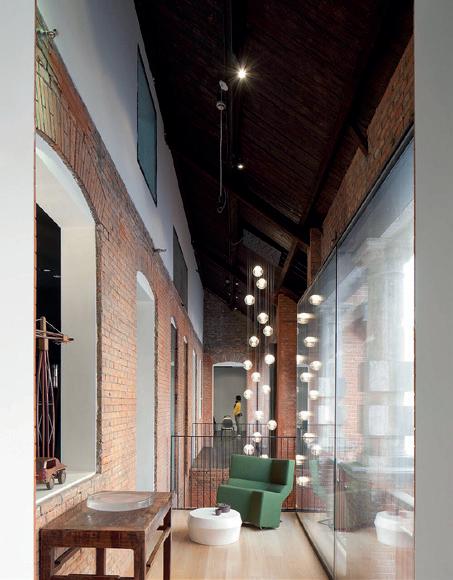

DESIGN REPUBLIC, SHANGHAI
“We are a republic of design, guiding an urban revolt to achieve elegance, relevance and meaning.” The statement in the manifesto of Lyndon Neri and Rossana Hu, respectively from the Philippines and Taiwan, founders of the architecture firm Neri&Hu with headquarters in China, is a tall order. Designers of the Year for Maison&Objet Asia, in 2015 they were inserted in the Interior Design Hall of Fame in the United States in 2013. They are the founders, in 2004, of Design Republic, a concept store based in Shanghai that offers a unique collection of products created by the most outstanding talents of worldwide design. Many of the items have been made available to consumers in China for the first time. After more than 15 years devoted to the creation and development of products for prestigious European and Asian brands, including Artemide, Molteni&C, Poltrona Frau and Stellar Works, Neri&Hu have shifted their know-how into a design company, “in pursuit of poetry and meaning through the exchange of ideas, objects and discussions, across our multiple platforms of creative business.”
They have therefore salvaged and renovated a historic colonial building in the Jing’an district, restoring memory and bringing new life to the location as a design hub that translates the encounter between East and West into architecture. In 2400 sqm of space, they have combined a store for premium objects and furnishings, including Italian exhibitors – from Alessi to Flos to Matteograssi – with a design gallery for the collections of the Neri&Hu brand, an events space, a café and a small one-room guesthouse.
“The ‘actors’ on this stage are furnishings, accessories, books, fashion pieces, lights and flowers, to bring back from our travels the sense of discovery of differences, experimentation, the care for spaces that covers materials, details, fragrances and readings,” Neri & Hu say. The goal?
“To demonstrate what the world of design can offer to China, and to show what China can offer to the world.”
4. The architects envisioned a new exterior identity by draping over the existing building, while simultaneously crafting an introverted spatial platform to carve out a fresh identity for the Design Republic’s Design Collective. 5-7. More than just architectural elements, the new essential transparent glass partitions offer continuous vistas and relationships between spaces. These rhythmically arranged partitions allow light to abundantly diffuse into every corner of the building’s three levels. 6. Furniture pieces and glass pendant lamps descending from the rough-hewn ceiling contribute to the distinctive aesthetic while complementing the raw character of the constructed environment.
April 2024 | 131 4 5 7
6
SAVE THE DATE
Follow IFDM at the world’s leading international trade fairs
APRIL
BRERA DESIGN WEEK
April 15-21, 2024
Milan (Italy) https://breradesignweek.it
FUORISALONE
April 15-21, 2024 Milan (Italy) www.fuorisalone.it
ISOLA DESIGN FESTIVAL
April 15-21, 2024 Milan (Italy) https://isola.design
PORTA VENEZIA DESIGN DISTRICT
April 15-21, 2024
Milan (Italy) www.portaveneziadesigndistrict.com
SALONE DEL MOBILE MILANO
April 16-21, 2024 Milan (Italy) www.salonemilano.it
HD EXPO + CONFERENCE
April 30 - May 2, 2024
Las Vegas (USA) https://hdexpo.hospitalitydesign.com
MAY
NYCXDESIGN
May 16-23, 2024
New York City (USA) www.nycxdesign.com
ICFF
May 19-21, 2024
New York City (USA) https://icff.com/
WANTED DESIGN
May 19-21, 2024
New York City (USA) www.wanteddesignnyc.com
CLERKENWELL DESIGN WEEK
May 21-23, 2024
London (United Kingdom) www.clerkenwelldesignweek.com
DESIGN LONDON
May 21-23, 2024
London (United Kingdom) www.designlondon.co.uk
JUNE
SAN FRANCISCO DESIGN WEEK
June 3-12, 2024
San Francisco (USA) https://sfdesignweek.org
CRUISE SHIP INTERIORS DESIGN
EXPO AMERICAS
June 6-7, 2024
Miami (USA) https://cruiseshipinteriors-expo.com
NEOCON
June 10-12, 2024
Chicago (USA) https://neocon.com
3DAYSOFDESIGN
June 12-14, 2024
Copenhagen (Denmark) www.3daysofdesign.dk
DESIGN SHANGHAI
June 19-22, 2024
Shanghai (China) www.designshanghai.com
SUSTAINABLE DESIGN CHINA SUMMIT
June 19-22, 2024
Shanghai (China) www.sustainabledesignchina.com
SEPTEMBER
MAISON&OBJET
September 5-9, 2024
Paris (France) www.maison-objet.com
FURNITURE CHINA
September 10-13, 2024
Shanghai (China) www.furniture-china.cn
CANNES YACHTING FESTIVAL
September 10-15, 2024
Cannes (France) www.cannesyachtingfestival.com
LONDON DESIGN FESTIVAL
September 14-22, 2024
London (United Kingdom) www.londondesignfestival.com
SALONE NAUTICO
September 19-24, 2024
Genova (Italy) https://salonenautico.com
CERSAIE
September 23-27, 2024
Bologna (Italy) www.cersaie.it
MONACO YACHT SHOW
September 25-28, 2024
Monaco (France) www.monacoyachtshow.com
FIND
September 26-28, 2024
Singapore www.designfairasia.com
FERIA HÁBITAT VALÈNCIA
September 30 - October 3, 2024
Valencia (Spain) www.feriahabitatvalencia.com
OCTOBER
SIA HOSPITALITY DESIGN
October 12-14, 2024 Rimini (Italy) www.siaexpo.it
EDIT NAPOLI
October 11-13, 202420
Naples (Italy) https://editnapoli.com
ORGATEC
October 22-25, 2024 Cologne (Germany) www.orgatec.com
FORT LAUDERDALE INTERNATIONAL BOAT SHOW
October 30 - November 3, 2024 Fort Lauderdale (USA) www.flibs.com
NOVEMBER
BRUSSELS FURNITURE FAIR
November 3-6, 2024 Brussels (Belgium) www.furniturefairbrussels.be
EQUIP’HOTEL
November 3-7, 2024 Paris (France) www.equiphotel.com
DUBAI DESIGN WEEK
November 5-10, 2024 Dubai (United Arab Emirates) www.dubaidesignweek.ae
DOWNTOWN DESIGN
November 6-9, 2024
Dubai (United Arab Emirates) www.downtowndesign.com
BDNY
November 10-11, 2024 New York City (USA) https://bdny.com
DECEMBER
DESIGN MIAMI
December 3-8, 2024
Miami (USA) www.designmiami.com
CRUISE SHIP INTERIORS DESIGN EXPO EUROPE
December 4-5, 2024
London (United Kingdom) https://cruiseshipinteriors-europe.com
ART BASEL
December 6-8, 2024
Miami Beach (USA) www.artbasel.com/miami-beach
JANUARY
IMM COLOGNE
January 12-16, 2025 Cologne (Germany) www.koelnmesse.it/imm
MAISON&OBJET
January 16-20, 2025 Paris (France) www.maison-objet.com
BOOT DÜSSELDORF
January 18-26, 2025 Düsseldorf (Germany) www.boot.com
FEBRUARY
STOCKHOLM FURNITURE FAIR
February 4-8, 2025 Stockholm (Sweden) www.stockholmfurniturefair.se
AMBIENTE
February 7-11, 2025 Frankfurt (Germany) https://ambiente.messefrankfurt.com
MIAMI INTERNATIONAL BOAT SHOW February 12-16, 2025 Miami (USA) www.miamiboatshow.com
MARCH
MIPIM
March 11-14, 2025
Cannes (France) www.mipim.com
OCTOBER
HOSTMILANO
October 17-21, 2025
Milan https://host.fieramilano.it
132 | April 2024 AGENDA Stay updated on IFDM.design

































June 10–12 2024 THE MART Chicago neocon.com NeoCon ® is a registered trademark of Merchandise Mart Properties, Inc.
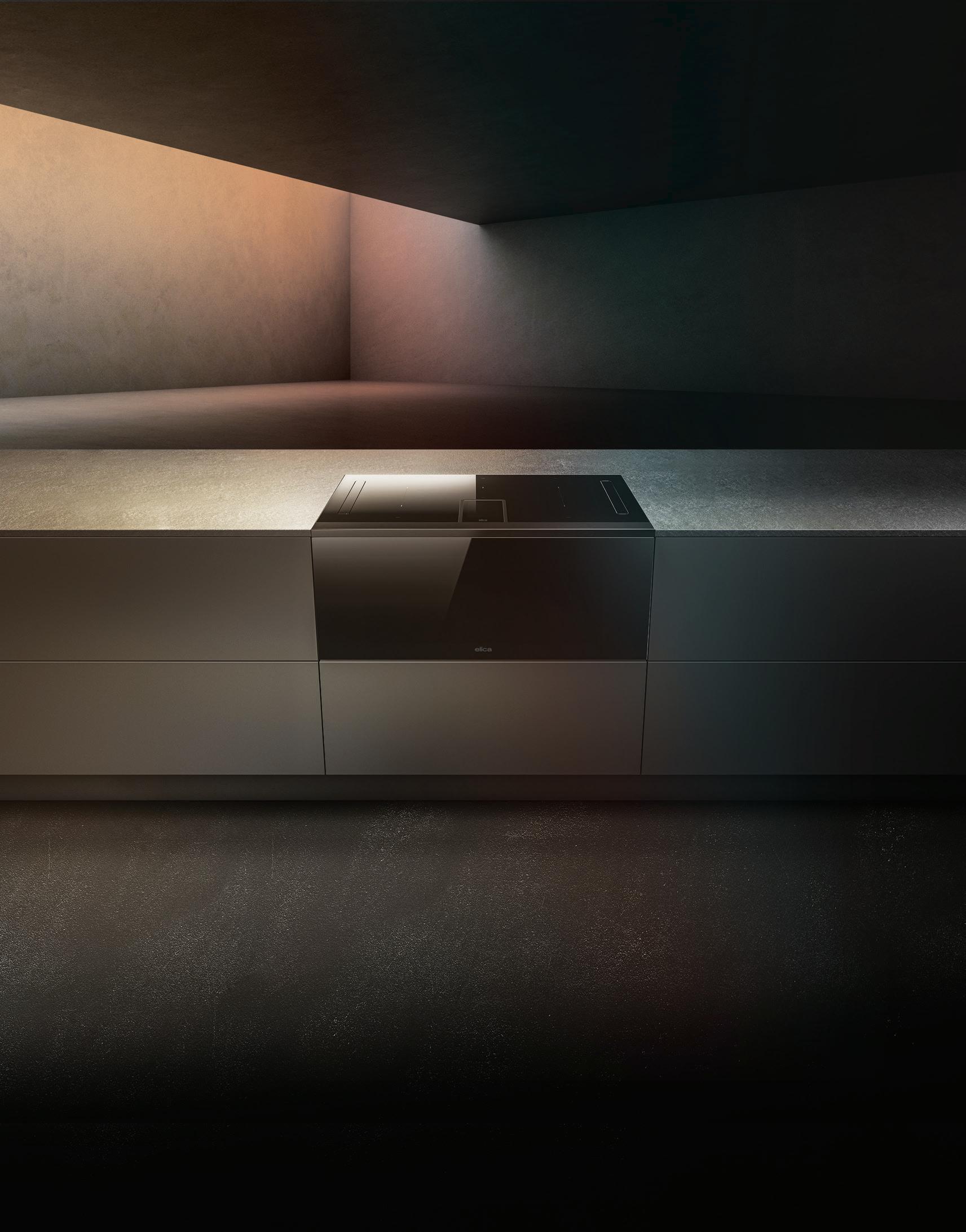














 Essenzia sideboard | Omega mirror | Ramy lamp | Techwall bookcase | Meghan armchairs | Ring coffee tables
Essenzia sideboard | Omega mirror | Ramy lamp | Techwall bookcase | Meghan armchairs | Ring coffee tables








 D.154.2 ARMCHAIR GIO PONTI
D.154.2 ARMCHAIR GIO PONTI



































































































































































































































































































































































































































































































